Charles Gould Moore
THE FIRST MARINE DIVISION AT CAPE GLOUCESTER & PELELIU
People back home will wonder why you can't forget.
- Eugene B. Sledge, With the Old Breed

Charles Gould Moore, age 19, my father, enlisted in the US Marine Corps on November 16, 1942 in Denver, Colorado. Upon completion of basic and specialty training, he joined the 11th Marines, 1st Marine Division. While he was with the 11th Marines (an artillery regiment), he participated in major actions against Japanese forces at Cape Gloucester, New Britain, Territory of New Guinea and at Peleliu, Palau Islands as part of the "island-hopping" campaign in the Pacific.
My dad, like many who experienced the chaos and bloodshed of combat in World War II, spoke very little about his experiences in the war. Regretfully, being involved in the normal trials and tribulations of my own life, I never took the time sit down with him and learn more about that period in his life before he passed away in 2001. I knew that he had been attached to the First Marine Division and that he had participated in the Battle of Peleliu. I had done some reading and I knew that Peleliu was considered to be one of the most brutal and bloody battles in the Pacific theater but I knew little about the details of his participation.
Even though I will never be able to hear his personal rendition of the experience, I have tried to fill some of that gap for the purposes of this website by researching and reading sources available in the public domain. I have also obtained his Official Military Personnel File (OMPF) from the National Personnel Records Center in St Louis MO. I highly recommend this source for anyone who wants to learn more about family members who served in World War II.
One other significant source of information about my dad's World War II experience is the pictures and documents collected by mom from his time in the Marine Corps. Before she passed away, she served the as de facto genealogist for our family and spent much time and effort compiling albums of the experiences of my dad and two of her brothers during the war. The album she created for my dad can be viewed below.
In keeping with the naming convention I have used for the other World War II (WWII) participants I have documented in this website, from here on down, for the most part, I will refer to my dad as "Chuck", which is the name he went by on an everyday basis.
Enlistment in the United States Marine Corps
After Pearl Harbor and upon graduation from high school, Charles Gould Moore felt compelled to serve his country and enlist in the military. He chose the US Marine Corps. The legal age for enlistment was eighteen, but it was common for younger volunteers to lie about their age. Although he was nineteen when he enlisted, he still required a consent form from his parents which in part provided a sworn verification of his birth date (Figure 1).
He was not alone in making this choice, Pearl Harbor motivated thousands of young Americans to join the military:
But first came the new men. All the tenets of discipline, the symbols of an elite corps, would be utterly strange to them. These new men would have to exceed themselves for so quickly taking the title: United States Marine. The NCOs went to work on the new men who would have to be tested even more harshly, to prove themselves worthy of the Corps' first and finest fighting unit.
An officer, who had to do with personnel at the time, says: "They were a strange breed, this bunch that came busting in after Pearl Harbor. Many of them, we discovered, were officer caliber, and could have easily gained that rank if they hadn't volunteered. There's no doubt about it but they wanted to fight. If we resented them at New River ... well, we learned better at the 'Canal."
Source: 'THE OLD BREED: A History of the First Marine Division In World War II'The United States Marine Corps

The history of the Marine Corps goes back a long time. According to folklore, the first Marine was recruited in Philadelphia at Tun Tavern in 1775 under a mandate from the Continental Congress to raise "two battalions of Marines" to serve as landing forces in the Continental Navy. Although the Marines were disbanded in 1783 after American independence was achieved, conflict with Revolutionary France in the following decade led the US Congress to formally establish the US Navy in 1798, and the US Marine Corps as a permanent force under the jurisdiction of the Department of the Navy.
Since their establishment, and up to WWII, the Marines had fought in all US wars, from the Barbary War ("shores of Tripoli"), to the Mexican-American War ("halls of Montezuma"), to World War I and all the wars in between. In most cases the Marines have been first to fight, and they have executed more then 300 amphibious landings on foreign shores since their formal establishment.
Prior to WWII, the greatest expansion of the Marine Corps occurred in World War I (WWI) as a part of the American Expeditionary Force under General Pershing. Total officer and enlisted strength went from 13,725 to 72,400 personnel. Between WWI and WWII many officers envisioned the possibility of a war in the Pacific against Japan. Under Marine Corps Commandant John A. Lejeune, emphasis began to be placed on improvement of amphibious operations needed for such a conflict, including development of better techniques, acquisition of amphibious equipment, and joint exercises with the Army. By 1945, 485,000 personnel were serving in the Regular and Reserve Marine Corps.
The First Marine Division

The 1st Marine Division shoulder patch originally was authorized for wear by members of units who served with or were attached to the Division in the Pacific in World War II; it was the first patch to be approved in that war and specifically commemorated the division's sacrifices and victory in the Battle for Guadalcanal. It features the National Colors - red, white, and blue - in its diamond-shaped blue background with red numeral "1" inscribed with white lettering, "GUADALCANAL." The white stars featured on the night-sky blue background are in the arrangement of the Southern Cross constellation, under which the Guadalcanal fighting took place. Source: MARINES: The Offical Website of the United States Marine Corps
The nickname for the First Marine Division is "The Old Breed". Near as I can tell, the nickname came from an observation made by then 1st LT John W. Thomason, Jr., USMC, after he arrived in France during World War I as a member of the 4th Marine Brigade of the 5th Marines, part of the 2nd Divison, American Expeditionary Forces. After taking stock of his raw new platoon, he later wrote,
"there were also a number of diverse people who ran curiously to type, with drilled shoulders and a bone-deep sunburn, and a tolerant scorn of nearly everything on earth. Their speech was flavored with navy words, and … in easy hours their talk ran from the Tartar Wall beyond Peking to the Southern Islands, down under Manila. … Rifles were high and holy things to them, and they knew five-inch broadside guns. They talked patronizingly of the war, and were concerned about rations. They were the Leathernecks, the Old Timers … the old breed of American regular, regarding the service as home and war as an occupation; and they transmitted their temper and character and view-point to the high-hearted volunteer mass which filled the ranks of the Marine Brigade."
Source: The United States World War One Centennial CommissionThe precursor to the First Marine Division was the 1st Advance Base Brigade. The unit was activated on December 23, 1913 at Philadelphia, Pennsylvania and was re-designated a number of times, finally settling on the 1st Marine Brigade. Between April 1914 and August 1934, elements of the Brigade were deployed to Mexico, Haiti, the Dominican Republic, and Cuba and received campaign credit for service in each nation. The brigade's participation in WWI warranted award of the World War 1 Victory Medal Streamer. In its final form the Brigade was comprised of the 1st and 2nd regiments and, on the cusp of WWII in October 1940, was deployed to Guantanamo Bay, Cuba.
During its existence, and particularly in exercises conducted in the Caribbean in 1940/41, the First Brigade honed the amphibious techniques and equipment that later contributed immensely to the Pacific operations that would be carried out during the oncoming war. Their development and testing of the Higgins landing boat resulted in recommending mass production of the Higgins in the latter part of 1940. By the end of their stay in Guantanamo, they were declared to be "the best amphibious fighters in the world."
The First Marine Division was activated from First Brigade on board the USS Texas on February 1, 1941. There is no record that any ceremony was held and the old hands aboard simply went about their business as before but under a new name.
The FIRST MARINE DIVISION was old before its time.
No use to look in its history for the helplessness of childhood, the misadventures of youth, the respectability of middle age. It was always a crotchety, cantankerous, prideful and intolerant, but wise and fearless, old man.
The First was born with a beard. Like Minerva, an ancient goddess, the First leaped forth from the brain of the Marine Corps "mature and in complete armor" -- mature in the deep folkways of an elite military body, armored with amphibious science its stubborn, aristocratic parent had made a specialty.
Source: 'THE OLD BREED: A History of the First Marine Division In World War II'Initially, the First Division was comprised of three regiments constructed by forming the 5th Marines out of the First Brigade, splitting a portion of the 5th off to form the 7th Marines, and then building the 1st Marines from portions of the 5th and 7th. The ability to do this sort of dividing was enabled by calling up Marine Corps reserves in the fall of 1940. The 11th Marines was added a month later on March 1, 1941.
The 11th Marines

Prior to joining the First Marine Division, the 11th Marines had a history extending back to World War I. The 11th Regiment was an outgrowth of the Mobile Artillery Force and was activated as as artillery regiment on January 3, 1918. At that point in the war, more infantry men were needed in France and, at the request of Headquarters Marine Corps, the Commandant of the Marine Corps granted permission to convert the 11th into an infantry unit. On September 5, 1918, after intensive infantry training in the summer of 1918, the 11th Regiment Joined the 5th Marine Brigade.
By November 2, 1918, the 11th Marine was present and organizing in Tours, France. On November 11, the armistice was signed and the war was over. Having seen no combat, the Marines of the 11th were disbursed throughout France to perform post-war administrative duties. Nine months later, on July 29th, the 11th was headed home embarked on the USS Orizaba. After disembarking at Hampton Roads, Virginia on August 6th, the 11th was deactivated there on August 11th.
The 11th Regiment was once again reactivated in 1927 when unrest in Nicaragua involving US citizens prompted Washington to send in the Marines. The 11th arrived in Nicaragua on May 22, 1927 as part of the 2nd Marine Brigade. The mission of the 2nd Brigade was to help resolve a dispute between the conservative government (backed by the US) and revolutionaries looking to overthrow it. A peace plan between these two entities was agreed to in April, 1927. Called the "Peace of Tipitapa", one of the requirements was that American forces were to stay in Nicaragua to enforce the provisions of the agreement and to supervise subsequent elections.
Enforcement of the Tipitapa agreement proved to be a significant challenge, primarily because the most powerful leader among the revolutionary guerrillas refused to accept its terms. After two years of struggle, including constant jungle patrolling and conflict with the revolutionary forces and sympathetic Nicaraguan peasants, supervision of elections threatened by terrorism, and training of the Guardia Nacional to eventually take over treaty enforcement, conditions in the country were deemed stable enough to begin extracting Marines. In August of 1929, the last of the 11th regiment left Nicaragua and the 11th was deactivated on August 31 en route to Marine Barracks, Quantico.
As with the experience gained by the 1st Advanced Base Brigade, no doubt institutional knowledge was gained by the 11th's experience in Nicaragua that was carried over when the unit was reconstituted as part of the First Marine Division. Of particular note were techniques developed during jungle warfare in opposition to the Nicaraguan revolutionaries. One of the prominent carriers of such information would have been General Alexander Archer Vandegrift who, as a young officer, served in Nicaragua in 1912/13 and would later become the first Division Commander of the First Marine Division at the start of WW II.
After disbanding in 1929, the 11th Regiment disappeared for over a decade. It did not return until, the Marine Corps, living up to its reputation as a force in readiness, began to greatly increase its strength in 1940. On 1 September 1940, the 1st Battalion, 11th Marines, lst Marine Brigade, FMF [Fleet Marine Force] was organized at Marine Barracks, Quantico. On 10 October, 1/11 left Quantico and sailed to Guantanamo Bay, Cuba, arriving there on 21 October. On 1 January 1941, 2/11 was activated at Guantanamo, and, three weeks later, on 23 January, 3/11 was organized there. On 1 February, the 1st Marine Brigade was officially re-designated as the 1st Marine Division, and, on 1 March, Headquarters and Service Battery, 11th Marines, Colonel Pedro A. del Valle commanding, was activated in Cuba. The organization of the 11th Marines was then complete, although two more battalions were added at various times later.
The 11th Marines had now become the artillery regiment of the 1st Marine Division. From 1940 to the present, this has been its role. There were a few scattered instances when units of the 11th were used as infantry for short periods of time, but the 11th was no longer an infantry regiment as it had been in World War I and Nicaragua. At Guantanamo Bay, the 11th began its artillery training, starting with 75mm pack howitzers, which were used by 1/11 throughout the war and by 2/11 for most of the war. The 3d Battalion used 105mm howitzers at Guadalcanal and afterwards.
Source: A Brief History of the 11th MarinesA fourth battalion (105mm howitzer) was added to the 11th on October 22, 1941 at Parris Island. The scattered units of the 11th were all assembled, along with the rest of the 1st Marine Division, at New River, North Carolina in January, 1942 where they underwent combat training until June, 1942. A 5th Battalion (105mm howitzer) was added prior to the 11th mobilizing to San Francisco on June 14. On June 22, the 11th, along with the rest of the First Division departed San Francisco and sailed for Wellington, New Zealand where the First Division would soon receive orders to conduct an amphibious operation against the Japanese at Guadalcanal.
Note: A Brief History of the 11th Marines indicates that a 5th Battalion was added to the 11th Marines prior to June 14, 1942. However, the Command Organization for the Battle of Guadalcanal (August 7, 1942 to February 9, 1943) provided in 'THE OLD BREED: A History of the First Marine Division In World War II' does not list a 5th Battalion for the 11th Marines, but it does list "11th Marines (less 1st,2d,3d, & 4th Btns)" as a Support Group under Col. Pedro A. delValle, the acting Commander of the 11th at Guadalcanal. The Wikipedia entry for Battle of Guadalcanal order of battle does list a 5/11 commanded by Lt. Col. E. Hayden Price. The Wikipedia entry for 3rd Battalion, 11th Marines indicates that 3/11 participated in Guadalcanal but states that the "3rd Battalion 11th Marines was activated 1 May 1943 at Victoria, Australia as the 5th Battalion, 11th Marines, 1st Marine Division, Fleet Marine Force. The Battalion was re-designated 3rd Battalion, 11th Marines on 7 May 1944." The activation date of 1 May 1943 is after Guadalcanal but before Cape Gloucester. The re-designation (from 5/11 to 3/11) is after Cape Gloucester but before Peleliu. So, was there a 5/11 at Guadalcanal? If so, perhaps it is listed in THE OLD BREED as the 11th Marines' Support Group member.
Finally, THE OLD BREED lists a 3/11 and 5/11 for the Cape Gloucester Command Organization, and a 3/11, but no 5/11, for the Peleliu Command Organization. This corresponds to Chuck Moore's personnel record which documents that he joined the 5/11 prior to Cape Gloucester and the 5/11 became the 3/11 after Cape Gloucester and before Peleliu.
Chuck Moore's Job Description With the 11th Marines
In order to best understand the nature of Chuck Moore's participation in the events of the war, it was necessary to have an understanding of what specialty training he received and what his job description was within the unit he served with. The best source of that information proved to be his personnel file (OMPF).
He attended basic training (boot camp) with the 8th Recruit Battalion at the Marine Corps Recruit Depot (MCRD) in San Diego California from November 18, 1942 to January 8, 1943, the standard 7-week period that was in place at that time:
After completing basic training, newly minted Marines were given their forward assignments. Eugene B. Sledge, in his excellent chronicle WITH THE OLD BREED at Peleliu and Okinawa, explained the process as it was for him at the MCRD, on December 25, 1943:
Before dawn the next day, Platoon 984 assembled in the front of the huts for the last time. We shouldered our seabags, slung our rifles, and struggled down to a warehouse where a line of trucks was parked. Corporal Doherty told us that each man was to report to the designated truck as his name was called out. The few men selected to train as specialists (radar technicians, aircraft mechanics, etc.) were to turn in their rifles, bayonets, and cartridge belts.
As the men moved out of the ranks, there were quiet remarks of, "So long, see you, take it easy." We knew that many friendships were ending right there. Doherty called out, "Eugene B. Sledge, 534559, full individual equipment and M1 rifle, infantry, Camp Elliott."
Most of us were infantry and we went to Camp Elliot or Camp Pendleton. As we helped each other aboard the trucks, it never occurred to us why so many were being assigned to infantry. We were destined to take the places of the ever mounting numbers of casualties in the rifle or line companies in the Pacific. We were fated to fight the war first hand. We were cannon fodder.
When Chuck Moore graduated almost exactly one year before Sledge, he was, from Sledge's point of view as expressed in the above quote, one of the lucky ones selected for specialist training and not a member of the infantry "cannon fodder". But as it turned out, both Eugene Sledge (Company K, 3rd Battalion, 5th Marines) and Chuck Moore landed on the beaches at Peleliu on the same day and were exposed to same Japanese "cannon". The difference was that Chuck Moore had to experience Cape Gloucester before Peleliu and Eugene Sledge had to endure Okinawa after Peleliu. (Not to ascribe any special meaning, but I was startled to find out that Eugene Sledge passed away on the same day as my dad, March 3, 2001.)
As the war progressed from December 7, 1941, the growing complexity of the Marine amphibious operations caused the need for additional specialist training to go from acute to chronic. At the beginning of the war the existing selection process for specialty training was inadequate as evidenced by attrition rates of 30 percent or more in many of the specialty classes:
At the outset of the war, the Marine Corps had in effect a selection system based on three criteria: education, previous experience, and aptitude. Of the three, only the first could be measured objectively. A definite level of academic achievement was often stated as a prerequisite for certain courses, e.g., two years of high school, four years of high school, or perhaps two years of college. The candidate might also be required to have completed certain courses, e.g., high school mathematics, physics, etc. There was no objective measurement of the other two requirements.
A man might be required to state that he had been a carpenter or auto mechanic in civilian life, but he was not obliged to prove his ability by any sort of test. Where aptitude was a prerequisite, the judgment of the commanding officers was employed to advantage in cases where students were selected from organized units. A subjective measurement of aptitude for a large number of men just completing recruit training, however, was of little value.
One exception to the general rule was communications training. Written examinations in mathematics, spelling, code, tone perception, and general intelligence were required.
Source: Marine Corps Ground Training in WWIIBy the time Chuck Moore entered basic training, approximately 40 percent of recruits were being designated for further training in formal specialist schools. Starting in October of 1942 a new and improved selection process had been adopted from a scheme that the US Army already had in place. Testing of the new process showed it to be an outstanding success as it cut the average rate of academic failures from 40 to 5 per cent.
Chuck Moore benefited from this process and from the fact that prior to enlisting he had graduated from high school, had taken a number of technical and mathematical courses at Denver University, and was taking engineering courses through the International Correspondence School (ICS). During World War II, ICS was given the War Department contract to develop the department's training manuals.
After basic training, Chuck was selected for communication school. The communications training program was conducted by the 2nd Signal Company. Located at San Diego, the company conducted elementary radio operator and field telephone courses. The mission of these schools was to provide personnel for the Fleet Marine Force (FMF) trained in the setting-up, operation, and maintenance of radio and telephone systems in the field.
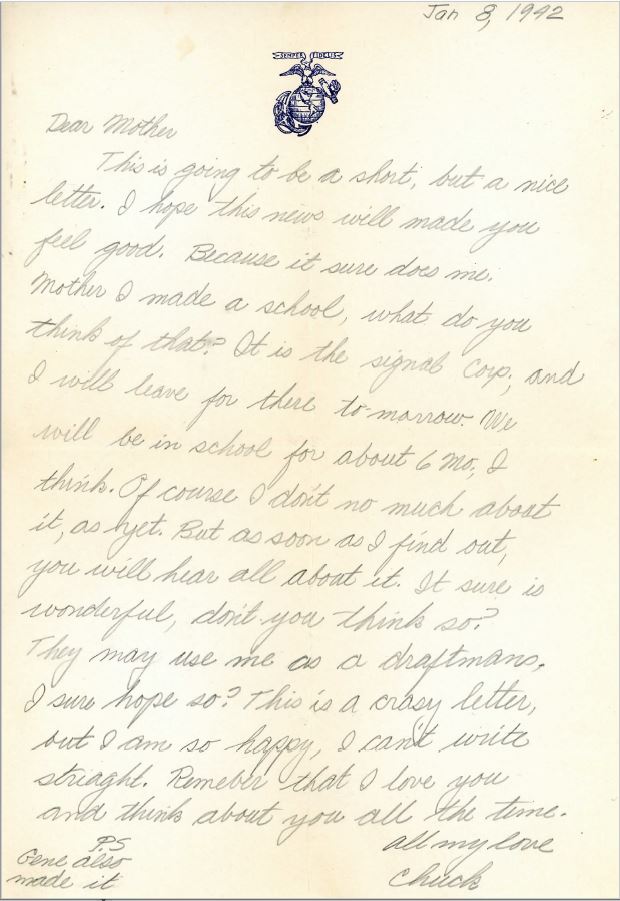
As expressed in the above letter, Chuck was thrilled about being selected for a school and was certain his parents would be as well, but for different reasons. The extra schooling he received and the correspondence courses he had been taking after high school were aimed at his becoming a draftsman and later an engineer (which indeed happened). So, being selected for a school gave him hope that he might be learning and performing a skill related to that ambition. His parents, on the other hand, were hoping that specialty training would lead to an assignment at an established Marine base rather than in a combat zone. Neither he nor his parents quite got what they were hoping for.
Field telephone men pursued a course of six weeks. This corresponds well with Chuck Moore's service record which indicates that he was assigned to the "Hdqtrs. Co. Signal Bn." on January 7, 1943, reassigned to the "Telephone Co. Signal Bn" on January 16, 1943, and completed his course work (listed in his separation record as "Fld Tel. Lineman and Switchboard 41.1") by February 26, 1943.
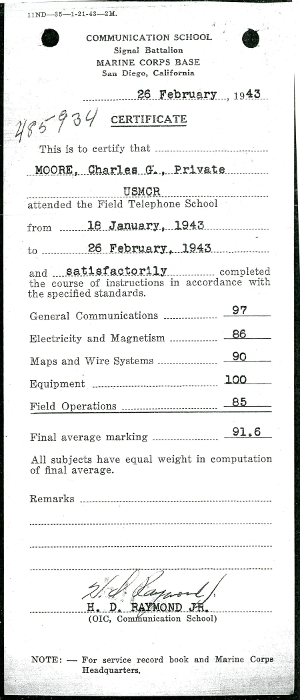
His next assignment was to "Hdqtrs & Service Battery, Artillery Battalion, Training Center, Camp Pendleton, Oceanside, CA" on February 27, 1943. The specific training that he received at the Artillery Battalion Training Center is not indicated, but after about a 6-week period he graduated and joined the "16th Replacement Bn, FMF" on April 5, 1943. Six weeks was the standard length of the USMC fire control specialist course in 1943, although I do not have any paperwork that shows that he graduated from that particular course. His separation papers list his "Principal Military specialty" as "FA. FC. Man 645" and a second specialty as "Fld Tel. Man 641".
I found a listing of War II US Marine Corps occupational specialty codes (MOS code) that describe his principal and secondary MOS's as follows:
645 - FIELD ARTILLERY FIRE CONTROL MAN [FA FC MAN] Performs one or more duties incident to the collection or compilation of field artillery firing data. Operates such instruments as aiming circle, azimuth instrument, battery commander's telescope, one-meter base range finder, field glass, and pocket compass; interprets metro message; uses graphical firing table to assist battery commander in making trigonometric and ballistic calculations to obtain data for the preparation and conduct of artillery fire; performs related fire control duties as required, such as sound or flash ranging observation or survey operations. May supervise a crew in setting up, adjusting, and operating field artillery fire control and survey instruments. Must understand basic principles of field artillery fire control and proper use of field artillery fire control equipment.
641 - TELEPHONE MAN [TP MAN] Performs one or more duties incident to the installation, operation, or maintenance of a wire communication system, such as laying, maintaining, and taking up wire or cable, and installing, maintaining, and operating a portable magneto type of common battery switchboard.
On September 16, 1943, Private Moore submitted a request to change his specialty "from Private First Class, Communications Warrant, to that of Private First Class, temporary appointment, line duty, U.S. Marine Corps Reserve. The reason for this request is that I desire duty with the Artillery Instrument Section." He cited his civilian engineering education and experience as qualifications for such a change and noted that, "I have no experience in Communications." At this point in time, he had no actual combat experience to serve as a basis on which to compare the two specialties. My take on this request is that it was primarily motivated by his desire to perform in a specialty more closely aligned with his intent to become an engineer after the war. The request was disapproved "in view of the shortage of personnel with like [TP] qualifications."
Note regarding the wording of this request: 1) As a member of a Fleet Marine Force, "line duty" refers to the status that "all Marines are of the line, thus, all marines are capable of performing line duties, whether infantry or other contributions to the Marine air ground task force, the premier USMC war fighting organization." This is relevant to Chuck Moore's experience in that members of artillery units were often commandeered to perform infantry duties when needed. This was the case at Peleliu in situations when tight terrain often favored the individual Marine with a rifle over artillery in countering Japanese troops entrenched in caves and underground bunkers, and 2) "Marine Corps Reserve" in the context of World War II refers to the thousands of mostly volunteers that were necessary to augment the Regulars in order to accomplish the mission:
As the situations escalated in Europe and the Pacific, the Marine Corps Reserve rapidly expanded in 1940 over a year prior to the Japanese attack on Pearl Harbor. Massive manpower was required to execute the newly developed amphibious warfare doctrine. The Pacific island-hopping campaign involved a surge of Reserve Marines into the Regular forces. The Marine Corps expanded from approximately 15,000 Regular Duty personnel to more than 485,000 Marines by 1945, with Reserve Marines constituting the bulk of personnel strength. Of the 589,852 Marines to serve during World War II, approximately 70 percent were Reserves. One general officer described the Reserve as "... a shot in the arm when war came."
Source: MARINES: Marine Corps Forces ReserveIn June of 1944, after Cape Gloucester and prior to Peleliu, Corporal Moore submitted another request to change his specialty from "Communication Personnel" to "Line Duty .. in the Fire Control Center of an Artillery Battalion". In the request he noted that "Since joining this Battalion, ... under permission of the Division Commanding General I have been given specialized instruction in artillery fire direction." I do not have any specific documentation indicating that this request was granted, however, Corporal Moore's separation papers, as alluded to above, in addition to his Separation Certificate and his Honorable Discharge, stated that at the time of his discharge his primary MOS was Field Artillery Fire Control Man.
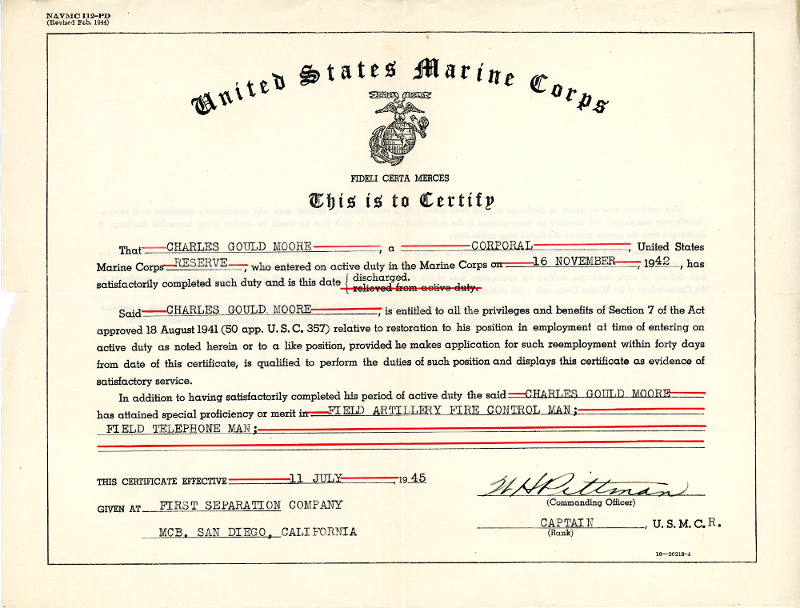
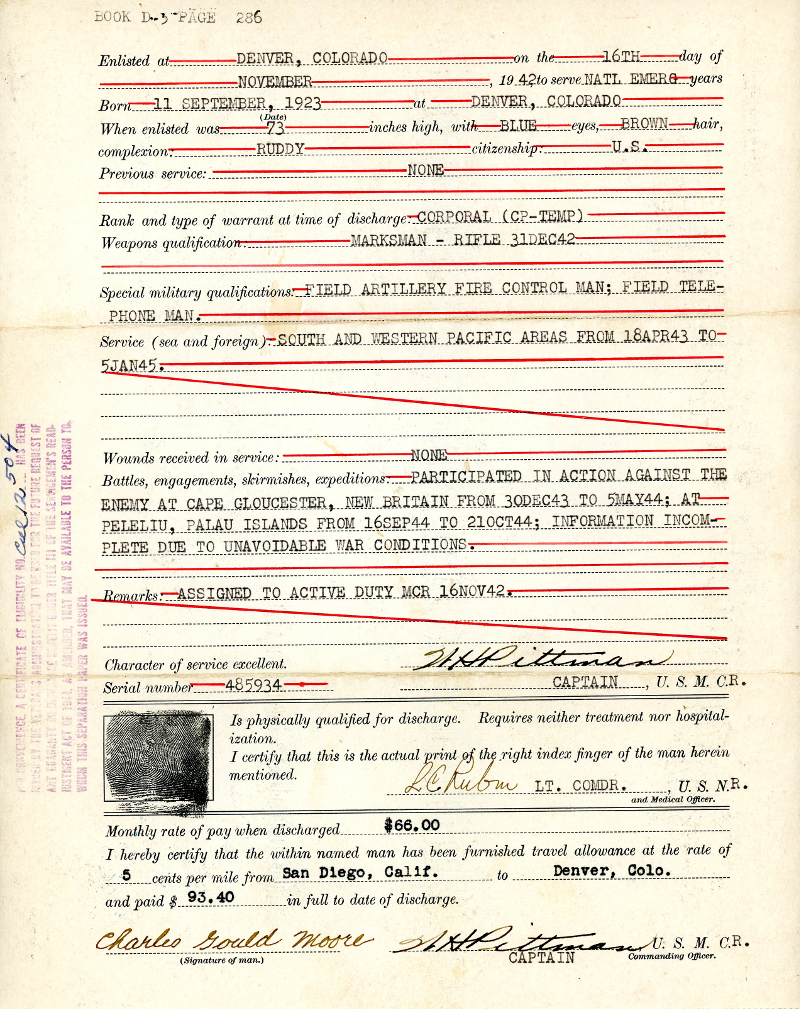
So - getting back to the question of Chuck Moore's WWII combat job description - his assignment while deployed in combat was with the 5th Battalion, 11th Marines, First Marine Division, later re-designated as the 3rd Battalion, 11th Marines, First Marine Division after Cape Gloucester and before Peleliu. The 5/11 and 3/11 were, and 3/11 still is, an artillery battalion/regiment (105 howitzers during WWII). Given his specialty training, the nature and timing of his second request to change his MOS, and the indication in his service record that his principal MOS at separation was 645, it is very likely that he initially served as a Field Telephone Man at Cape Gloucester. However, as alluded to above in his request to change his specialty, he may very well have effectively transitioned to the Field Artillery Fire Control Man MOS while at Cape Gloucester, and later served in that role at Peleliu.
Preparation For War
Although relatively small, at the time of formation, the First Marine Division was the first integrated amphibious strike force of its size in the US armed forces. The assembled force proved to be too big for accommodation at the First Brigade's home at Quantico, Virginia so part of the division was split off to Parris Island, South Carolina. Before the men could make themselves at home, they were put aboard ship and transported for maneuvers to a 100,000-acre-plus swampland the Marines had acquired off New River, North Carolina. There they conducted exercises through June, July, and August of 1941, culminating in a Joint Force exercise that was the largest of its kind ever held in the US.
During their time at New River, which never really ended until they were deployed overseas, the men lived in "Tent City" (later to be replaced by the buildings of Camp Lejeune), constructed by the men themselves from whatever materials they could muster. With the exception of the bitter cold experienced during the winter of 1941/42, the crude living conditions and swampy, bug-invested environment proved to be emblematic of the conditions they would later experience in the Pacific campaign. Afterward, one staff officer related a statement he made while at New River: "Why this division, training here, won't be fit for a thing but jungle warfare." He added, "It's surprising how much like Guadalcanal that damned place was."
Guadalcanal

command tent, Guadalcanal, 1942.
On May 1, 1942, the advanced echelon of the First Marine Division boarded trains at New River and headed for Norfolk, Virginia from where they would embark aboard transport ships headed for Wellington, New Zealand. They arrived in Wellington on June 20, expecting to undergo further training to benefit the hundreds of new recruits the Division had acquired, average age less than 19 years. Instead, six days after they arrived, they learned about a place called Guadalcanal (gwahd-l-kuh-nal) when the Division Commander, General Alexander Archer Vandegrift, was handed a dispatch from the Joint Chiefs of Staff that read: "Occupy and defend Tulagi and adjacent positions (Guadalcanal and Florida Islands and Santa Cruz Islands) in order to deny these areas to the enemy and to provide United States bases in preparation for further offensive action." At that point in time, the First Marine Division was just about the only ready striking force the nation possessed and so, naturally, they were given the assignment.
They were given a D-Day date of August 1st:
That was thirty-seven days away and, considering that the second echelon would not arrive until July 11, the Division had a little less than a month to unload and to re-load, combat-style.
The margin was slimmer than that, at least as it appears in a staff problem used in the post-war curriculum on the Marine Corps Schools. "The concentration," begins the problem, "is to take place in the Fijis, six days from New Zealand by transport. That leaves 31 days. Koro, in the Fijis, is seven days from the objective. That leaves 24 days in which to reconnoiter the objective, get information, study the terrain, make a decision, issue orders, load 31 transports and cargo carriers, embark 20,000 men and 60 days' supply, effect a rendezvous with supporting naval forces and, in addition, conduct a thorough set of joint rehearsal exercises ..."
"Division headquarters and one combat team has just arrived at Wellington," continues the problem. "The second combat team, the First Marines, is at San Francisco, the third combat team, the Second Marines, is at San Diego, the First Raider Battalion is in New Caledonia, the Third Defense Battalion is at Pearl Harbor, along with supporting naval forces."
Source: 'THE OLD BREED: A History of the First Marine Division In World War II'After further consideration of the amount of preparation needed by both the Marines and the Navy support group, D-Day was moved back to August 7, 1942. All overnight leave was canceled on June 30 and the Marines were organized into around-the-clock working groups. Arriving transports had to be unloaded and then reloaded in combat configuration, sometimes simultaneously. To gain time and space, one-third of the planned-for supplies had to be left behind.
After completing preparations, the First Division departed Wellington and arrived at Koro Island, in Fijis in late July, where pre-invasion practice for landing operations would be conducted and Task Force 62 would be assembled.
The convoy left Koro and arrived at Guadalcanal on August 6th. The convoy included three carriers (Saratoga, Enterprise, and Wasp), one battleship (North Carolina), some cruisers, and a number of destroyers along with the transports carrying the First Division. The convoy represented nearly all of the effective striking force of the US Navy at that time.
Since my dad did not join the First Marine Division until after Guadalcanal, my intention here is to address the battle in the context of the follow-on campaigns that Chuck Moore was a part of. There are many sources of information (books, movies, USMC documents, videos, web sites, etc.) that can provide the interested reader with more in-depth information about Guadalcanal. Wikipedia is not always the best source, but the article Guadalcanal Campaign is a well done comprehensive summary of the battle and provides an exhaustive listing of other references with more detailed information. The following video (Figure 9) is from the production of the HBO Miniseries, The Pacific. It contains a mix of actual footage, dramatizations, and interviews with Guadalcanal veterans. It is a good ten-minute summary of what happened at Guadalcanal.
The Battle of Guadalcanal was the first major Allied ground offensive carried out against against the Japanese. As alluded to in the video, it exposed the myth of Japanese soldier invincibility and provided insight into how the Japanese forces would defend their occupied territories in the Pacific. The First Marine Division gained a clearer picture of what was needed to successfully conduct combat operations in the tropical climate and jungle environments of the Pacific islands. It marked the transition from defensive to offensive Allied operations which would be carried forward with the island-hopping strategy that would eventually lead to the defeat and surrender of the Empire of Japan.
The victory at Guadalcanal also provided a needed emotional uplift for the American public:
The fact that Guadalcanal was the first offensive strike might not have impressed the public so much had not the Japs in the months before made Americans look like such easy marks. There was the humiliation of Pearl harbor, a nasty and deep cut in national pride; there was our helplessness to aid the men of Corregidor, Marines as well as Army troops; there was, altogether, our impotence before consistent and relentless Japanese advance throughout the Pacific.
True, the Navy turned back the Japanese at Coral Sea and Midway. But that, somehow, did not capture the imagination nor satisfy the national need, not so much for revenge, as for proof that our men were as good fighters, had as much moral stamina as theirs. "People had come to believe," an officer recalls, "that the Japs were supermen, that maybe our American boys really weren't as rugged as the Japs. What people wanted, back in the summer of '42, was a hand-to-hand battle royal between some Japs and some Americans to see who would really win."
That exactly is what happened on Guadalcanal. The Japs and the men of the First Division came out of the thick jungle at one another day after day for four months, meeting in hand-to-hand combat, grappling with knives and bayonets, and firing at one another with the small arms of the individual foot soldier, the issue always in shaky balance.
But when this intimate campaign was over, the men of the First Division had proved to the satisfaction of themselves, their officers, and the American public that the youth of democracy can meet and defeat the youth of a nation regimented in fanaticism.
"There was a national sigh of relief when the Japs were knocked off that island," a radio news commentator has said, and the name Guadalcanal has passed into history bearing the magical qualities of such other American battlefields as Valley Forge, Gettysburg and Belleau Wood.
Source: 'THE OLD BREED: A History of the First Marine Division In World War II'Chuck Moore was not at Guadalcanal. He joined the 11th Marines, First Marine Division three months later in Melbourne, Australia.
After completion of basic and specialty training in San Diego:
- 4/5/43 – joined 16th Replacement Battalion, FMF (Fleet Marine Forces)
- 4/17/44 – Embarked on board USS Lurline at San Diego, California en route to Melbourne, Australia
- 4/24/43 – crossed the equator for the first time
- 5/6/43 – joined Headquarters Co. 7th Replacement Battalion, FMF (apparently while still on board Lurline in port at Melbourne)
- 5/10/43 - disembarked USS Lurline at Melbourne, Australia
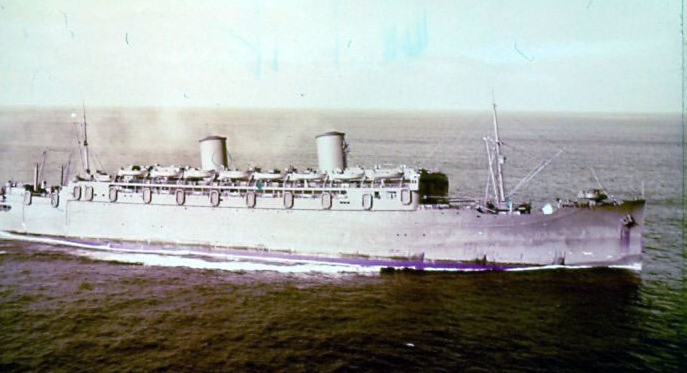
When Chuck Moore arrived at Melbourne, the First Marines were there resting, recuperating, and training after Guadalcanal. As a brand new recruit, I'm sure he got an earful from the veterans who survived the battle. Less than six months later, Private 1st Class Chuck Moore and the rest of the new recruits would join the veterans in embarking on a voyage to the First Marine Division's next island campaign at a place called Cape Gloucester.
Cape Gloucester
Cape Gloucester (GLAW-ster, GLAW rhymes with CLAW) is located on the western tip of the island of New Britain (Figure 11). At the outset of the Pacific war, New Britain was a territory of Australia. In 1942, Japan attacked and occupied New Britain with thousands of troops and set up a major air base at Rabaul and two small airstrips inland from Cape Gloucester (in addition to numerous other military facilities throughout the island). By late 1943, the Allies were gaining the upper hand and Australian army divisions were advancing north along the coast of New Guinea. The landing at Cape Gloucester was designed to preclude any air attacks on Australian forces originating from the airstrips, to establish a allied base from which to provide air support to the Australian advance, to disrupt ongoing Japanese barge traffic between the Cape Gloucester area and Rabaul, and to ensure free Allied passage through the straits of Vitiaz and Dampier which separate New Britain and New Guinea.
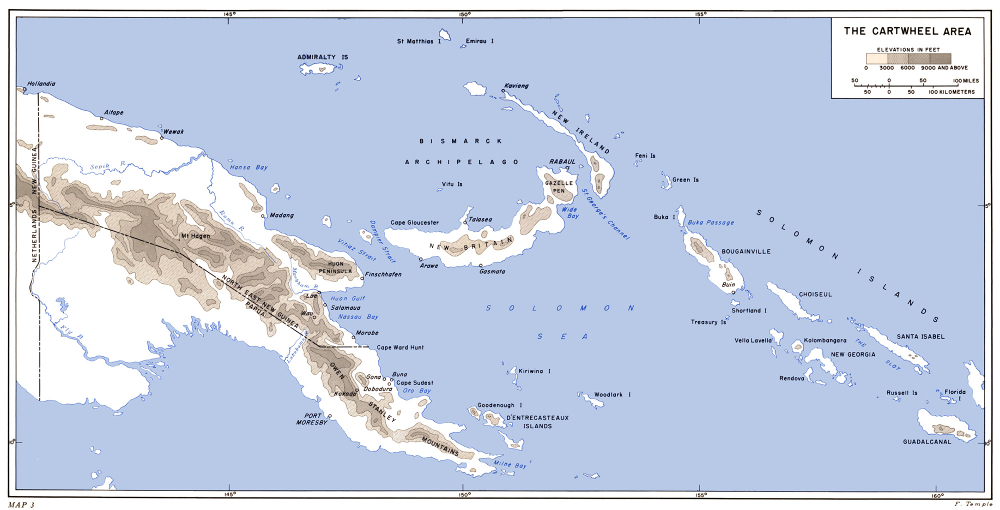
The Gloucester action was conducted under the command of the US Army led by the Supreme Allied Commander of the South West Pacific Area, General Douglas MacArthur. The action was under the auspices of Operation Cartwheel within a subordinate operation specific to the invasion of New Britain, codenamed Operation Dexterity. The overall objective of Cartwheel was to isolate and harass the Japanese base at Rabaul (and avoid the need to assault the large garrison there head-on), and sever the Japanese lines of communication throughout the Southwest Pacific area. The Gloucester landing was planned and executed under yet another codename, Operation Backhander.
MacArthur's Sixth Army was designated to plan and execute Operation Backhander. During the planning process, one of the initial concerns was getting bogged down against the large jungle-wise Japanese force garrisoned on New Britain. They needed a jungle-wise force of their own. Fortunately for the planners, the First Marine Division was already included in the Sixth Army's organizational structure and at that time the First was ensconced in Melbourne, Australia, resting and recuperating from an extensive jungle engagement at Guadalcanal.
In July 1943, the First received the initial directive for the Cape Gloucester campaign and soon thereafter obtained the Sixth Army plan. Division was not happy with that plan. It was considered too complicated and called for a dangerous dispersal of forces landing at several widely spread points rather than the Division's preference for force concentration at the objective. Before points of contention could be ameliorated between the Sixth Army and the First staffs, the Division was given orders to mobilize from Melbourne to Goodenough Island and New Guinea.

5th Battalion/11th Marines Private 1st Class Chuck Moore had arrived at Melbourne to join the First Marine Division on May 10, 1943. On that date he was assigned to "Battery 'P', H&S Battery, 5th Battalion, 11th Marines, FMF". Twenty-one days later, on May 31, his assignment changed to "H&S Battery, 5th Battalion, 11th Marines, 1st Marine Division, FMF". Here is a definition of a Marine Corps H&S Battery:
In keeping with the long-standing practice of referring to company sized artillery units as "batteries" the headquarters company equivalent element of an artillery battalion or regiment, or a low altitude air defense battalion, is referred to as a Headquarters Battery (Field Artillery) or a Headquarters and Service Battery (-) (LAAD) / Headquarters and Service Battery Detachment.
Each Marine artillery battalion has a 199-member battalion headquarters battery that contains the battalion headquarters, an operations platoon, a service platoon, a communications platoon, and the battery headquarters (T/O 1142G). A Marine artillery regiment has a 380-member regimental headquarters battery consisting of the regimental headquarters, an operations platoon, a communications platoon, the battery headquarters, an artillery electronic maintenance section, an engineer equipment platoon, a motor transport section, and a counter battery radar platoon (T/O 1101H).
Source: Wikipedia: Headquarters and Service CompanyMy interpretation of this definition is that Chuck Moore was initially assigned to the H&S component of an individual artillery battery, Battery "P", within the 5th Battalion, and then re-assigned to the battalion-level H&S component of the 5th Battalion, 11th Marines (5/11). That is, his assignment went from H&S battery level to H&S battalion level. As described above, as best as I can determine his MOS prior to Cape Gloucester was 641 - Telephone Man (i.e., communications), so it seems likely that he performed at Gloucester as a member of the 5th Battalion H&S, 11th Marines' communications platoon.
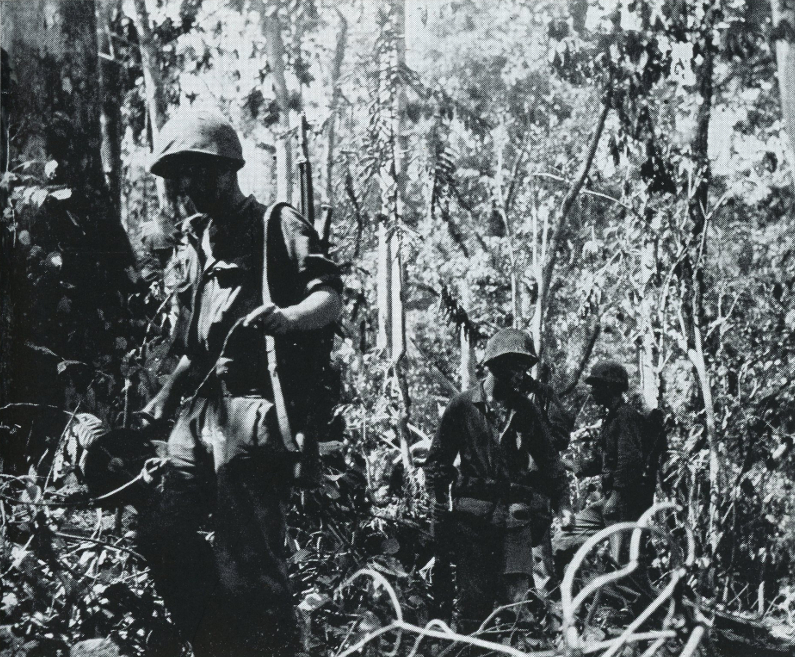
Upon arriving in the New Guinea theater, elements of the Division were to be staged at a number of different locations: the 5th Marines to Milne Bay, the 7th Marines to Oro Bay, and the 1st Marines, Engineer regimental headquarters, and Division headquarters to Goodenough Island. All of these locations had been previously secured by Australian-led Allied victories over Japanese forces in 1942 and early 1943. These locations are shown on Figure 11.
On September 26, 1943, Private 1st Class Charles G Moore's service record indicates that he had "embarked on board the Liberty Ship USS James W Grimes at Melbourne, Victoria, Australia and arrived at Milne Bay, New Guinea" on October 18, 1943; assembling there, in concert with the 5th Marines, as part of the 5th Battalion, 11th Marines. While at Milne Bay, Private Moore was promoted to Corporal Moore, Communications Specialist on December 1, 1943.

By October 23, all elements of the First Marine Division that would participate in the Cape Gloucester campaign had left Melbourne and were at, or in transit to, their designated locations. Once assembled in the New Guinea operations area, they underwent training to, among other things, learn about a new fleet of small ships and boats that were ideally suited for the eventual mobilization from New Guinea to Cape Gloucester. Three days prior to final embarkation from the staging areas, all the craft that would take part in the assault, including the new LSTs (Landing Ship, Tank), LCIs (Landing Craft, Infantry), and LCTs (Landing Craft, Tank), would take part in a rehearsal landing at Cape Sudest (Oro Bay).
Note: Of particular importance were the LSTs which could transport not only tanks, but all sorts of other military vehicles as well as over 200 troops. They were designed with a special flat keel that allowed them to land on the beach with no need for docks or piers, and were equipped with large bay doors and a ramp in the bow so that vehicles could be driven directly onto the beach. Figure 14 illustrates how the LSTs were configured.
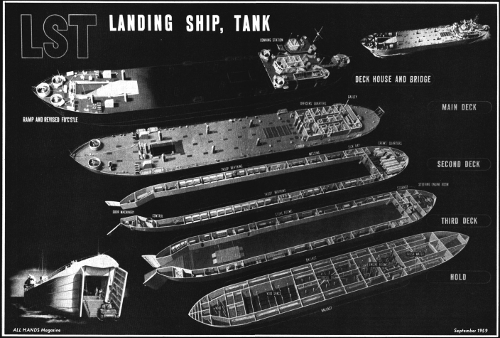
In late November, General MacArthur visited Goodenough to review the Cape Gloucester operations plan. During that review, First Division headquarters staff expressed their dislike for the existing Sixth Army plan. After further discussions between the Sixth Army commander, Lieutenant General Walter Krueger, First Marine Division commander General William H. Rupertus, and their respective staffs, a revised plan that was more in-line with Marine Corps philosophy was approved. Division staff member Lieutenant Colonel E A Pollack, later explained that, "This plan was most acceptable. It kept the Division intact, and permitted the landing of a sizable force against an enemy known to be superior, and well established. This was in keeping with the views of the Division of initially placing an overwhelming force on the beach ..."
The US troops were opposed by elements of the Japanese 17th Division (Lieutenant General Yasushi Sakai), which had previously served in China before arriving on New Britain in October and November 1943. These troops were known as "Matsuda Force", after their commander, Major General Iwao Matsuda and consisted of the 65th Brigade, with the 53rd and 141st Infantry Regiments and elements of the 4th Shipping Group. These troops were supported by field and anti-aircraft artillery, and a variety of supporting elements including engineers and signals troops. Just prior to the battle, there were 3,883 troops in the vicinity of Cape Gloucester.
Source: Wikipedia: Battle of Cape GloucesterNote: The entire Matsuda Force garrison was estimated to be 10,500 men scattered throughout a wide area on New Britain.
Documented information and maps for western New Britain were almost non-existent for planning purposes. Available off-shore charts and surveyed mapping dated to the German occupation in the early 1900's. Intelligence officers supplemented these by interviewing anyone they could identify who had ever lived on or otherwise had knowledge of the island. In the end, maps were developed primarily from extensive photographic surveys done by the Allied Air Forces. The surveys, however, were hampered by the dense jungle environment and Japanese camouflage efforts. To provide some ground-truth to the planning maps, a program of amphibious reconnaissance was implemented by clandestine patrols using PT boats and rubber rafts to land ashore and scout the terrain. These missions were conducted at great risk by a group known as the Alamo Scouts comprised of men from the US Army, Navy, and Marine Corps, and the Australian Navy.
Note from The Campaign on New Britain: To facilitate prisoner interrogation, Sixth Army loaned the division 10 enlisted men, all Nisei (American-born Japanese). The accommodation was accepted somewhat reluctantly by the Marines who feared for the safety of any Japanese under combat conditions, regardless of citizenship or uniform. Plans called for the Nisei to handle translations while eight officer-interpreters questioned prisoners. Despite the original hesitancy, relations between the Marines and the Nisei were friendly and improved with time. The soldiers proved of inestimable value in the D-2 section and won the following accolade:
For Operation Backhander, the First Marine landing forces were divided into three combat teams: 1) Combat Team A, "Reserve Group" included the 5th Marines and Corporal Moore's 5th Battalion/11th Marines, 2) Combat Team B, "Wild Duck Group" including 1st Marines, and 2nd Battalion/11th Marines, "Stoneface (Landing Team 21 - LT21) Group" including 2nd Battalion/1st Marines, Battery H/3rd Battalion/11th Marines, "Antiaircraft Group", and "Engineer Group", and 3) Combat Team C, "Greyhound Group" including 7th Marines, 1st Battalion/11th Marines, and 4th Battalion/11th Marines. The Combat Team assignments appear to me to be primarily a way of grouping a given set of units according to their destinations/assignments and assigning a specified set of ships to them within the convoy. A detailed listing of the Command Organization for Cape Gloucester is provided in 'THE OLD BREED: A History of the First Marine Division In World War II'
The Landing
On D-Day, LT21, 2nd Battalion/1st Marines (2/1) with Battery H of 3rd Battalion 11th Marines (3/11), would make a diversionary landing on Green Beach near Tauali on the western side of the Cape (Figure 16), with the additional intent of blocking trails along the coast to and from the airstrips. Simultaneously, the 1st Marines (minus the 2nd Battalion) along with the 2nd Battalion 11th Marines (2/11), and the 7th Marines along with the 1st & 4th Battalions 11th Marines (1/11 & 4/11) would land on Yellow Beaches 1 & 2 on the east side of the Cape. The 5th Marines, along with the 5th Battalion of the 11th Marines (5/11 - Corporal Moore's unit) stood by in reserve at Oro Bay ready to go aboard ship on call. Both landings would be supported by naval units from the Seventh Fleet and aircraft of the First Air Task Force (FTAF), Fifth Air Force.
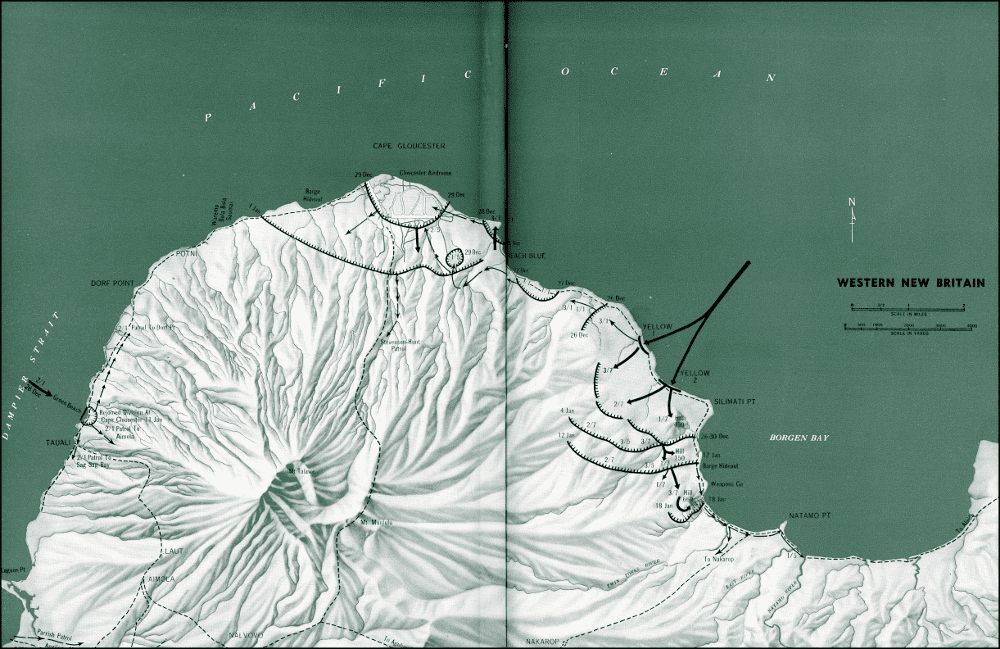
D-Day was planned for December 26, 1943. On December 15, a combined Army and Marine force landed against a small Japanese garrison at Arawe on the south-central coast of New Britain (Figure 17). In addition to securing the Arawe peninsula, the operation's objective was to block a Japanese reinforcement route and serve as a diversion from the landings at Gloucester. It did succeed in diverting an estimated 1,000 Japanese troops away from Gloucester in response to the Arawe assault.
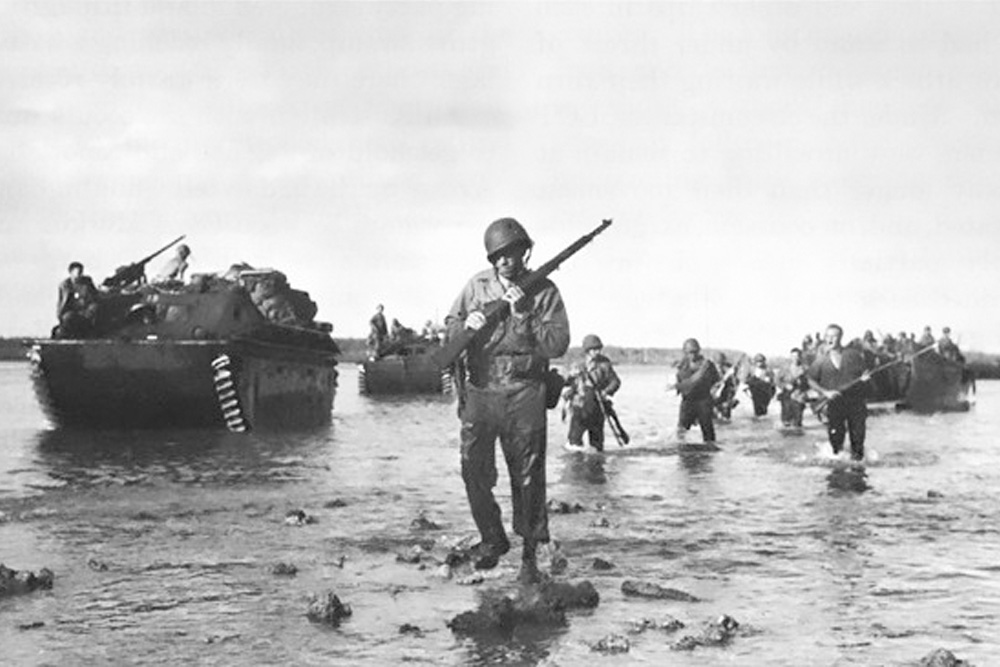
By December 18, 1943, Combat Team C would be assembled at Oro Bay (Cape Sudest) and Combat Team B at Finschhafen (Cape Cretin). Combat Team A would be held in reserve at Milne Bay with instructions to arrive at Oro Bay on D-minus 1 (Figure 18).
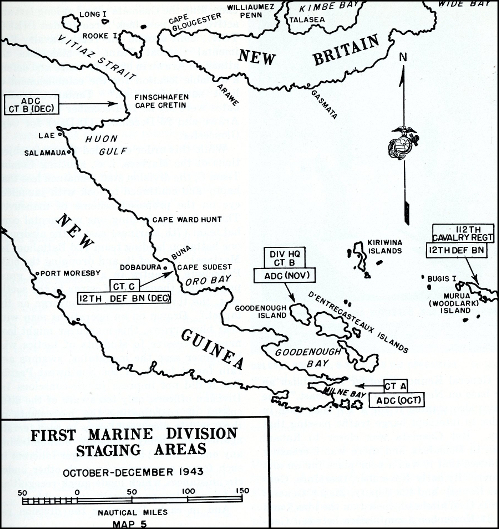
At 0600 on December 25 (D-Day-1), after final assembly at Buna Harbor on Cape Sudest, the convoy started moving northward. Meanwhile at Cape Cretin, Combat Team B (with the exception of LT21) had completed loading and was prepared to join the convoy on its way from Buna. LT21 had started its own convoy and departed at 1600 headed toward Green Beach at Tauali via Dampier Strait.
The pre-landing bombardment of Cape Gloucester by bombers and fighter bombers from the US Fifth Air Force occurred for several months in advance of D-Day, which put the Japanese's airfields out of action and destroyed many of their entrenchments. Air support continued up to and including D-Day when, in concert with Naval gunfire from escorting cruisers and destroyers, heavy bombers (B-24s), medium bombers (B-25s), light bomber/attack aircraft (A-20s), and fighter aircraft (P-38s), helped prepare the landing beach areas and suppress enemy fire.
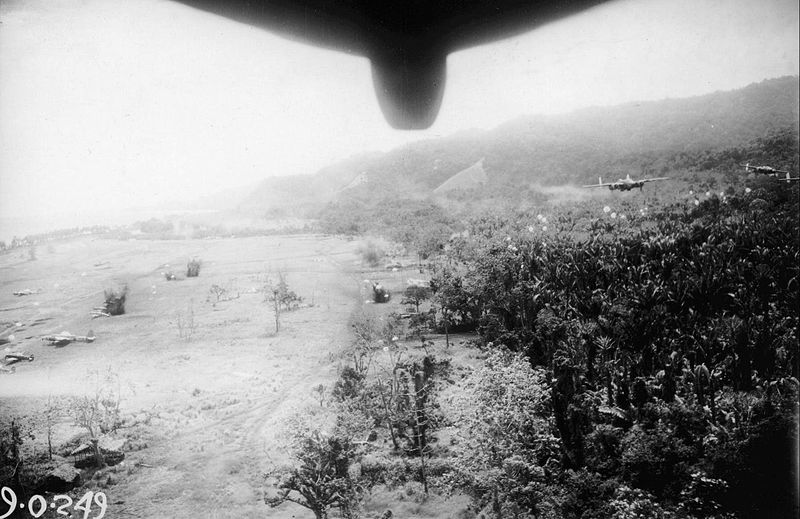
This excerpt from The Campaign on New Britain describes the start of D-Day at Cape Gloucester:
During the early hours of 26 December, Christmas Day back home across the International Date Line, the main convoy turned to starboard from Vitiaz Strait, passed around Rooke (Umboi) and Sakar Islands, and bore in toward Cape Gloucester from the northwest. First dawn paled the sky to show the brooding hulk of Mount Talawe looming off to the southward, but darkness still lay upon the water at 0600 when the cruisers and destroyers opened fire on their predetermined targets. For the next hour and a half distant thunder beat upon the eardrums, and concussion shook the air. Only one Japanese gun replied - with a single round."
Earlier, under cover of darkness, destroyers and mine sweepers had preceded the convoy through the reef opening and marked shallow shoals with buoys. APDs and rocket-equipped LCIs then led the way through the reef opening, landing craft were deployed, and troop-carrying LCIs formed up behind, followed by LSTs. Prior to the assault at 0730 on Yellow Beaches 1 & 2, a white phosphorus smoke-screen was deployed to obscure the landing areas.

The three battalions of the 7th Marines were the first to land (3/7, 1/7 and 2/7 in that order) and were all ashore at Yellow Beaches 1 & 2 by 0805, followed soon after by the 1st & 3rd Battalion, 1st Marines (1/1, 3/1) at Yellow Beach 1. The landings were virtually unopposed on the ground with the exception of a small firefight 3/7 was involved in when they were blinded by the white phosphorus smoke-screen and landed 300 yards to the west of Yellow Beach 1. There was Japanese opposition from bombers launched out of Rabaul. A few bombers managed to evade Allied P-38s and sink the destroyer USS Brownson (DD-518) with the loss of 108 of her crew, far exceeding the 21 Marines killed and 23 wounded ashore on D-day.
Although the Japanese failed to muster significant opposition to the landings at Cape Gloucester, nature took their place - the nature of the environment inshore of the landing areas. The beaches were fine for the landing craft but the above-water portions were extremely narrow and backed by vegetation so impenetrable that it could only be traversed by machete: "A tall man could lie with his head under the cover of the vegetation line and his feet out in the water."
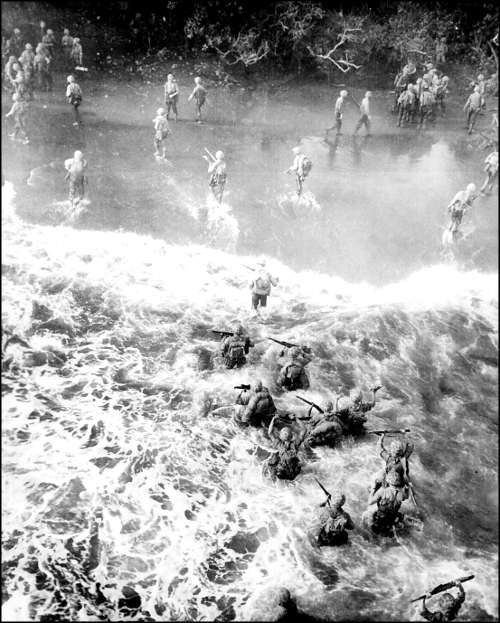

To make matters worse, behind the initial wall of vegetation was a primitive transport road connecting the airfields to Borgen Bay, and then a narrow shelf of dry ground backed by a region described by the planning map makers as a "Damp Flat" extending inland up to a thousand yards or more (Figure 23). "Damp" turned out to be an extreme understatement. As described by one of the men, "It was damp up to your neck." Some speculate that part of the reason why the landings at the Yellow Beaches were unopposed was because the Commander of the Japanese 65th Division (later determined to be a regiment) on New Britain, Major General Iwao Matsuda, reasoned that, knowing the treacherous conditions behind those beaches, the Allied military planners would not direct the landings there.
"This was, as Matsuda well new, swamp forest, some of the most treacherous terrain that exists. Forward momentum petered out as the men floundered through the mud, tore loose from the vines that gripped their bodies. In places water lay hip-deep above the earth; in other places, what appeared to be solid ground would give way under a man's weight, dropping him up to his thighs in the muck and holding him there helpless until his companions could extricate him. And the trees began to fall: great forest giants, rotten to the core and further weakened by bombing and shell fire, crashed at the slightest provocation. The first fatality suffered by the troops ashore was caused by a falling tree."
Source: The Campaign on New Britain
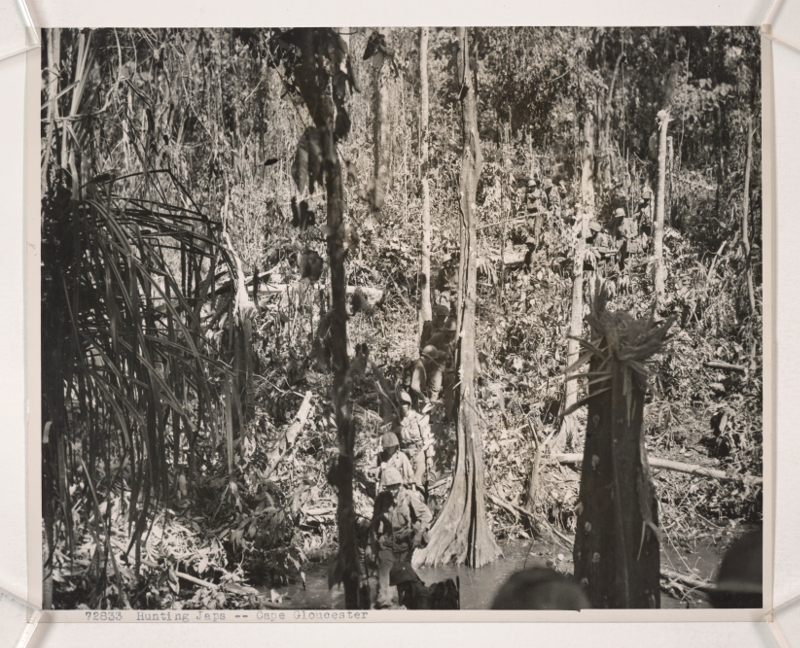
Note: If you look closely (click to enlarge) at the third Marine up from the bottom in the above photo, you will see that he is carrying a spool of wire and the Marine just behind him is helping to play out the wire as the men move along. That activity of "laying, maintaining, and taking up wire or cable" would be part of the job of a Telephone Man (TP MAN), which was the MOS for Corporal Chuck Moore during his time on Cape Gloucester.
From D-Day onward, throughout its duration, the battle of Cape Gloucester continued to be defined by the geography, the jungle, and the unremitting rain. The campaign was planned to coincide with the onset of the monsoon season. It began to rain on the afternoon of D-Day and rarely stopped during the next three months. The action report indicated that on early morning of December 27th, "a terrific storm struck the Cape Gloucester area." It goes on to say that, "Rains continued for the next five days. Water backed up in the swamps in rear of the shore line, making them impassable for wheeled and tracked vehicles. The many streams which emptied into the the sea in the beachhead area became raging torrents. Some even changed course. Troops were soaked to the skin and their skin and their clothes never dried out during the entire operation." As explained in the The Old Breed:
The fighting man expects that his vocation will carry him to unlikely and alien places. That is all right. It is one of the things he may look forward to. But there is a degree of strangeness beyond the bounds of the bargain, the bargain being: the natural hazards of the battlefield must never equal the hazards contrived by the enemy.
Break this law, put a fighting man down in a spot where the plant and animal life and the climate are as much or more of a menace to his existence than the armed human opposite him, and the fighting man will feel he is the victim of an injustice.
That is why the men who fought at Cape Gloucester remember the place more for the jungle than for the Japanese.
The forest has a structure: "the lower limits are on the ground, the upper the forest roof, supported by the forest skeleton, the trunks of the giant trees. Not only is the forest roof thick, but also even in still stronger measure, the forest margin is closed by the overwhelming mass of lianas which frequently extend to the ground, and which can form so thick an undergrowth that the forest has been accurately called impenetrable."
With a fact of climate, the description will be complete: in late December the northwest monsoons come to New Britain and for three months subject the island to one of the heaviest concentrations of rain that falls anywhere on earth.
Source: 'THE OLD BREED: A History of the First Marine Division In World War II'Robert Leckie landed on Green Beach on D-Day as a member of H Company, 2nd Battalion, 1st Marines. In his outstanding book Helmet for My Pillow: From Parris Island to the Pacific, A Marine Tells His Story (one of the chronicles that the HBO miniseries "The Pacific" is based on), he provides a more personal description of the "hell" that was New Britain:
The puffing of my lips and eyes symbolized the mystery and poison of this terrible island. Mysterious—perhaps I mean to say New Britain was evil, darkly and secretly evil, a malefactor and enemy of humankind, an adversary, really, dissolving corroding, poisoning, chilling, sucking, drenching—coming at a man with its rolling mists and green mold and ceaseless downpour, tripping him with its numberless roots and vines, poisoning him with green insects and malodorous bugs and treacherous tree bark, turning the sun from his bones and cheer from his heart, dissolving him—the rain, the mold, the damp steadily plucking each cell apart like tiny hands tearing at the petals of a flower—dissolving him, I say, into a mindless, formless fluid like the sop of mud into which his feet forever fall in a monotonous slop-suck, slop-suck that is the sound of nothingness, the song of the jungle wherein everything falls apart in hollow harmony with the rain.
Nothing could stand against it: a letter from home had to be read and reread and memorized, for it fell apart in your pocket in less than a week; a pair of socks lasted no longer; a pack of cigarettes became sodden and worthless unless smoked that day; pocketknife blades rusted together; watches recorded the period of their own decay; rain made garbage of the food; pencils swelled and burst apart; fountain pens clogged and their points separated; rifle barrels turned blue with mold and had to be slung upside down to keep out the rain; bullets stuck together in the rifle magazines and machine gunners had to go over their belts daily, extracting and oiling and reinserting the bullets to prevent them from sticking to the cloth loops—and everything lay damp and sodden and squashy to the touch, exuding that steady musty reek that is the jungle’s own, that individual odor of decay rising from vegetable life so luxuriant, growing so swiftly, that it seems to hasten to decomposition from the moment of birth.
It was into this green hell that we were inserted a day or two after the march from Tauali-Sag Sag. And here was fought that battle with the rain forest, here the jungle and the men were locked in a conflict far more basic than our shooting war with the Japanese—for here the struggle was for existence itself.
The war was forgotten, Who could comprehend it? Who cared? The day was but twenty-four hours and the mind had but two or three things to command it, objects like dryness, food—oh, most of all, most unbelievably of all, a cup of hot coffee—a clean, dry pair of pants and a place out of the rain! Hours passed in precocious contemplation of that moment just before darkness, when—with cigarette wrappings and the wax-paper covers of the K-rations, with matches carefully wrapped in a contraceptive and kept within the liner of the helmet—a tiny fire was lighted and water heated in a canteen cup, and thus was the belly fortified to face the cold black night.
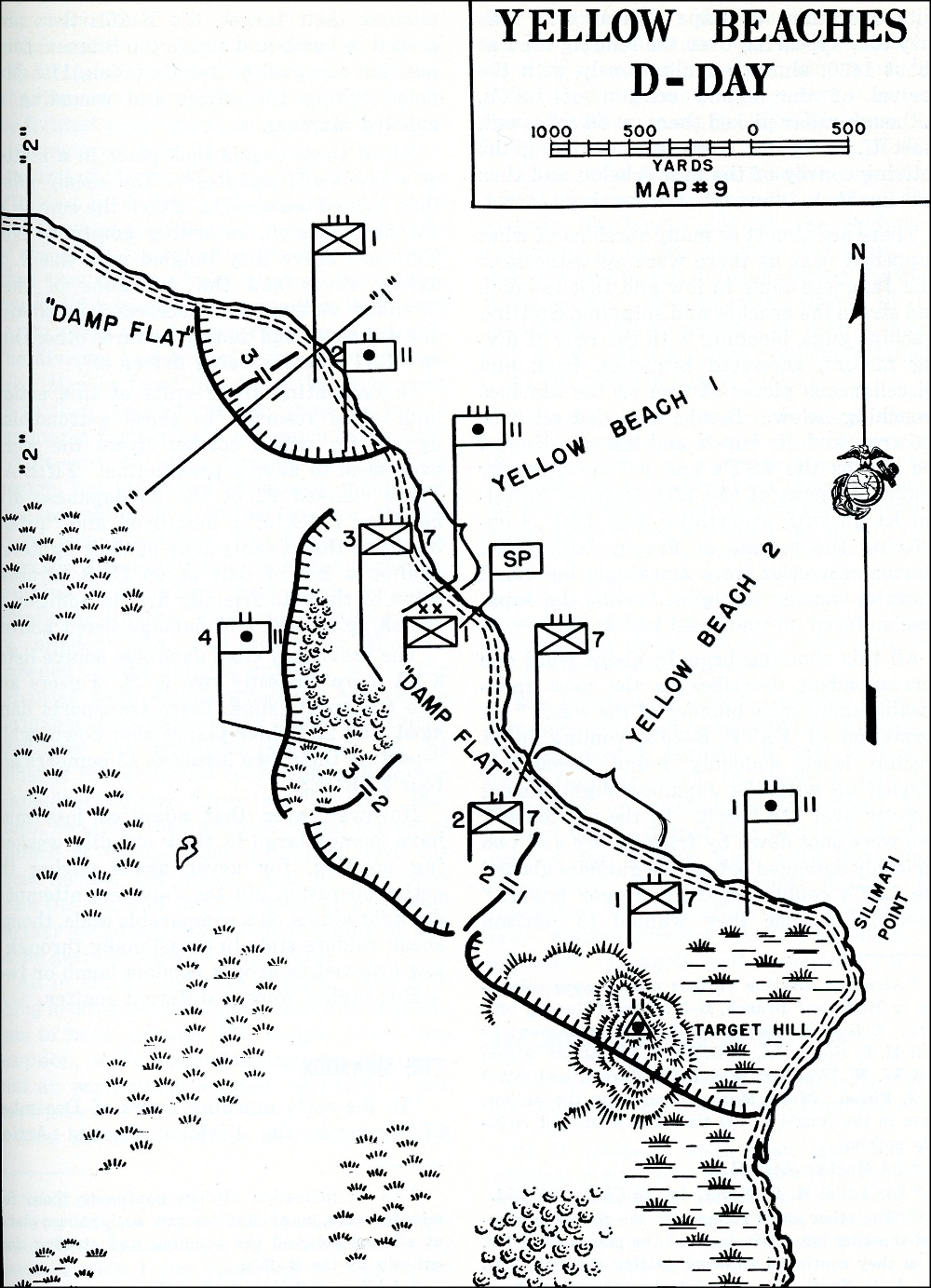
The initial objective of the 7th was to push inland and establish a defensive perimeter south and west of the beaches (Figure 23). This effort was to include occupying the high ground of a small hill (Target Hill/Hill 450) south of Yellow Beach 2. Target Hill had been decimated by the pre-landing bombardment and so was unoccupied and soon taken by men of 1/7.
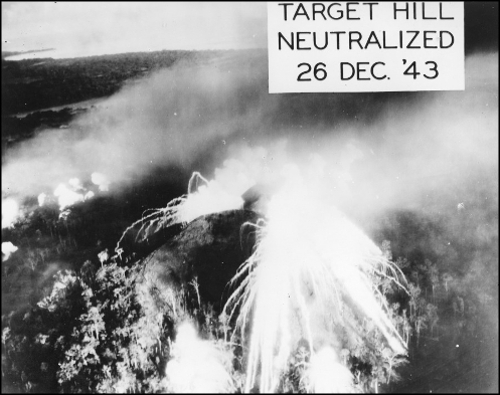
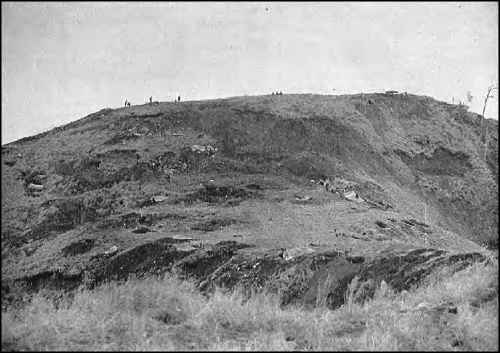
The assignment for 1/1 and 3/1 was to land on Yellow Beach 1, turn right, and spread out abreast across a wide front from the coast inland as soon as possible, hook up with 3/7 to form a defensive perimeter, and move northwest along the coast toward the Cape Gloucester airfield with the objective of capturing it. This plan immediately ran into trouble as 1/1 attempted to go into position left of 3/1 and ended up bogging down in the "damp flat". To address this problem, the plan was quickly changed; 3/1, led by Lieutenant Colonel Joseph F. Hankins, would move along the narrow shelf adjacent to the coast with 1/1 in echelon to their rear. They would rely in part on the damp flat to protect their left flank (Figure 23). They soon encountered opposition:
While reinforcements and cargo crossed the beach, the Marines advancing inland encountered the first serious Japanese resistance. Shortly after 1000 on 26 December, Hankins's 3d Battalion, 1st Marines, pushed ahead, advancing in a column of companies because a swamp on the left narrowed the frontage. Fire from camouflaged bunkers killed Captain Joseph A. Terzi, commander of Company K, posthumously awarded the Navy Cross for heroism while leading the attack, and his executive officer, Captain Philip A. Wilheit. The sturdy bunkers proved impervious to bazooka rockets, which failed to detonate in the soft earth covering the structures, and to fire from 37mm guns, which could not penetrate the logs protecting the occupants. An Alligator that had delivered supplies for Company K tried to crush one of the bunkers but became wedged between two trees. Japanese riflemen burst from cover and killed the tractor's two machine gunners, neither of them protected by armor, before the driver could break free. Again lunging ahead, the tractor caved in one bunker, silencing its fire and enabling Marine riflemen to isolate three others and destroy them in succession, killing 25 Japanese. A platoon of M4 Sherman tanks joined the company in time to lead the advance beyond this first strongpoint.
Source: Cape Gloucester: The Green InfernoThe new plan sped up movement of 1/1 and 3/1 along the coast but it also caused 3/7, slogging through the damp flat on their left, to fall behind while trying to maintain the defensive perimeter. This opened a gap in the perimeter that allowed a small group of Japanese to infiltrate. As a result, 3/7 was ordered back to the main beachhead line, and 1/1 and 3/1 were tasked with setting up their own perimeter as they advanced.
According to the Division Special Action Report, in the early morning hours of the 27th, "a terrific storm struck the Cape Gloucester area". This was a prelude to monsoon conditions that would persist over the course of the next three months and virtually eliminated any dry ground upon which to move equipment, supplies, and Marines in the areas of the beachheads and along the coastal route. The Japanese commander, General Matsuda, choose this time to counterattack against the landing force.
The defensive perimeter behind the Yellow Beaches, was comprised of 3/7 on the right, 2/7 in the middle, and 1/7 on the left (Figure 23). Late in the afternoon of D-Day a Japanese battalion-size force moved into position opposite of 2/7 in preparation for the counterattack. Exchange of fire escalated in intensity after sunset and 2/7, led by Colonel Odell M. Conoley, began to run low on ammunition. The amtracks supplying ammunition from the beachheads, could not resupply 2/7 at night because they could not see to avoid the fallen trees and roots as they maneuvered across the damp flat. In recognition of the problem, Colonel Lewis B. Puller (better known among his men as "Chesty" Puller), executive officer of the 7th Marines, organized available Marines into supply parties to wade through the swamps carrying ammunition to 2/7 at the far edge of the damp flat - a very hazardous mission given that a misstep could cause a Marine, weighed down by heavy ammunition, to disappear under the water and drown. This mission was carried out during a blinding monsoon rain storm with each Marine hanging on to the belt of the Marine in front of him. Some twelve hours after the column started, they reached 2/7 and put down their loads to take up their rifles. After a desperate fight by the men of 2/7 to hold off the Japanese during the night, the Marine reinforcements, along with the ammunition they brought in, caused the Japanese to break off the action.
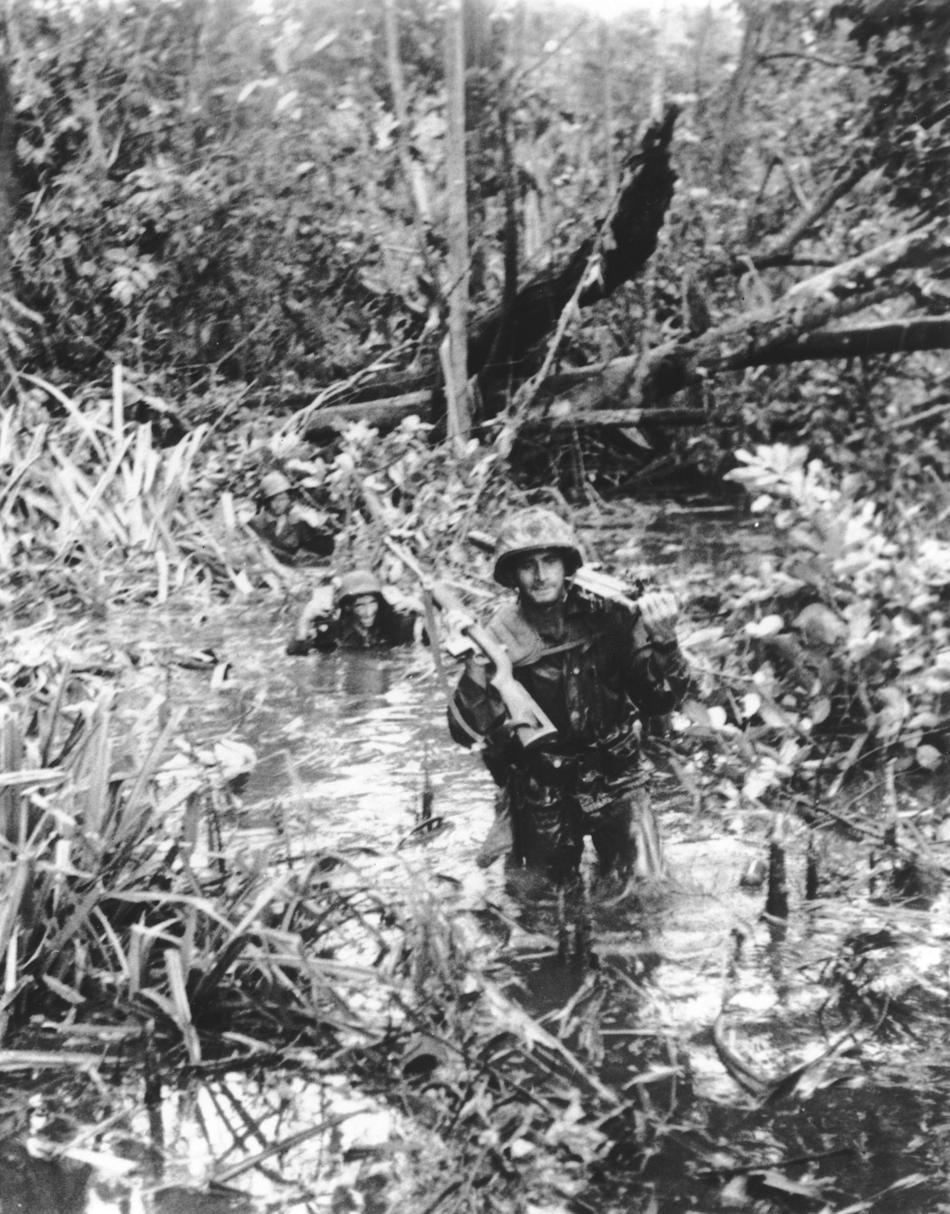
11th Marines at the Gloucester D-Day Landing
Units of the 11th Marines accompanied all of the landings on D-Day. Faced with the difficult terrain, the 4th and 1st Battalions, 11th Marines, in company with the 7th Marines, were able to establish firing positions near the Yellow Beaches with the aid of amphibious tractors and bulldozers that broke trail and pulled them into position. The 4th battalion (4/11) had to drag its 105mm howitzers through 400 yards of "damp flat" in order setup in a large kunai (tall grass) patch in support of the attack on the airfields (Figures 26 & 27). They remained there until their departure from New Britain.
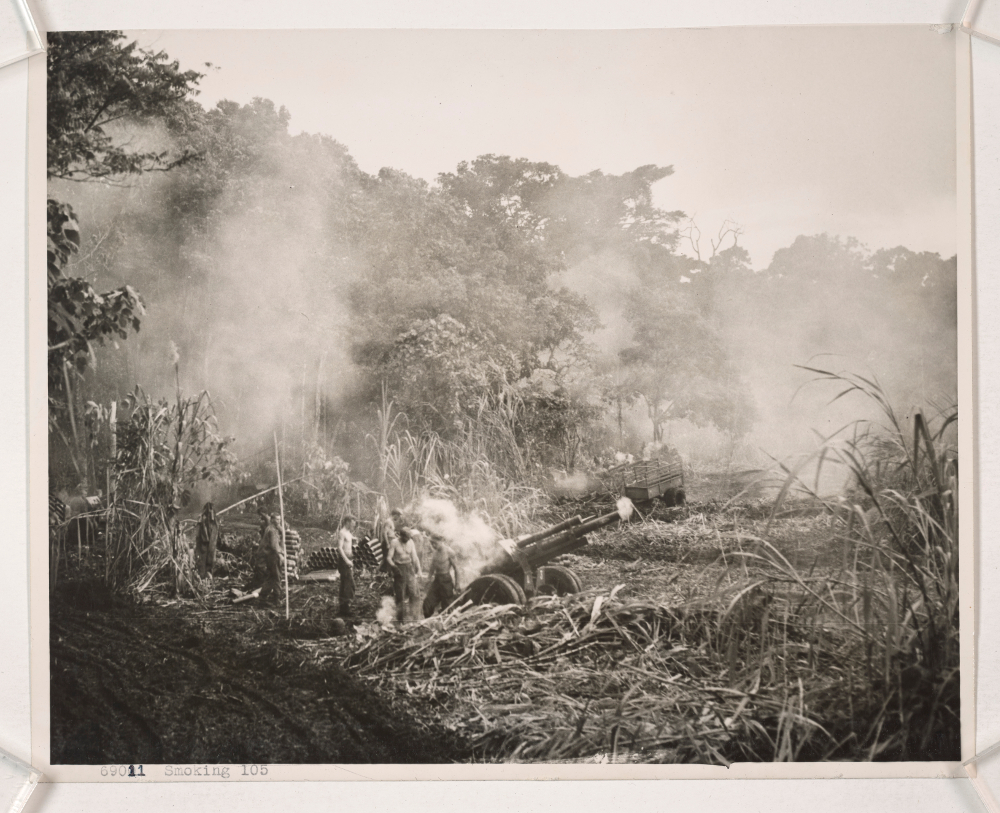
The 1/11 was assigned a position on Silimati Point (Figure 23). To get there they had anticipated moving their 75 mm pack howitzers along the coastal trail but were stymied by trees that had been felled by the pre-attack bombardment and had to take a beach route instead. Arriving at their destination, they found a swamp instead of the "scattered trees" they had expected and had to setup positions on the adjacent beach. Their difficulties were exacerbated when gunners on ships in the convoy mistook US B-25s for enemy aircraft. Two of the American bombers were downed and other bombers in the flight were disrupted to the extent that they dropped their bombs prematurely on the artillery positions of the 1/11, killing one officer and wounding 14 enlisted. Later that afternoon, the 1/11 was attacked by a small group of Japanese troops and one officer and five enlisted were killed in the ensuing fight. The 1/11 remained at their position on Silimati Point throughout the remainder of the campaign.
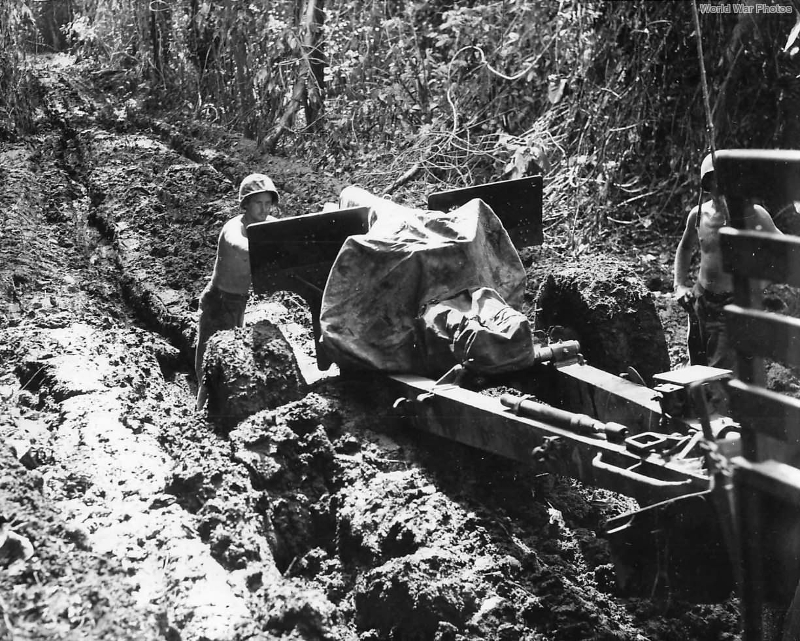
Note: Of great value in navigating the swamps of Cape Gloucester were the LVTs (Landing Vehicle, Tracked) that were brought ashore by the LSTs (Figure 28). They were variously referred to as "amphibious tractor", "amtrak", "amtrac", "alligator", and "gator". They were unique in that they could travel over land, including rain-soaked muddy bogs, roads, and trails with their tank-like tracks, but could also float and so maneuver through the flooded portions of the "damp flat". They were used for a wide variety of purposes but were of particular value to the 11th as a means of hauling artillery into position.
The LVTs also often provided the only mechanical means of crossing the swamps to bring/ food and ammunition to Marines fighting in areas beyond the swamps. However, this provided one downside - their treks through the jungle resulted in their treads chewing up many miles of telephone wire. This was likely frustrating to Corporal Moore in that, as a telephone man, he would have been responsible to laying a portion of that wire.

The 2nd Battalion (2/11) in company with the 1st Marines were not faced with the "damp flat" problem and were able to displace their 75mm howitzers forward twice along the coast in support of the 1st's assault on the airdrome. They remained at the airdrome until February 23, 1944 when they joined the 5th Marines in mop-up operations at Iboki and Talasea.
Battery H, 3rd Battalion, 11th Marines, in company with 2nd Battalion, 1st Marines (LT21 Group), landed on Green Beach near Tauali on D-Day. Once the Green Beach operation concluded, LT21 joined its parent command at the airfield and Battery H came under control of 2/11 until its parent Battalion, 3/11, left New Guinea and joined the Division at the airdrome on February 19, 1944.
On D-Day Corporal Moore's unit, 5th Battlion, 11th Marines, in company with the 5th Marines, was still being held in reserve at Oro Bay. They would soon be called up to join the battle.
Summary of the D-Day Landings
In retrospect, the landings at Cape Gloucester were considered a success as conveyed in "The Campaign on New Britain":
What the Marines did know was that they had effected a remarkably efficient landing on terrain described by their commanding general as "the most difficult that I have ever encountered in landing operations." Establishment of the beachhead perimeter and commencement of the drive on the airdrome had cost the division 21 killed in action and 23 wounded. The next day enemy counteraction added eight killed and 45 wounded to the D-Day figures. Estimated Japanese casualties approached the 300 mark.
Although the terrain had proved worse than the planners had anticipated, and the weather worse than the uninitiated could have imagined, Japanese ground resistance had been less severe than expected, their air resistance impotent. All troops were ashore safely, together with their equipment, including rolling stock, tanks and artillery. Dump dispersal had failed to measure up to optimistic advance plans owing to proximity of the island swamps; yet in addition to assault landing craft, 14 LST's had been completely unloaded of their vehicles and 55% of their combined bulk cargo, and the difficult shore party problem momentarily solved. The main perimeter stood firm, and a substantial start had been made on the airdrome drive, even if not exactly in the manner planned.
Source: The Campaign on New BritainAdvance on the Airfield
The logistics and effort required to support the Japanese attack on Conoley's 2/7 battalion on the night of the 26th/27th, prompted General Rupertus to request the release of the division reserve, Combat Team A, the 5th Marines. The nature and timing of the planned movement (from Milne Bay to Oro Bay) and subsequent call-up for Combat Team A (5th Marines reinforced by 5th Battalion, 11th Marines) corresponds with Chuck Moore's service record:
- 12/24/43 to 12/26/43 - Embarked on board USS Etamin at Milne Bay, New Guinea and arrived at Cape Gloucester, New Britain. The reference to Cape Gloucester in this movement is likely incorrect (should be Oro Bay) given that, 1) Combat Team A had been standing by at Oro Bay on D-Day, 2) the USS Etamin was a Liberty ship and would not have been used to carry troops into the landing zone and, 3) Corporal Moore's next documented movement was:
- 12/28/43 to 12/30/43 - Embarked on board USS LST #202 at Oro Bay, New Guinea and arrived at Cape Gloucester, New Britain."
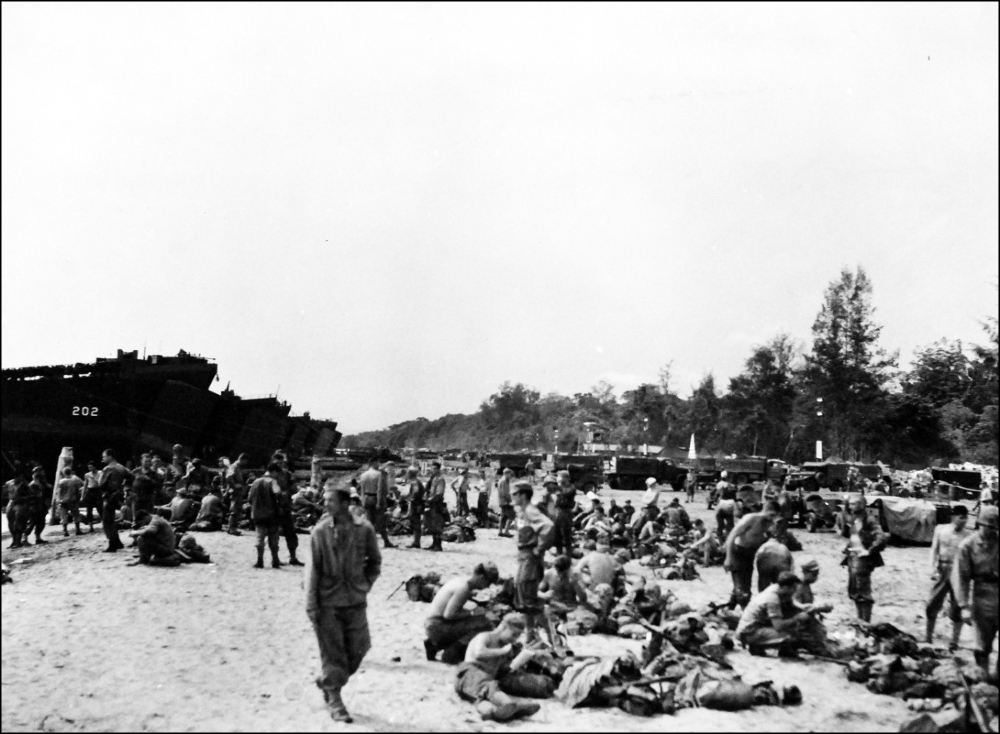
The decision was made to land the 5th Marines on Blue Beach (Figure 32) which would place them three miles northwest of the Yellow Beaches and that much closer to the airfields. Two battalions, 1/5 and 2/5, landed on the 29th, and 3/5 along with Corporal Moore's battalion 5/11, landed a day later.
Meanwhile, as they advanced northwest along the coast, the Marines of 3/1 and 1/1 met little to no resistance through the 27th. This indicated that the Japanese had likely made the decision to withdraw and concentrate on more favorable ground in defense of the airfield. One of these positions was a point of land (designated as Hell's Point - Figure 32) that flanked a crescent-shaped beach 1000 yards east of the airdrome. This location had been identified earlier by aerial reconnaissance as containing a system of prepared defensive positions.
In preparation to attack, 11th Marine artillery directed fire on the point and the Fifth Air Force conducted bombing and strafing missions. The infantry advance began at 1000 and at 1200 Marines moving along the coastal road began to receive small arms fire and 75 mm shelling. At 1215 they came upon the first of the prepared positions consisting of mutually supporting bunkers and rifle positions well armed with antitank guns and 75mm artillery, and obstructed with wire and land mines. These were originally designed to defend against beach landing but were partially modified over the previous two days to address a land attack.
The Marines of 3/1 attacked the prepared bunkers with three tanks, each escorted by infantry. They encountered twelve huge bunkers with 20 Japanese in each. The tanks fired directly into the bunkers and any escaping Japanese were killed by rifle fire and grenades. Twelve bunkers were destroyed with another two abandoned before they could be attacked.
While the fight was developing against the prepared positions, Company A of 1/1 moved into a large kunai grass patch 500 yards inland where they came under fire from a company-sized enemy force utilizing prepared interlocking firing lanes in the tall grass. The ensuing fire fight lasted four hours, the Marines breaking up two frontal assaults and one attempt to turn their flank. Around 1545, with ammunition running low, Company A withdrew toward the beach covered by artillery and rifle fire. The forward observer from the 11th Marines remained behind to call down fire on the enemy positions. The next morning 41 dead Japanese were found in the abandoned position. The Marines had lost eight dead and 16 wounded.
By removing the threat on Hell's Point, the last effective defenses of the airdrome were successfully destroyed. Losses for 3/1 were nine killed and 36 wounded versus 266 dead Japanese. Hell's Point was later renamed as Terzi Point in honor of Company K's commanding officer, who had been killed in action on D-Day.
As 3/1 and 1/1 advanced up the coast, they were followed by the engineers of the 17th Marines (Seabees) working continuously to widen and maintain the muddy and washed-out coastal road which was subject to constant rain and further degradation by wheeled and tracked vehicles. Given the extreme conditions, the men of the 17th were unable to keep up, jeopardizing efforts to bring food and ammunition forward and carry the wounded back. Fortunately, capture of Hell's Point opened another usable beach, designated Blue Beach, which would be utilized to bring supplies via water as well as provide a landing location for the arrival of the 5th Marines on the 29th and 30th.
Note: Shortly after the fight, on the 28th, the command post was displaced forward in order to maintain closer contact with the 1st Marine's drive on the airdrome. This necessitated moving the general and his staff beyond the main perimeter and, thus a requirement for an strong security guard. This duty fell to the division band which did most of the work around the CP - another example of "all marines are of the line" regardless of assigned MOS:
During the two nights that the CP occupied this second position, the bandsmen were supplemented by the Public Relations Section, manning what was probably one of the most expensive two-man security posts on record: two captains, a master sergeant, two technical sergeants and a civilian newspaper correspondent standing four-hour watches. The Japanese proclivity for shooting everybody in sight eliminated the noncombatant from the Pacific war; doctors, medical corpsmen, civilians, even chaplains carried weapons—and used them.
Source: The Campaign on New Britain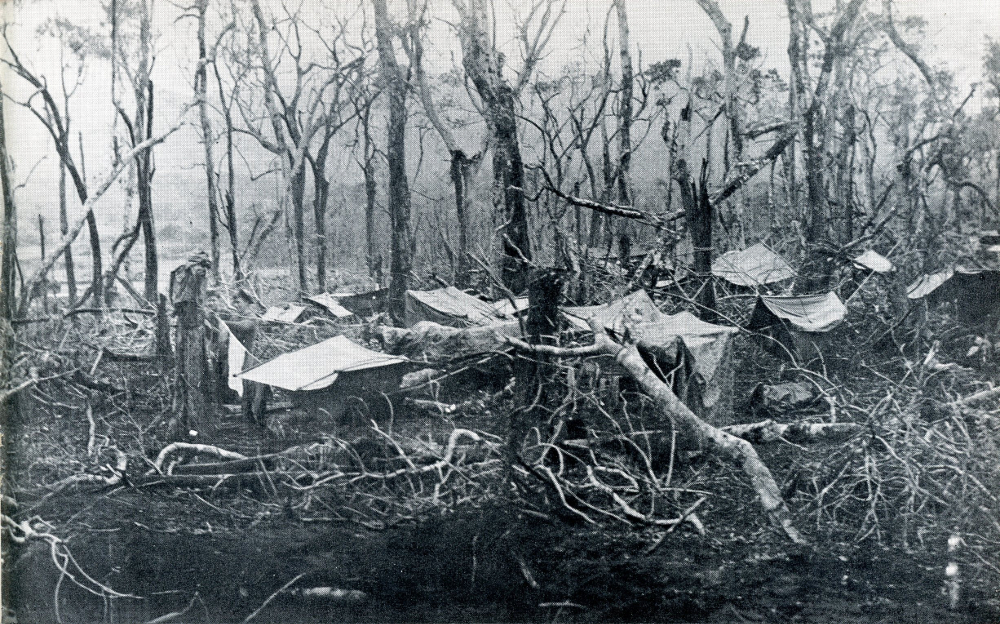
Nine APD's carrying the the 1st and 2nd battalions of the 5th Marines arrived off Cape Gloucester early on the morning of the 29th. The landing location was originally designated as Yellow Beach 2 but was changed to Blue Beach after Hell's Point was cleared. Some of the landing party elements did not get the change notice and so landed at Yellow Beach 2 and then proceeded to Blue Beach to hook up with the remaining elements.
Shortly after landing, The commander of the 5th, Colonel John T Seldon, conferred with General Rupertus and his command team and the decision was made for 1/1 to continue its attack along the coast road while the 5th made a sweep to the southwest to cut off enemy withdrawal from the airdrome vicinity, and then press the attack on the No. 2 airstrip (Figure 32) through an area thought to contain prepared enemy defenses.
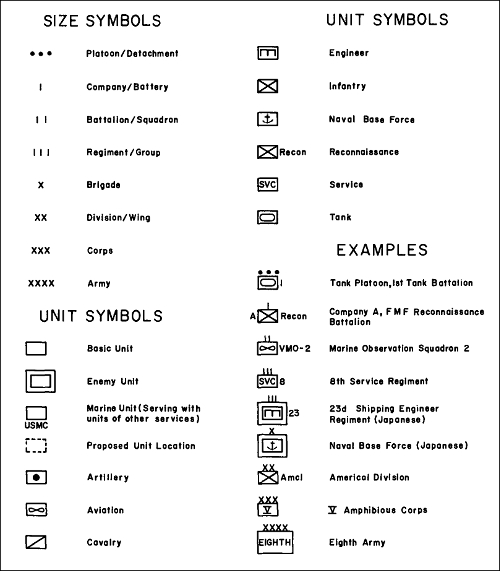
Note: These are the symbols used in the maps provided in The Campaign on New Britain, such as Figure 32. Some examples:
 1st Battalion, 5th Marines, Infantry
1st Battalion, 5th Marines, Infantry 2nd Battalion, 11th Marines, Artillery
2nd Battalion, 11th Marines, Artillery 5th Marines (Regiment), Infantry
5th Marines (Regiment), Infantry 12th Marines (Battalion), Artillery, Anti-Aircraft
12th Marines (Battalion), Artillery, Anti-Aircraft Defensive Perimeter
Defensive Perimeter
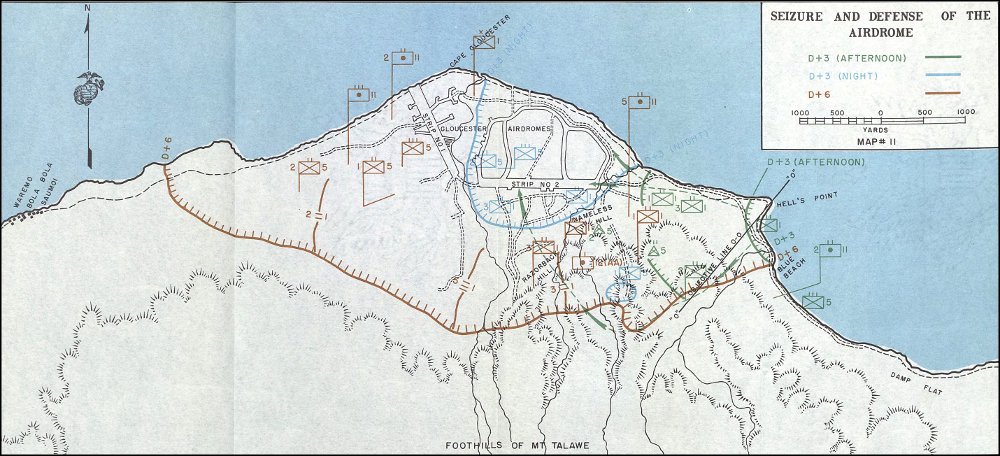
After establishing a command post near Hell's Point, Colonel Seldon joined Lieutenant Lewis W. Walt, commander of 2/5, in a movement from the point inland along a kunai ridge where the 1st Marines had their fire fight the previous day. The movement was slowed considerably by rain forest and deep swamp but the expected prepared positions had been abandoned by the enemy allowing 2/5 to reach the center of Airstrip No. 2 by 1925 in the evening. The plan was for 1/5 to follow 2/5 but the terrain difficulties slowed them down enough so that 2/5 had to stop before contacting 1/5 and set up its own perimeter defense for the night (Figure 32).
Simultaneous with the movement of the 5th Marines, 1/1 passed through 3/1, departed the coastal road, and supported by artillery and air strike preparation, proceeded in company with tanks through kunai and jungle to a large kunai patch below a slight rise overlooking the eastern end of Airstrip No. 2. Little Japanese resistance was encountered along the way. The final assault on the airstrip is described in "The Campaign on New Britain" as follows:
Now there developed a spectacle rare in jungle operations: the massed panoply of modern war, attacking over open ground in plain view of all observers. The ubiquitous rain had ceased for the moment; sunlight even broke briefly through the overcast.
The tanks wheeled left across the front and deployed in a widely intervaled line along the edge of the kunai, where the infantry, emerging from the cleared-out woods, formed in combat groups about them. Artillery shells rumbled overhead, to detonate with a reassuring roar on suspected enemy positions to the front. Nearer at hand sounded the coughing bark of mortars, and tracer bullets from machine guns ricocheted crazily from the rain forest trees on the left of the clearing. An Army crew drove up in a DUKW mounting a multiple rocket launcher. This was a new weapon to the Marines, who observed it with lively interest. To those unable to see the devastating pattern of the rockets' burst, the "whooshing" sound of the discharge sounded rather ridiculous, and everybody laughed, to the considerable mortification of the crew.
The attack formed without haste. On the left, Company A relieved Company B in assault, the latter unit passing into battalion reserve. Then, on signal, the tanks moved out at a foot pace, blazing away with their 75's and machine guns to the front and into the flanking jungle. The infantry clustered protectively about them and deployed across the intervals between, the men partially hidden by the coarse waist-to-shoulder-high grass that impeded their progress. The impressiveness of this mighty military spectacle was jarred somewhat by the sudden appearance of a German shepherd dog, evidently a Japanese deserter, who took over as "point" and led the advance, leaping and cavorting happily ahead of the line, to the amusement of the troops who, sensing victory as a fait accompli, were now in high spirits.
Source: The Campaign on New Britain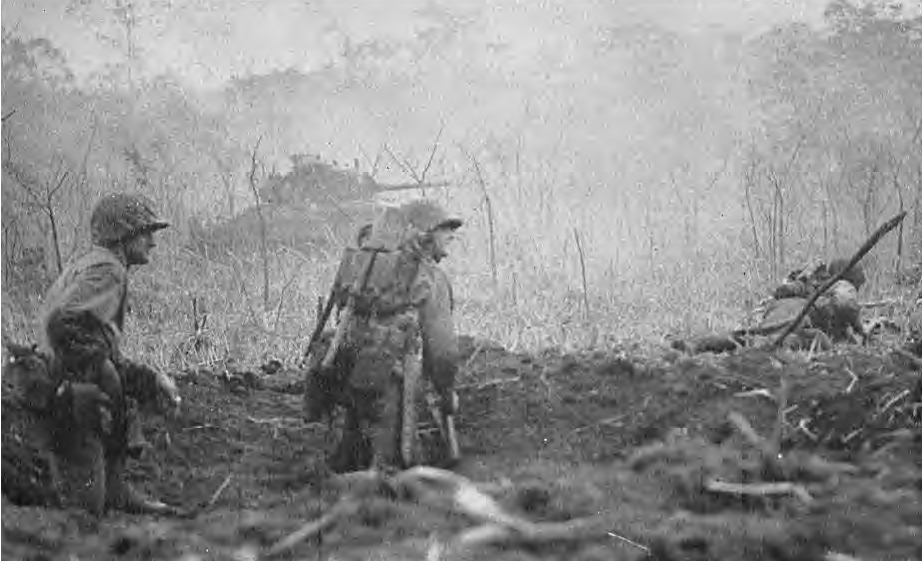
At the end of the day (by 1755), the major objective of the entire operation had been secured with relatively little cost - two men of the 1st Marines wounded, and one dead. Very minimal enemy resistance had been encountered. Upon the later arrival of the 5th Marines at 1925, a defensive perimeter was completed around the airdrome and no counterattacks occurred during the night.
As for the Japanese, later events indicated that they had withdrawn their remaining elements to a safer location at a high ridge-like formation dubbed Razorback Hill south of the airdrome. Patrols on the afternoon of the 29th found abandoned defensive positions in lower portions of Razorback.
However, on the morning of the 30th, mortar and light artillery shells began falling on the airdrome. Scouts sent out encountered 12 Japanese at the edge of the prepared defenses that had appeared abandoned the previous day. After a discreet withdrawal, they returned with reinforcements and were brought under fire near a small grassy knoll (later known as Nameless Hill) by a larger enemy force that charged the Marines in banzai fashion. After repelling the charge, tank support was called in to deal with the enemy bunker system. In the interim, a second banzai charge was turned away. The arriving tanks, in company with infantry, proceeded to knock out 30 to 40 bunkers, one containing as many as 13 Japanese. This ended the action at Nameless Hill (Figure 32) that resulted 13 Marines killed and 19 wounded while the the count of Japanese dead exceeded 150.
That same morning 1/5, which was positioned in the defensive perimeter west of the airdrome, had moved out in an attempt to make contact with regimental command and 2/5. They immediately encountered occupied Japanese positions and engaged in a fire fight resulting in the loss of six dead and 12 wounded.
Meanwhile elements of 3/1 located south of the airdrome had moved out in an effort to flank those Japanese facing 1/5. They encountered more re-occupied Japanese positions which they overwhelmed with the aid of tanks, the survivors retreating up a ravine toward Razorback Hill (Figure 32). Rapid pursuit of those forces carried 3/1 to the summit of the hill, the occupation of which proved key in extending the defensive perimeter around the airdrome. This action was accomplished with the loss of only one killed and four wounded.
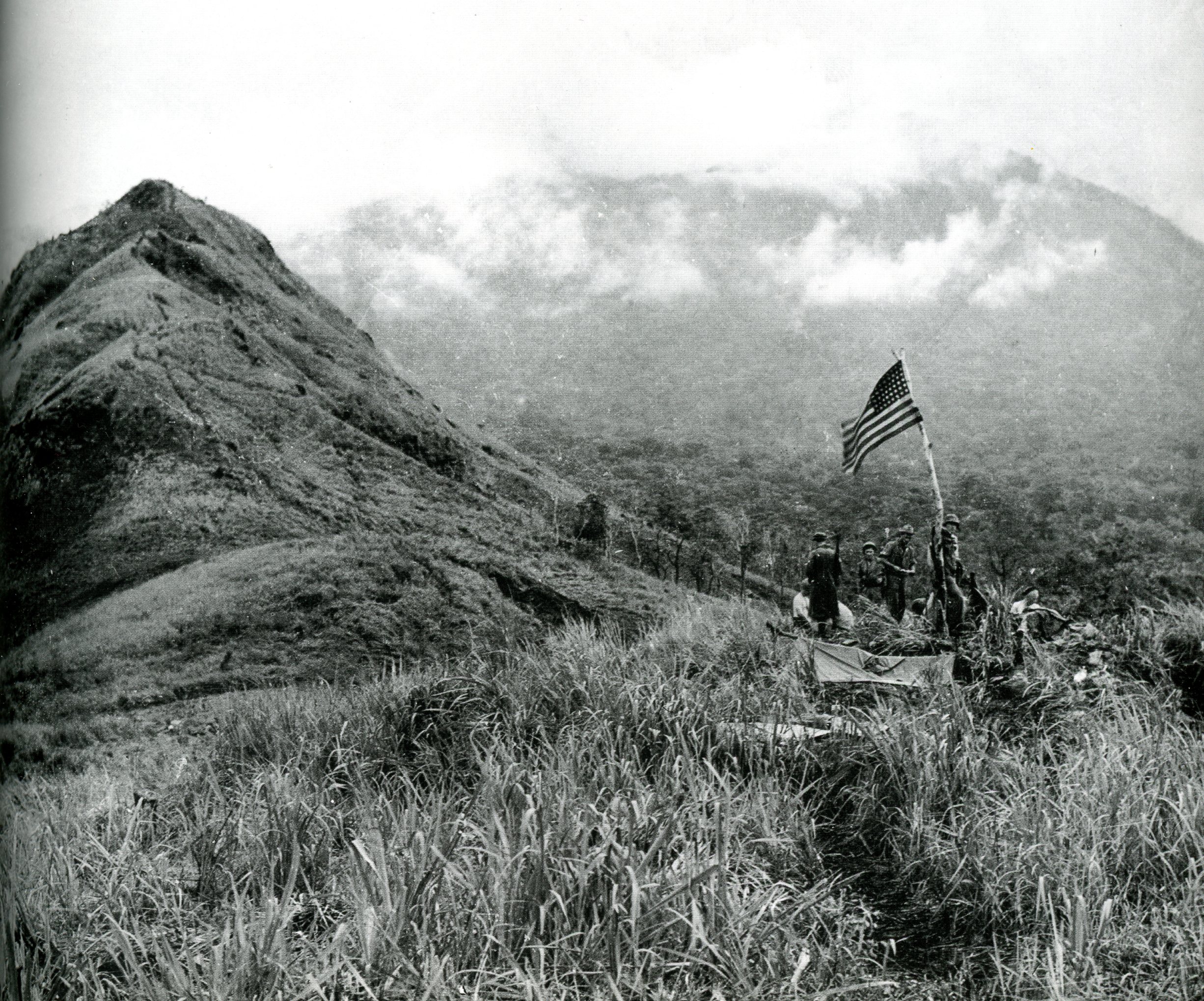
By 1800 on the 30th, enemy resistance had withered to only sniper fire in the vicinity of the airdrome, a status that would not change from then until the end of the Cape Gloucester operation.
During that same day, the remaining elements of Combat Team A, the 5th Marines, landed on Blue Beach (Figure 32). As part of that group, the 5th Battalion, 11th Marines, Corporal Chuck Moore's unit, set up half way between Yellow Beach 1 and the airdrome. They would later move to the airdrome and remain there for the duration.
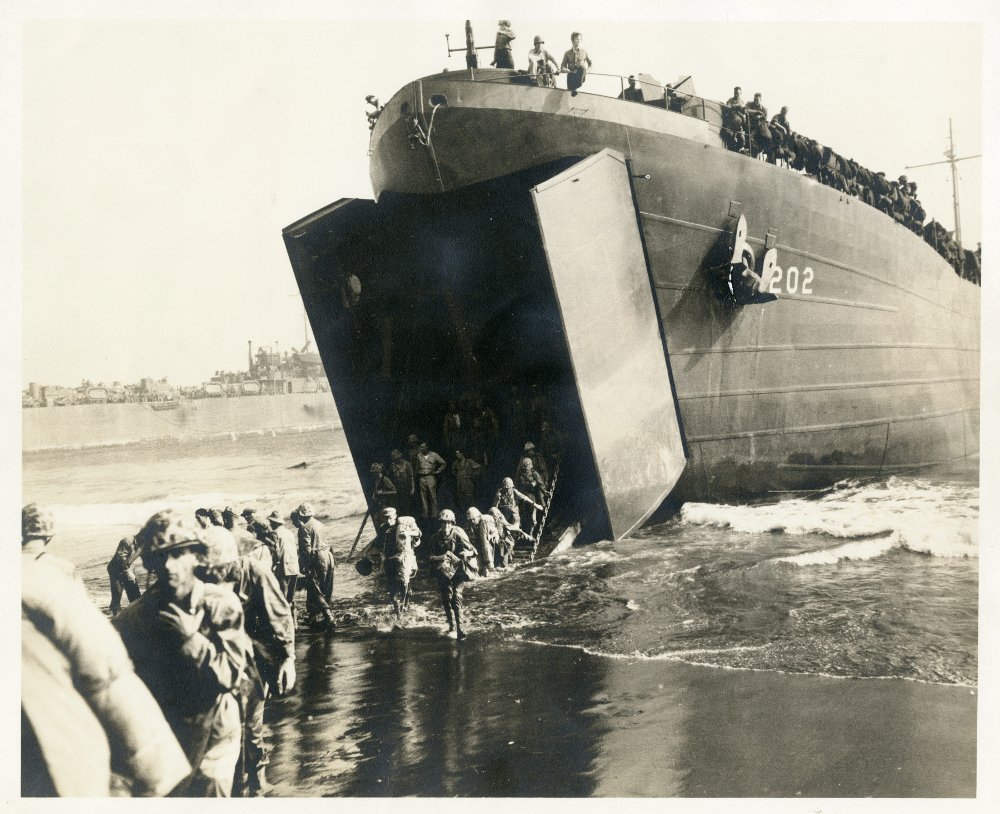
At 1300, December 30, General Rupertus sent the following dispatch to the Commanding General, Sixth Army:
"First Marine Division presents to you as an early New Year gift the complete airdrome of Cape Gloucester. Situation well in hand due to fighting spirit of troops, the usual Marine luck, and the help of God ... Rupert grinning to Krueger."
The next day at 1200, the United States flag was raised over Cape Gloucester airfield.
Source: THE OLD BREED: A History of the First Marine Division In World War II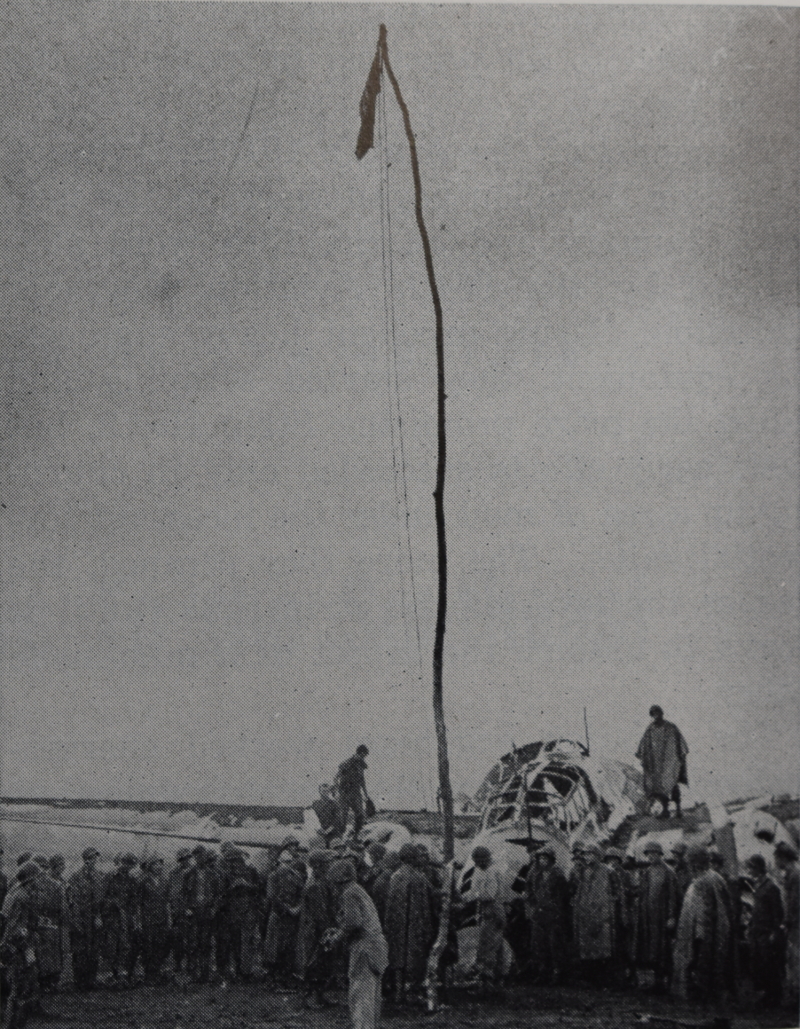
Green Beach
Meanwhile, concurrent with the landings at Cape Gloucester, the scaled-down LT21 convoy, part of Combat Team B and comprised of 2nd Battalion/1st Marines (2/1) with Battery H of 3rd Battalion 11th Marines (3/11), commanded by Lieutenant Colonel James M. Masters, and escorted by two destroyers and two patrol craft, had arrived at Green Beach (Figure 37) off of Tauali shortly after dawn on D-Day. At 0730, the destroyers opened a brief pre-landing bombardment accompanied by planes from the Fifth Air Force. The leading assault wave followed shortly thereafter and encountered no opposition enroute to the beach. The beachhead was established by 0835 and by 1000 the planned perimeter line was in place. Although no Japanese were encountered, the Marines did discover unoccupied beach positions containing abandoned rifles, ammunition, and supplies. Under the supposition that the defenders had abandoned their positions in the face of the bombardment, Colonel Masters sent out patrols to search for them, but only encountered a small group resulting in a brief firefight.

The mission of LT21 was to cut the main coastal track to prevent enemy withdrawal from or reinforcements to the airdrome, discover important subsidiary trails, create a diversion from the Cape Gloucester landings, and destroy any Japanese elements they encountered.
Continuing patrols over the next three days did not detect any large Japanese concentrations but did find signs of enemy activity in the vicinity. Most notably, a patrol surprised and killed two Japanese officers who were carrying maps and binoculars and were apparently reconnoitering the beachhead. This turned out to be a precursor to a larger engagement that would occur two days later.
In response to the presence of the Japanese officers, the three rifle companies of 2/1 were stationed on the perimeter of Green Beach in preparation for a possible attack. Battery H of 3/11 (H/11) was unable to emplace its 75mm pack howitzers in defensive positions because of the rugged terrain and so were organized into infantry platoons to back up the rifle companies. This type of re-deployment of artillery personnel was not unusual in the jagged topography and jungle environment of the Pacific islands campaign, and of course was pertinent to Corporal Moore as a member of an artillery unit.
For the next few days, patrols sent out by Colonel Masters sporadically encountered and exchanged fire with small groups of Japanese from a few individuals to platoon and company-sized units. Some of these encounters involved Japanese soldiers sleeping beside the trail or advancing with rifles slung and no point or other security measures. The indication was that the enemy was not fully aware of the Marines' presence, but being shot at served to heighten their awareness and likely served as impetus for a Japanese attack at 0155 on 30 December.
The engagement was later recorded as the Battle of Coffin Corner. The Japanese concentrated their assault effort at a narrow opening on the eastern extreme of the defensive perimeter (Figure 37):
The perimeter defense was located on top of steep ridges, the approaches to which were almost perpendicular. But at Coffin Corner, a natural causeway connected the defended ridges with opposing ridges and the defense line at that particular location came to a point and consequently the defense was handicapped since a rounded front could not be presented.
Source: The Campaign on New BritainThe Japanese assault was intense and matched by the Marines' response. Initial enemy success was opposed by rifle Company G's counterattack supported by the improvised H/11 platoon and the Japanese were forced to withdraw. By soon after dawn enemy fire had ceased. Follow-up patrols counted 89 dead Japanese (Figure 38) and collected five prisoners. Marine casualties were six killed and 17 wounded.
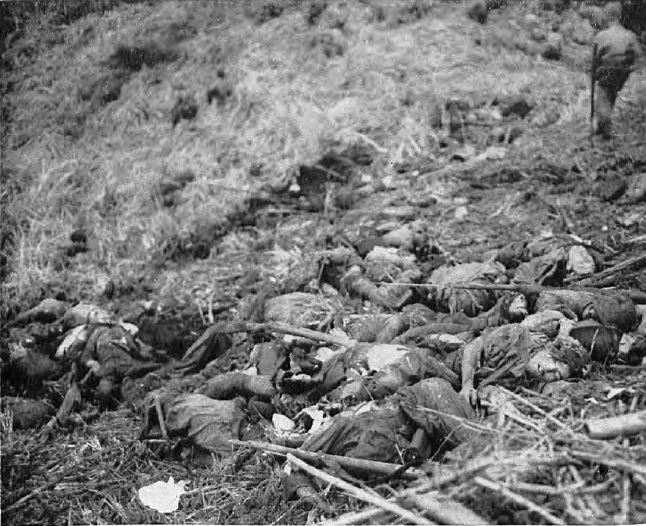
For their remaining presence at Green beach, the Marines experienced no further organized enemy attacks. LT 21 continued patrols intended to identify inland trails used by enemy soldiers but the complexity of the trail system constructed by natives to access their garden plots frustrated the Marines and enabled the Japanese occupiers to stay ahead of the patrols. On 7 January, LT 21 began preparations for evacuation. By 11 January the water-borne evacuation was complete and the remaining Marines set out on foot for the airdrome. By 13 January, LT 21 had rejoined the 1st and taken up a position on the inland side of the the airdrome.
LT 21 had done precisely what was asked of them. The value of the Green Beach operation was hard to ascertain because the enemy never really challenged their mission. The Japanese did not attempt to reinforce the airdrome from the south (perhaps because of the presence of LT 21) nor were the survivors of the airdrome battle blocked in their retreat, because they were able to withdraw further south and east rather than follow the coastal track.
Mopping Up
General Rupertus' dispatch on 30 January announced the accomplishment of the major objective of the Cape Gloucester operation (Operation Backhander), the capture of the airdrome. But for the Marines of the First Division, a more extended and brutal campaign was still to come in order to secure the remainder of Western New Britain.
The initial portion of this effort, as defined by General Rupertus, was "to conduct operations to the southeast in order to extend the beachhead perimeter and clear the enemy from the Borgen Bay area" (Figure 39). This assignment was given to a task force comprised of the 7th Marines plus the 3rd Battalion, 5th Marines and included the 1st and 4th Battalions of the 11th Marines. The second major operation of the mopping up effort was to follow-up the Borgen Bay campaign with "vigorous patrolling" in pursuit of any retreating Japanese forces to ensure that they were not allowed to regroup and reorganize.
Chuck Moore's unit, 5th Battalion, 11th Marines was part of Combat Team A which included the 5th Marines and was the final group that had come ashore for the assault on the airdrome. As stated above, 5/11 came ashore at Blue Beach on 30 December, advanced to the airdrome, and remained there for the duration of the Cape Gloucester Campaign. Corporal Moore's service record indicates that from 30 December 1943 to 16 January 1944 he "participated in Battle of Cape Gloucester, New Britain, Territory of New Guinea" and from 17 January 1944 to 4 May 1944 he "participated in Cape Gloucester mopping up operations."
The battle for Borgen Bay effectively began on 30 December and was ended on 16 January. It involved a fight for three hills located along the western side of the bay: Hill 150, Aogiri Ridge, and Hill 660 (Figure 39).
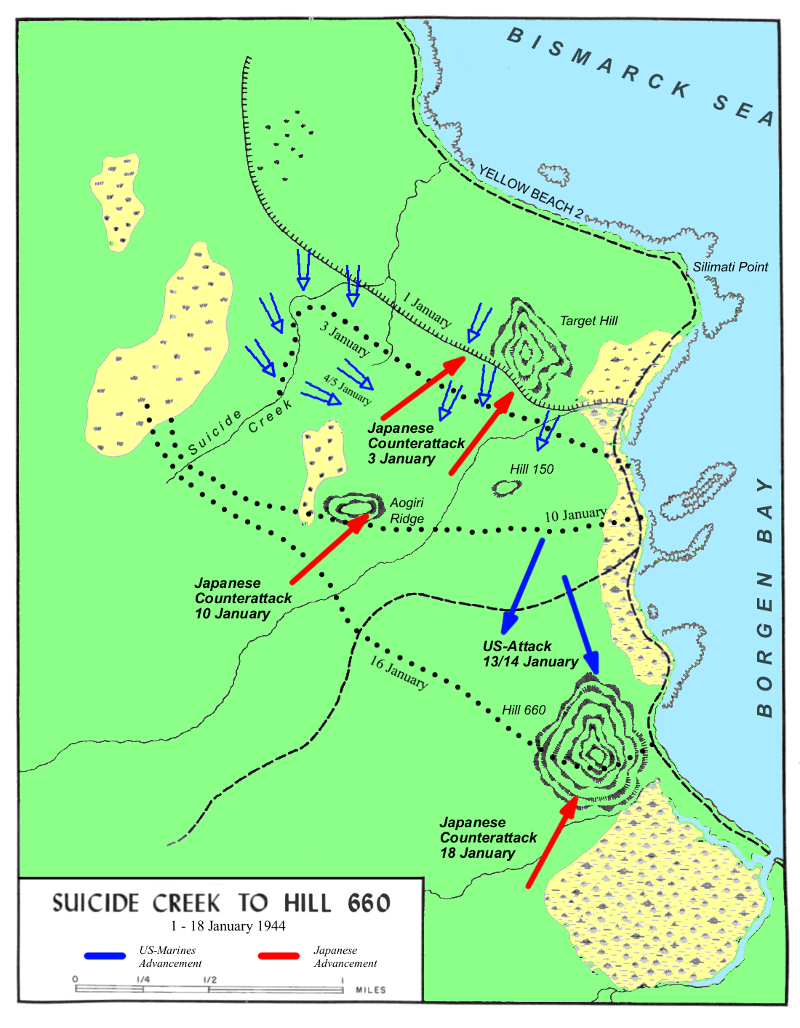
I am not going to cover the Borgen Bay battle in depth in this narrative because I believe it is doubtful that Corporal Moore participated directly in the action (although he could have been involved in artillery support provided by 5/11 from their position southeast of the airport). However, of note with regard to the 11th Marines, 1/11 and 4/11 contributed greatly to capture of key high ground, including Aogiri Ridge, a strategic location that the Japanese forces had been ordered to be "held at all cost". For these efforts and others throughout the Gloucester campaign, the 11th was awarded the Navy Unit Commendation (Figure 41).
Figure 40 is a clipping from the Rocky Mountain News. It provides a real-time description of the desperate and heroic actions taken during the Aogiri Ridge portion of the Borgen Bay operation. My grandmother, as a resident of Denver, Colorado (as was Corporal Moore), saved this clipping because the battle was lead by Lt. Col. Lewis W. Walt, a resident of Fort Collins, Colorado. As the article indicates, the assistant division commander of the 1st Division, Brig. Gen. Lemuel Shepherd, later renamed Aogiri "Walt's Ridge". Walt was awarded the Navy Cross for extraordinary heroism during this battle.

Outstanding renditions of the difficulties and heroics of the Borgen Bay conflict can be found in THE OLD BREED: A History of the First Marine Division In World War II, The Campaign on New Britain, and the MARINES website.
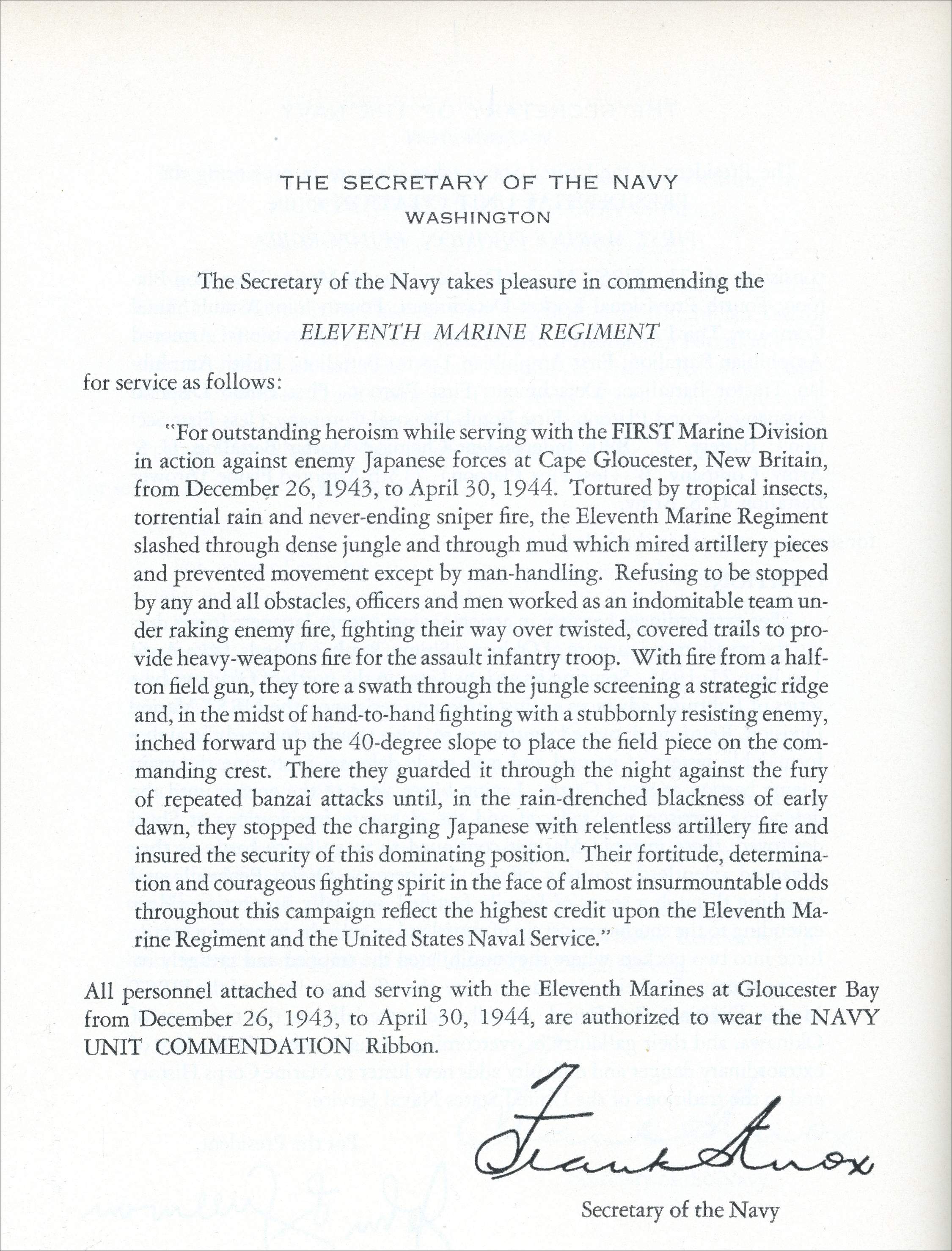
It was no fault of the artillerymen of the 11th Marines that the tall rain forest greatly reduced the effectiveness of their fires on a dug-in enemy. The alacrity with which they got their guns ashore and into position under conditions artillerymen seldom have to face surprised everyone who saw that and earned the regiment a Navy Unit Commendation, the only unit award issued for the campaign. And the effectiveness of their counter-battery work, when opportunity afforded, rendered the Japanese artillery wholly impotent.
Source: The Campaign on New BritainAs for Corporal Moore, interpreting (I admit loosely) his service record, it appears that he maintained with his artillery unit from the time they landed on Blue Beach on 30 December 1943 and subsequently set up at the airdrome, until 16 January 1944. On 17 January, his participation switched to "mopping up operations". My guess is that, if he was commandeered away from artillery support (all Marines are of the line) for duties supporting other post-airdrome operations, this entry in his service record is where that is reflected. In support of that interpretation, I recall that one of few memories my father conveyed to me about his World War II experience, was his encounter with the natives on New Britain (some of whom he characterized as head hunters) and his familiarity with and admiration for Lieutenant Colonel Lewis B. "Chesty" Puller.
As alluded to above, the second phase of mopping up operations involved "vigorous patrolling". The strategic objective of the Cape Gloucester operation was to gain control of the western portion of New Britain in order to cut off Japanese supply lines between New Guinea and Rabaul, gain control of the Dampier and Vitiaz Straits, and support Allied advances along the New Guinea coast. The seizure of the Cape Gloucester airdrome and the defeat of the Japanese forces in the Borgen Bay area were the precursors to gaining complete control of western New Britain. In order to complete that objective, it was necessary to to seek out and destroy or drive off remaining Japanese forces and establish control of all terrain defined as west of a line from Borgen Bay to the Itni River. A two-prong approach was adopted for this mission.
The first prong evolved into a pursuit of withdrawing Japanese forces along the coast from Borgen Bay eastward. During initial mopping-up operations, 1/5 patrols inland and along the shore from Borgen Bay encountered heavy automatic weapons fire from Natamo Point (Figure 43), resulting in 3-day fight until the point was captured. Meanwhile, other patrols further inland encountered pockets of resistance and significant abandoned Japanese positions. These encounters convinced division intelligence officers that they were dealing with rear guard action protecting the retreat of General Matsuda and the main Japanese body. The problem was in determining in which direction the retreat was taking place. The observed tendency of Japanese retreat up to that point had been to the south and so 1st and 5th patrols were sent in that direction. However, encounters with straggling and sick Japanese soldiers, intelligence provided by natives, and capture of Matsuda's actual withdrawal orders at his former headquarters near Nakarop, convinced Division Headquarters that the withdrawal route was the Asisalmipua-Kakumo Road toward Borgen Bay and Cape Gauffre. (Figures 42 & 43). Subsequently, this was further verified by 1st Marine patrols in the Old Natamo area on 1 & 2 February when they encountered evidence that a Japanese force had passed through recently.
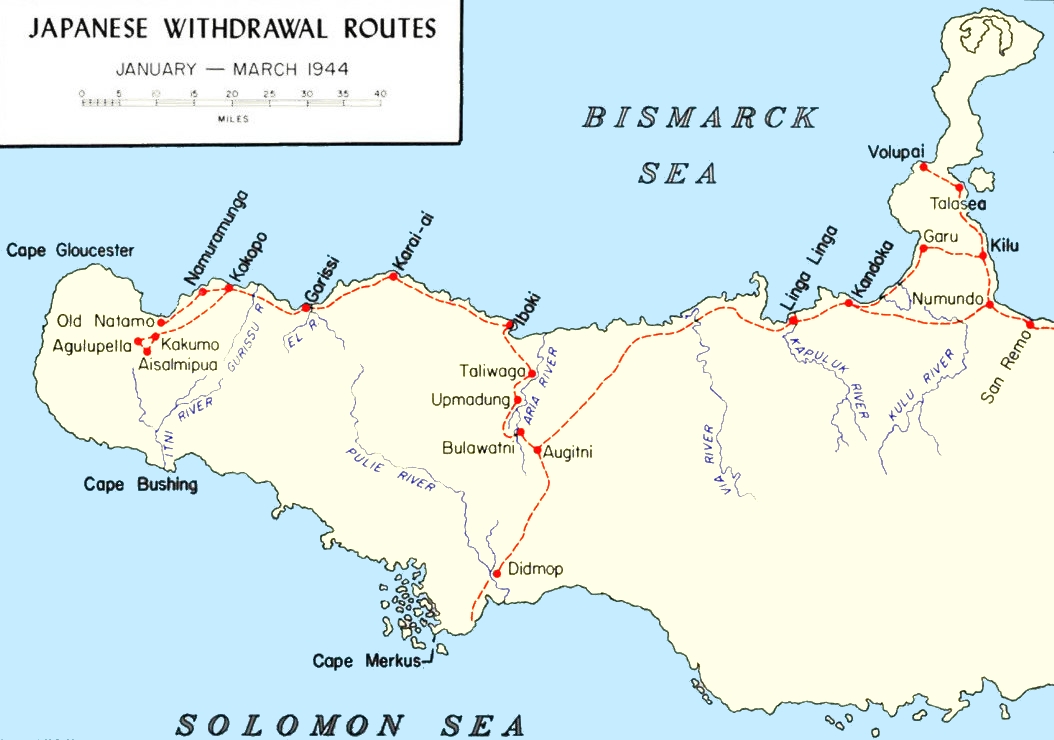
Once the coastal retreat route had been established, the 5th Marines took over the pursuit. This was accomplished by the use of LCM's along the coast to leapfrog Marines ashore in order to conduct patrol operations at various points in an eastward direction as far as Iboki. Iboki had been designated in Matsuda's captured orders as the final destination for the withdrawal. Although Matsuda had apparently been evacuated a number of days prior to the Marines arrival at Iboki on 24 February, the operation was considered a remarkable success in that:
For the first time in the history of the 1st Mar Div a reinforced regiment had conducted a shore-to-shore operation along the coast of enemy-held territory. Using only 10 LCM's and jungle trails they transported and marched 5000 men with their intendant supplies and equipment, for a distance of 60 miles around and over some of the worst jungle terrain in the world.
Source: The Campaign on New Britain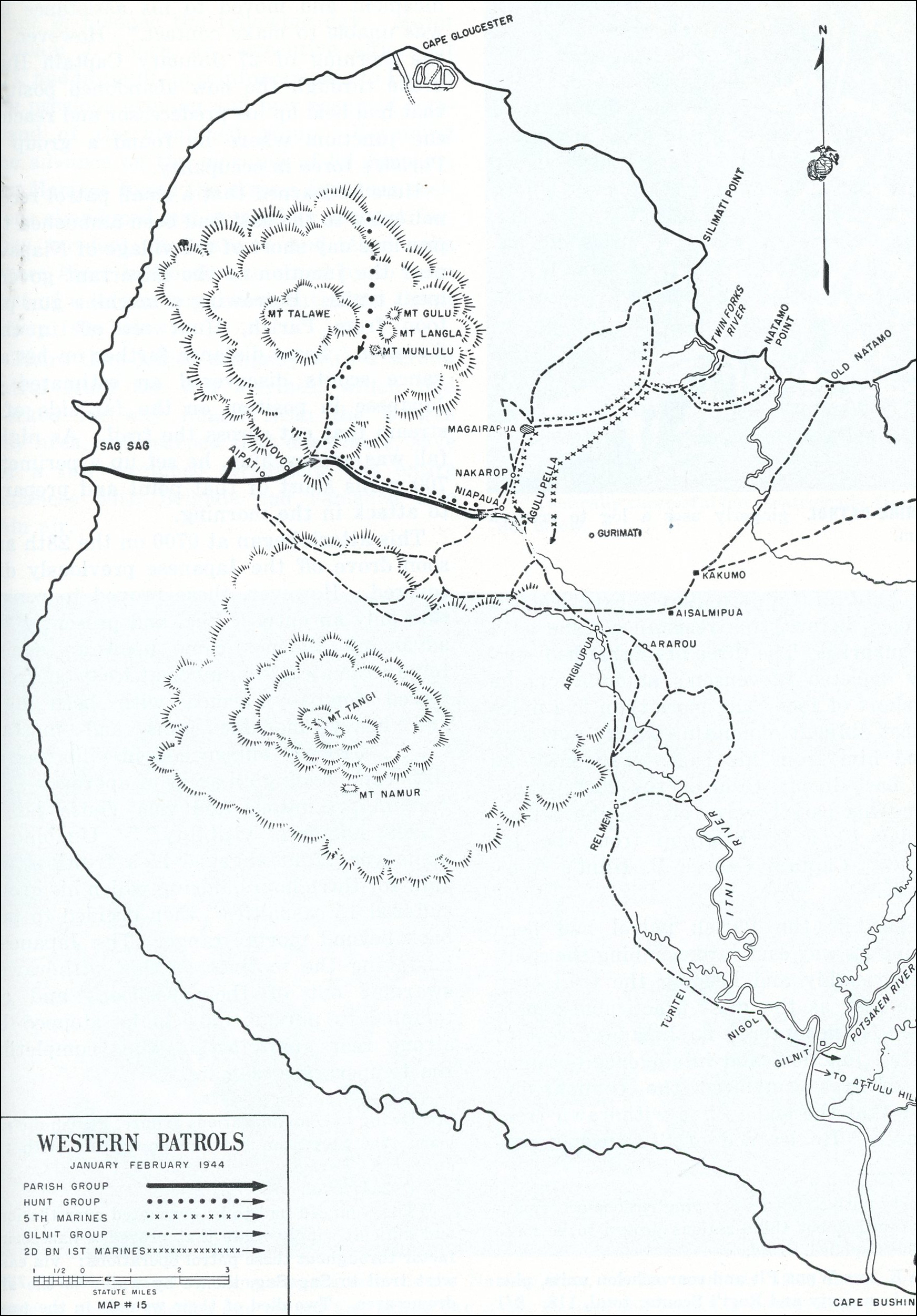
The second prong of the mopping-up operations was directed inland south of the airdrome toward main routes over which Japanese survivors were believed to have retreated after defeats at the airdrome and Borgen Bay. After establishing a defensive perimeter south of the airdrome, numerous patrols had been sent out to evaluate the Japanese presence and to identify major supply and escape routes that the Japanese forces had established during their occupation. In the course of these patrols, only a few relatively small enemy concentrations had been encountered, resulting in short fire fights. However, on January 19th one of the patrols found a major east-west trail that intersected the main north-south trail at a village called Agulupella (Figure 43).
It was decided that a large patrol group would be assembled at Agulupella and proceed southward toward a native village named Gilnit. The objective of the Gilnit Group, as the patrol was so named, was to accomplish the secondary mission assigned to the 1st Division by clearing out the enemy west of a line from Borgen Bay to the Itni River at Gilnet and thereby secure all of western New Britain. Lieutenant Colonel Lewis B. Puller (Figure 44) was assigned to lead the patrol.
From THE OLD BREED: A History of the First Marine Division In World War II:
What Division had in mind now was a cross-island patrol, a long affair, to be out there for, say, thirty days on your own, never knowing when you'd run into a parcel of Japs, moving through country that perhaps no white man had ever touched before, the kind of thing to catch the imagination and to lift the minds of the men out of their doldrums.
The choice of a leader for such a mission was obvious.
Chesty Puller: Lieutenant Colonel Lewis B. Puller, executive officer of the 7th Marines. Chesty of the jut-jaw and rasping voice. Chesty, who had been a captain in the Haitian Gendarmerie (though an enlisted Marine), and who had been flunked out of the Navy's air school at Pensacola on this comment from his instructor: "Glides flat. Skids on turns. Climbs too fast." Chesty, the man who asked, after seeing a new type flamethrower demonstrated, "Where do you put the bayonet on it?" Chesty, whose perspective of the high reaches of command got so blurred that he persisted in calling the top commander in the Pacific "Nitmitz." Chesty, who had never to this day in January 1944, allowed the sawbones to cut out the shrapnel he still carried in his legs from Guadalcanal.
Chesty, who only a couple of weeks ago when his regiment was holding a perimeter around Hill 660 had taken a staff officer and made the trip around the whole length of the line, walking outside the barbed wire, in the no-man's land between the Japs and Marines, pausing at every emplacement to ask: "How's things going, old man?"
And the officer who went with him, remembering the effect of Puller's visitation: "Christ! Chesty might as well have been handing out five-thousand-dollar bills with the guys having some place to spend it!"
Chesty, who could take without rancor the answer he got from one of the woebegone men: "We ought to get the hell out of here, Colonel!"
Chesty, who could reply: "That's no way to talk, boy."
And the boy, looking into the distance with the thousand-yard stare, repeating: "I'm telling you Colonel, we ought to get out of this hole."
Chesty, who did suggest: "Come on out back, boy, and let's talk."
And Chesty, who could sit there in the mud and say simple, reassuring things, like: "I wanna go home too. I'm not getting any younger either. This place is no good. I know it. But neither one of us is goin' home till these bastards are licked. I'll try to get you some hot chow up here."
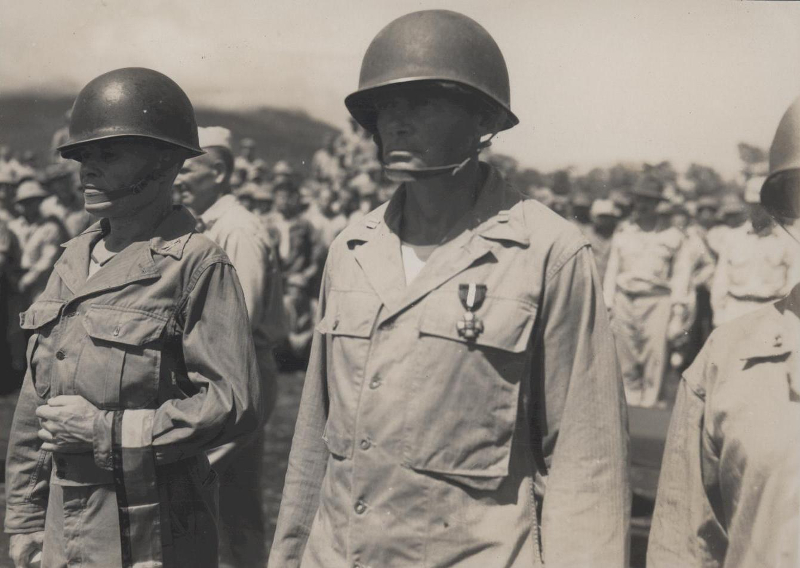
Initially, the Gilnit Group was comprised of 1,398 men assembled from units of the 5th and 7th Marines, and a headquarters attachment made up of intelligence personnel from regimental and division levels. This force was augmented by three Australian officers and 150 native carriers.
While the patrol readied itself at Agulupella, Colonel Puller sent out patrols to the south and southeast to assess the presence of enemy forces in the vicinity of the proposed route to Gilnit. No significant enemy resistance was encountered.
Meanwhile, it was becoming obvious that the logistics of supplying a patrol the size of the Gilnit Group would be extremely difficult. The initial plan was to bring supplies in via LCM from Cape Gloucester to Sag Sag and then overland to Agulupella. This proved to be untenable because of the constant rain and subsequent muddy conditions along the overland trail.
B-17 airdrops were also attempted but proved to be unsatisfactory because of inaccurate delivery owing to the high altitudes the bombers were forced to fly at.
Because of the apparent lack of enemy presence along the patrol route, and the difficulty resupplying such a large force, division decided to reduce the size of the patrol and accomplish resupply using small cub planes (which proved be effective for the duration of the Gilnit patrol).
After adjustment, the Gilnit Group numbered 384 Marines and retained the Australians and the native carriers. The Marine contingent was comprised of two reinforced companies - one from the 7th and one from the 5th Marines. In addition, it included elements of the 11th marines, the 17th Marines, and division headquarters.
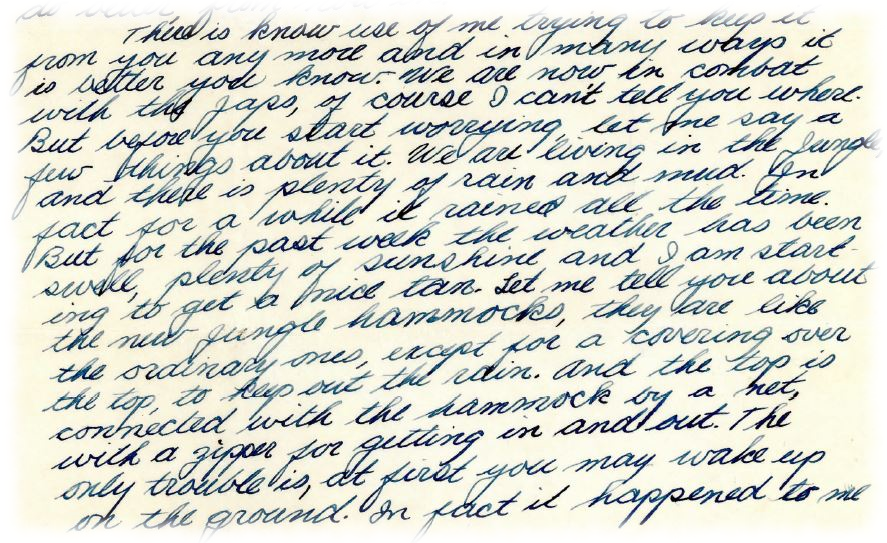
Note: Corporal Moore participated in "mopping up operations" on Cape Gloucester from 17 January 1944 to 4 May 1944. The Gilnit Group began to assemble at around the middle of January 1944 and Colonel Puller arrived to take charge on January 30. The Gilnet Group included elements of the 11th Marines as well as a contingent of native carriers. My Dad spoke with me about his familiarity with Puller as well as the local native population. As mentioned above, these factors tend to support the possibility that Corporal Moore was indeed a member of the Gilnit Group.
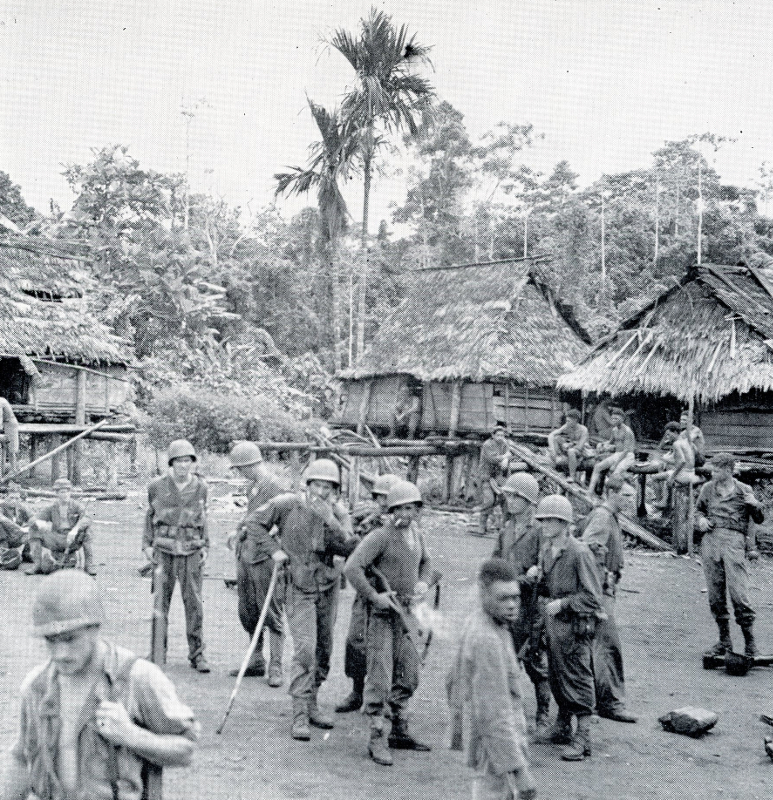
On 6 February 1944 the Gilnit Group formed into two sections and headed south. The two sections leapfrogged each other as one section explored side trails while the other proceeded down the main trail. The trail led in and out of steep gullies and crossed numerous tributaries. The continuous rain added slippery mud making the trek difficult for everyone, especially the ammunition carriers. The map they were following was found to contain numerous errors which had to be corrected as they proceeded.
The patrol came across abandoned enemy bivouac areas, supply dumps, and occasional enemy stragglers. One discarded pack contained a large and dirty U.S. flag. At Nigol, the last village before Gilnit, they came upon a small coconut plantation on a gentle slope leading down to the Itni River. Here the Japanese had established a supply base with numerous abandoned tents still standing and containing blankets, numerous documents, quantities of ammunition, weapons ranging from 75mm guns to .25 caliber rifles, cases of seaweed, and sacks of rice, barley, and soy bean flour.
Advanced elements of the patrol reached Gilnit on 9 February followed by the arrival of the rest of the patrol the next day. Colonel Puller set up a bivouac on the west bank of the Itni across from Gilnit and sent a small patrol in an abandoned boat over to the village. Gilnit was found to be abandoned and all signs of the Japanese were at least a month old.
To establish a western contact with the Gilnit Group and augment their supplies, division ordered a rifle platoon from 1/7 to proceed from Cape Gloucester by water around the western tip of New Britain and up the Itni from its southern estuary. The platoon arrived at the Gilnit bivouac on 14 February and returned to Cape Gloucester two days later. On 16 February, the same day that Puller began the march back, an army patrol from Arawe succeeded in establishing contact by a detachment of boats up the Itni, closing the southern-most portion of the Borgen Bay-Itni line.
The Gilnit Group arrived back to the Cape Gloucester area on 18 February. Although they did not encounter significant enemy forces during their patrol, they did accomplish their mission of clearing western New Britain of enemy forces from Borgen Bay to the Itni. Along the way they proved the effectiveness supporting operations through air drops, rehabilitated 1,700 natives, killed 75 Japanese, captured one prisoner, and destroyed extensive quantities of enemy weapons and equipment.
In addition to securing western New Britain, the First Marine Division would continue mopping-up operations to the west on Rooke (Umboi) Island lying off the western tip of New Britain, and, most notably, to the east in the advance from Iboki to the Talasea airdrome. I have no indication or reason to believe that either the 5th Battalion/11th Marines or Corporal Chuck Moore, participated in those operations.
The success of the Gilnit patrol and the other mopping-up operations that took place after the capture of the Cape Gloucester airdrome is summarized in a article by the U.S. Naval Institute:By 21 January, Japanese forces in western New Britain were under orders to withdraw to the east. The Marines pursued them vigorously with patrols ranging from six men to as many as a reinforced battalion. The breakdown of Japanese logistics and medical services shattered their normally fierce comradeship. Scarcely a mile of the region's interior trails was unmarked by rotting corpses and prone, pathetic abandoned soldiers, sick with dysentery or malaria or rotting with fungal infections. Some stoically waited to see their first American before blowing themselves up with a hand grenade. But the Marines captured an unusually large percentage of these men before the Leathernecks were relieved by Army troops in May and left New Britain to recuperate and retrain.
Source: U.S. Naval Institute - Waging War in a Rain ForestThe taking of the airdrome at Talasea and the clearance of Japanese opposition there on March 9, 1944, ended serious Cape Gloucester combat operations for the First Marine Division. However, General MacArthur was reluctant to allow the First to depart until the campaign against the Japanese at Rabaul was completed. In a series of not altogether pleasant messages exchanged between Admiral Nimitz and General MacArthur, Nimitiz convinced MacArthur to order the Army's 40th Infantry Division to provide relief for the First.
There was an unexpected visitor at Gloucester on April 17. That afternoon a cruiser (Nashville) hove into view, the largest naval vessel anyone had seen thereabouts since December. And about dusk word came from the beachmaster that General MacArthur was ashore. He soon arrived at Division CP.
"The General shook hands all around," recalls a man who was there. "He was very affable and gave you the impression that he was very glad to see you again (although he had never seen you before). The handshaking and the pictures (the General brought photographers with him) did not take two minutes. The party then departed for the beach to reembark. This was General Macarthur's first and last visit to Cape Gloucester during the time the First Marine Division was there."
Source: THE OLD BREED: A History of the First Marine Division In World War IIA week after the McArthur visit, Division units began to board ships departing Gloucester. By May 5 the last of the First Marine Division had left.
Marine losses during the execution of Operation Backhander were 310 killed and 1,083 wounded. Reflecting the difficulties encountered in the course of warfare in the oppressive jungle environment, an estimated 50 of those casualties were inflicted by falling trees. Japanese casualties numbered around 4000, the overwhelming majority of those killed.
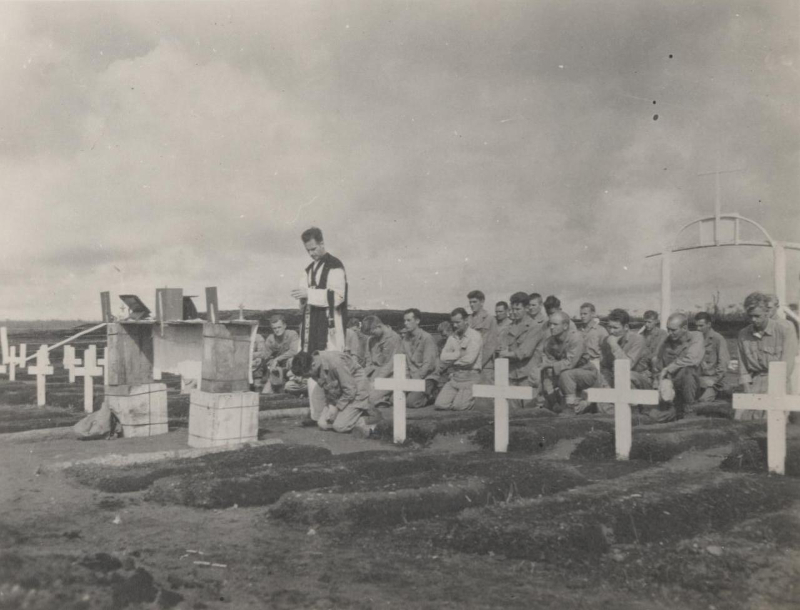
Note: The following slides are Cape Gloucester photos annotated as "Official U.S. Marine Corps Photo". Also listed on the backs, in most cases, are the names of the Marine Corps photographers and the descriptions that they presumably provided at the time:
- Sgt. George Sylvester (sp?)
- Sgt. Robert M. Howard
- Sgt. Robert R. Brenner
- Sgt. Johnson
- Cpl. Gerald
- Pfc Robert F. Hallahan
- Sgt. Lawrence M. Ashman
- Cpl. T.D. Ganbill (sp?)
The descriptions I have provided with each slide are exactly as written by the photographers. No doubt these photographers carried rifles and were frequently involved in combat action as "Marines of the line".
On 4 May 1944, Corporal Moore completed his participation in the Cape Gloucester campaign and no doubt looked forward to leaving the island's hellish environment for some R&R in a much more pleasant location.
Many Marines, cherishing fond memories, had hoped throughout the campaign that they would return to Australia when it ended. But it turned out they were headed for a very different sort of place.
Source: The Campaign on New BritainPavuvu
The scuttlebutt towards the end of the Gloucester campaign was that the First was in line for a period of rest and recuperation before their next assignment and that the location for that R&R would be Melbourne, Australia where many of the Marines, including Corporal Moore, had been training prior to joining the First at Cape Gloucester. Rumor was that General Rupertus had declared that to be the case.
The necessities of the war, however, dictated that an excursion out of the Pacific theater to Melbourne was not a practical R&R option. Guadalcanal (by 1944 a large base and Corps headquarters) was considered but was eliminated because of the potential for the First Marines to be assigned to daily work parties by the Guadalcanal Island Command as had happened to the Third Division when they were deployed there for R&R. The Corps command recognized the toll paid by the Division in the Guadalcanal and Cape Gloucester campaigns - losses in killed and wounded, undernourishment, malaria, jungle rot dysentery, and mental exhaustion - so staff officers were assigned to scout potential locations within the Pacific theater where Division Marines could truly recuperate, both physically and mentally, while organizing and training for their next assignment. The officers given the assignment made the decision that Pavuvu Island, part of the Russell Islands not far from Guadalcanal, would be a great place for some well-earned R&R.

3rd Battalion/11th Marines On 5 May 1944, Corporal Charles Moore embarked aboard the USS President Adams in Cape Gloucester, New Britain and disembarked on 7 May at Pavuvu, Russell Islands, Central Province, Solomon Islands. On the day of his arrival at Pavuvu, Corporal Moore learned that 5/11 had been disbanded and he had been reassigned to the 3rd Battalion, 11th Marines, 1st Marine Division, FMF (105 mm M2A1 Howitzers).

Also upon arrival at Pavuvu, Corporal Moore and the rest of the Marines of the First Division came to the realization that Pavuvu was not the graceful shorelines and symmetrical rows of palm trees that imparted the impression of calm and order to the officers who recommended it based only upon an aerial reconnaissance. Rather, it turned out to be an abandoned series of bombed-out coconut plantations strewn with rotten coconuts and infested with rats and land crabs. Instead of R&R, the Marines were to spend much of their time trying to make the island livable.
Civilians and European-theater veterans thought of South Pacific island "rest areas" as enticing beaches; vivid, multi-hued blossoms amid lush, green flora and fauna; the pristine tints of a tropical sunset or sunrise; and perhaps fervid mental images of amorous entanglements with lithe and willing native damsels. They never heard of Pavuvu, the one six-letter obscenity in the lexicon of 1st Marine Division veterans of World War II.
The "straight scoop" rumor that swept the division's ranks on departure from New Britain affirmed a universe governed by a just moral order: The bedraggled unit was headed back to Melbourne. But instead of Melbourne—and justice—the 1st Marine Division got Pavuvu. The largest of the Russell Islands, it rests 60 miles north of Guadalcanal and measures at most 8 miles wide and 1,500 feet tall. A huge coconut plantation organized the island into symmetrical ranks of palms. It looked quite reasonable from the air—and it was from the air that staff officers of the III Amphibious Corps, to which the 1st Division had been assigned, picked Pavuvu, primarily because Guadalcanal was already crowded with American installations.
For four years those neat rows of palms had indiscriminately bombarded the ground with unharvested coconuts. The hairy, shelled missiles rotted and then dissolved under rains that continued far beyond nature's normal cycle in 1944 to turn the ground into a mush best navigated barefoot. For accommodations, the division was issued cots (frequently rotted) and pyramidal tents (still more frequently riddled with holes). Every imaginable material found employment in getting personal gear off the ground, but individual Marines learned that only coral gravel existed in enough quantity to floor most tents—after work details first paved company streets.
Initially there were no lights, no mess halls, and no recreation areas on Pavuvu, as well as no adequate supply of fresh food. The menu was officially called "B," which in fact was like a warmed version of "C" rations—the minimum sustenance. Bathing was done naked in the open with hopes both lathering and rinsing could be completed before the fickle rains that supplied the shower ended. The island also lacked adequate training space, particularly after firing ranges were established. Maneuvers of units larger than a company inevitably overlapped terrain occupied by some essential function created by the Marines.
Then there were the rats and land crabs. Rodent raiders seemed to mass at night for close-order drill across tent tops. When they became bored, they fell out with squeals to scamper down the sides and ropes. Great ingenuity went to devising means of rat control, from individual traps to on one occasion a mass flamethrower hunt. The rats at least evoked some grudging respect for their nerves and agility; the slimy land crabs provoked nothing but disgust.
"You could almost hear the noise that loneliness made as it came crashing through the grove at sunset," noted the division historian. Anyone who sought solitude at night was recognized as sick. Instead, with rituals that would have filled the notebooks of an eager anthropologist, Marines organized themselves into small groups of friends. The one great shared recreation was an ad hoc movie amphitheater. Hollywood's best and worst enjoyed equally avid attendees. When well-proportioned actresses appeared, the projectionists learned to halt the film and back it up to reshow the scene three and sometime four times.
Veterans retained just one joyful memory of Pavuvu: Comedian Bob Hope made an extraordinary effort to put on a show there for them they never forgot.
Source: U.S. Naval Institute - No Pacific Paradise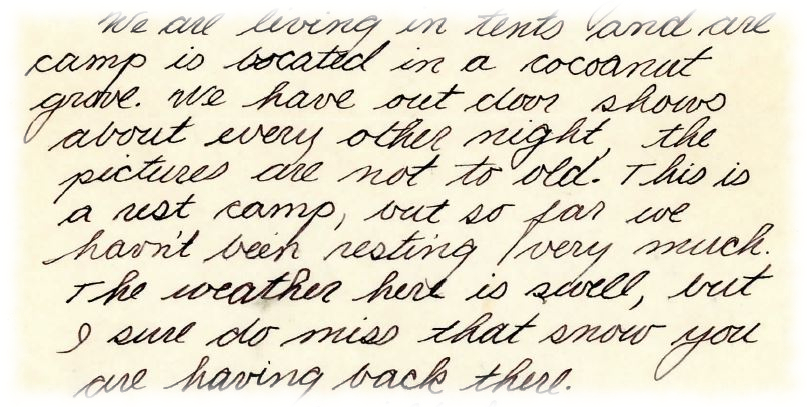
Note: The terms shell shock (WWI), battle fatigue (WWII), operational exhaustion (Korean War), and Post-traumatic stress disorder (PTSD - Vietnam War) have been used to describe the psychological consequences of exposure to the stressful, life-threatening, and traumatic experiences of war. In the Pacific campaign, the Marines had another name for PTSD: going "Asiatic". As illustrated by one incident described in THE OLD BREED, R&R did not always provide relief from "Asiatic", especially in the less than ideal environment on Pavuvu:
"We'd put our tents up and were doing a lot of sacking to avoid the ankle-deep mush. A sentry was posted along our row of tents, a fellow of about eighteen or nineteen. This kid plodded stonily for four hours, lugging his M-1. Then, being relieved, he stopped by the last tent and put his rifle to his mouth and blew the top of his head off."
"It being wet and muddy and I being in my sack, I didn't get up and walk to the end of the row, but I could hear the switchboard operator in the next tent. And I remember this is what he said to no one in particular:"
"'Now I gotta find the padre. It's getting so they won't even let a guy outa here that way without a pass.'"
In the story there is not only the tragedy of the suicide but also the self-conscious callousness of the narrator, and the forced irreverence of the switchboard operator.
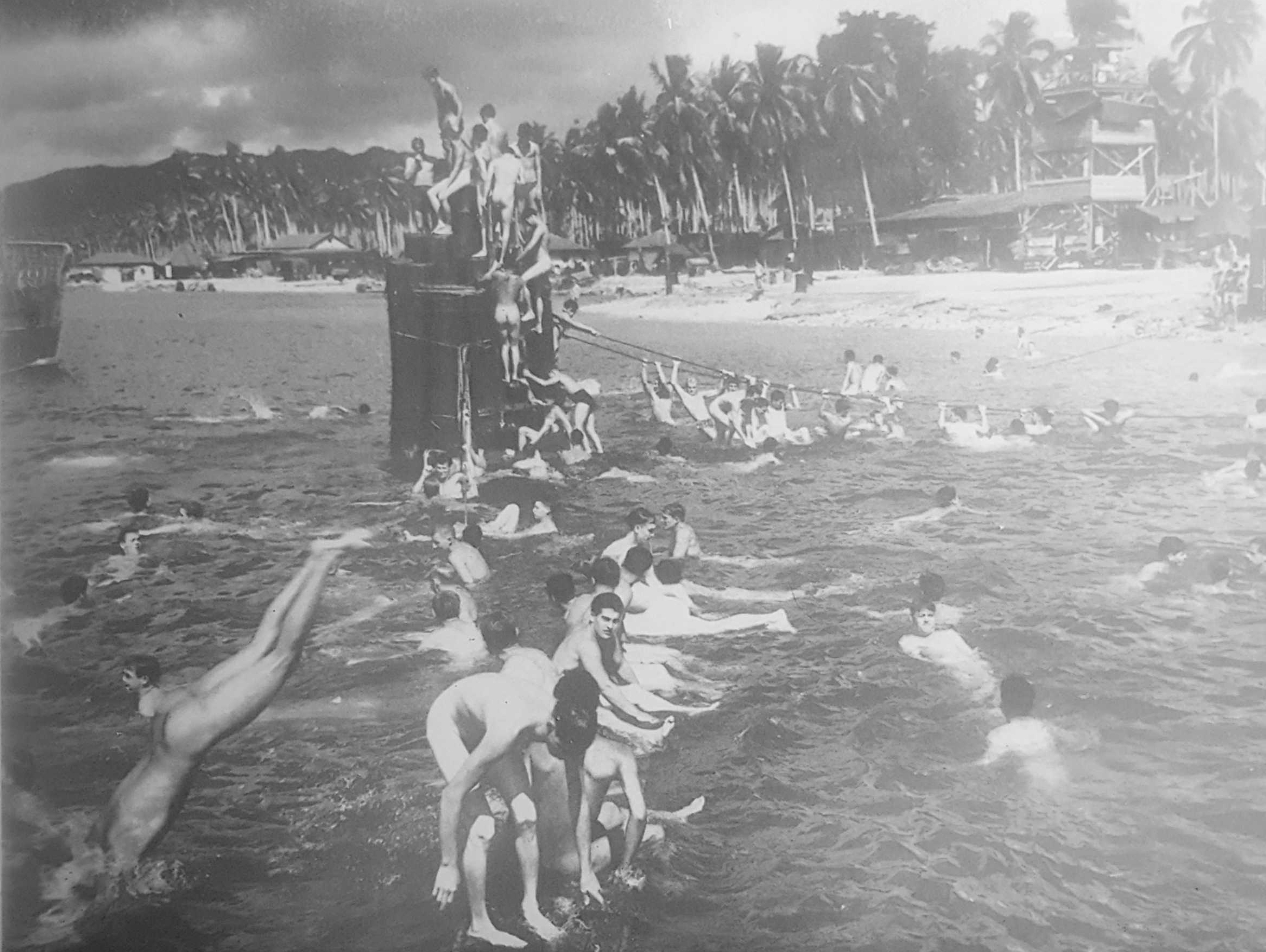
When the Marine Corps brass encountered the true conditions at Pavuvu, they really did not want to have the general public know what the First Marine Division was having to put up with as a break from two major battles, and the idea that Bob Hope would bring his entertainment troop there was initially discouraged by the Navy and the Corps. When Hope heard about the situation he was insistent that he be allowed to visit and, with the support of a few Division officers concerned about morale, he won the argument.
Somewhere around the end of July -- the day or the hour is impossible to fix -- a strange and subtle change came over Pavuvu and its inhabitants. So quietly did it come that the men themselves hardly realized it was taking place. The complaints about Pavuvu itself, if they did not lessen in volume, were uttered with a marked decrease in intensity. There was less rancor, less bitterness about the rats, the crabs, the coconuts and the chow. The men wrote fewer and shorter letters. Although no man had let his weapon go to seed, rifles, machine guns and BARs were cleaned with new care and respect. A pair of new socks took on an inflationary value in Pavuvu's barter economy, while a can of grapefruit juice fell sharply in price. Everyone began to step just a little livelier as he went about his routine tasks under the glaring sun.
It was as if some common instinct told them that the time had come to prepare for the next battle.
Source: THE OLD BREED: A History of the First Marine Division In World War IIIn addition to the abominable living conditions, training on Pavuvu proved to be very problematic. The island was too small for simulating a large-scale operation and the terrain was low and flat, and so did not afford the opportunity to conduct exercises against the kind of steep-faced repeating ridges they would encounter on Peleliu. Specific to Corporal Moore's regiment, the 11th Marines, there was a lack of amphibious equipment (the jungle and monsoons of Cape Gloucester had degraded or destroyed much of the division's equipment) and very little time was devoted to practicing loading and unloading the 75mm pack howitzers and 105mm howitzers in LVT-4s and DUKWs. For target practice, the artillery "was reduced to the pitiful expediant of firing into the water with the observers out in a boat or DUKW." (The Assault on Peleliu)
Because the geography and terrain of Pavuvu was not suitable, the final rehearsals for the assault were held at a location off Guadalcanal on August 27th and 29th. By that time all of the the assault troops were embarked on the vessels that would carry them to the target. One of these vessels was the USS Elmore which Corporal Chuck Moore had boarded at Macquette Bay, Pavuvu on August 26th.
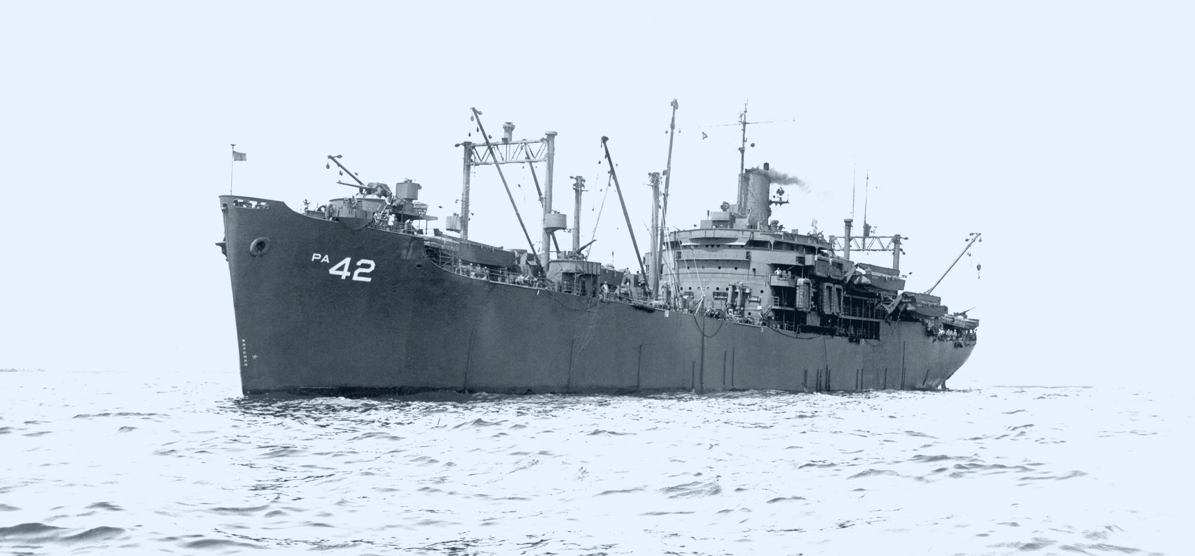
By December 8th, the transports carrying the First Division had departed Guadalcanal for the 2,100 mile journey to Peleliu.
Previous to departure from Guadalcanal, a sealed envelope had been issued to each of the civilian news correspondents assigned to cover the expedition, and to the troop commanders aboard several of the ships, marked with explicit instructions that it was not to be opened until D-minus 1, at which time the contents was to be broadcast to all hands. On the morning of 14 September, therefore, the seals were broken and the recipients learned, to the considerable astonishment of many of them, that the division's commanding general expected the operation to be very tough but very short, comparable to Tarawa, and that Peleliu should be secured within four days: perhaps the most striking manifestation of that preoccupation with speedy conquest at the highest division level which was to color tactical thinking ashore for a month to follow.
Source: The Assault on PeleliuPeleliu
After Guadalcanal, and during the time that the First Division was enjoying some R&R in Melbourne, conducting the Cape Gloucester operation, and "enjoying" another R&R break in Pavuvu, the Allied forces were busy punishing Japanese-occupied territories throughout the South Pacific Theater.
The Allies spent a year attacking the Japanese occupations at Bougainville, New Georgia, and other small islands in order to secure the Solomons (Figure 54) and clear the way for General MacArthur's plan to recapture the Philippines. Meanwhile MacArthur's Allied forces had advanced up the northeastern coast of New Guinea, eventually reaching Finschhafen by the beginning of 1944. The First Division's takeover of Western New Britain in the Cape Gloucester operation in late 1943/early 1944 served to isolate the Japanese threat from Rabaul and enabled MacArthur's forces to to continue their advance along the eastern coast of New Guinea and seize the Admiralty Islands.
In late January 1944, US amphibious forces captured Kwajalein Atoll in the Japanese-occupied Marshall Islands. On the morning of February 17, 1944, US Navy carriers, under the command of Admiral Chester W. Nimitz, launched devastating air attacks against the formidable Japanese stronghold on Truk Atoll, destroying its capacity to serve as the Japanese navy's main base in the South Pacific. The next day, a US amphibious operation captured another Marshalls island, Eniwetok Atoll, gaining complete control over the Marshalls group. In June through August, US navel forces seized the Marianas from the Japanese, with amphibious landings on Saipan, Tinian, and Guam, and defeat of Japanese air and naval forces in the "Great Marianas Turkey Shoot".
By July 31, 1944, MacArthur had reached Cape Sansapor at the western end of New Guinea. At that point, he paused his assault to replenish his supplies, and to await execution of an operation that had been planned to address an anticipated threat to the right flank of his remaining advance toward the Philippines. The threat was expected to come from the Palaus Group of the Western Caroline Islands. Specifically, a small heavily-fortified island called Peleliu (Figure 54).
Peleliu (Pel-lel-loo) is one of approximately 340 (mostly tiny) islands in the Palau group. The Palaus were considered by the Japanese to be part of the Caroline Islands. The Palaus were ceded (sold) by Spain to the German Empire in 1899 during Spain's withdrawal from the Pacific after the Spanish-American War. Japan exploited the outbreak of World War I to seize most of the German colonies in the Pacific, and their claims were legitimized by the League of Nations Mandate after the war. Included in the mandate were the Caroline Islands along with the Marianas and the Marshalls.

Babelthaup (Figure 55), by far the largest island, along with Koror, Ngesebus, Anguar, and Peleliu were the islands in the group considered to be of the most strategic importance. The Japanese had established the administrative headquarters for all of the mandated territory, including the Carolines, Marianas, and Marshalls, on Koror Island. Principal air installations were situated on Peleliu (a two-strip, hardened-surface bomber-fighter field with complete servicing facilities) and Ngesebus (an auxiliary fighter strip and building). Anguar was the primary location for a small phosphate mining industry and was considered to contain enough level ground for a potential airstrip. Babelthuap, given its rugged and jungled terrain, served as ideal base for large numbers of ground troops protected by formidable defenses, but contained only a small airstrip still under construction.
Mission Planning
In the strategic planning which began in earnest in January 1943, seizure of the Western Carolines was considered necessary in order to control the approaches to the Philippines and Japan proper. Targets included the Palaus as well as the large Japanese naval base on Truk Atoll. As the conflict in the Pacific progressed, it proved to be practicable for Allied forces to by-pass enemy strongholds both in the Marshalls and along the New Guinea coast. The destruction of Truk as a viable base for the Japanese navy and the neutralization of Rabaul as a major air threat lent further credence to this approach. Consequently, there arose some disagreement at the highest levels on the need to conduct a major assault on Peleliu versus simply bypassing it on the way to the Philippines and ultimately Japan. General MacArthur thought that the Peleliu operation was necessary for his advance and Admiral Nimitz and the Joint Chiefs agreed with him (Admiral Halsey did not). MacArthur won the argument and planning was begun for operation STALEMATE.
That doubt should be cast on the strategic importance of this seizure is unfortunate to the memory of the men who fought and died there. And that is a matter on which no definite conclusion can be reached: because the conquest was fait accompli prior to the invasion of the Philippines, no one can state with certainty what would have happened if it had not taken place. What is known is that Peleliu, together with air facilities subsequently developed on Angaur, proved exceedingly useful as a support and staging point for the Philippines throughout that lengthy campaign. Equally important, the Japanese were denied the whole Palaus chain as a base and staging area for attacks on U.S. naval shipping and lines of communication supporting the Philippines invasion.
Source: The Assault on PeleliuInitially, operation STALEMATE planners envisioned seizure of the entire Palau group but, as the planning proceeded, commitment of forces and shipping resources to the conflict in the Marianas required reducing the scope of STALEMATE operations. In addition, newly acquired intelligence cast doubt on the advisability of attacking Babelthuap, which was found to be strongly garrisoned and heavily fortified but with terrain too rugged to accommodate significant air operations. On the other hand, the aircraft facilities on Peleliu and, to a lesser extent nearby Ngesebus, were viewed to be significant threats to MacArthur's progress toward the Philippines.
Fortunately, as a result of capturing Japanese army intelligence files during the operation on Saipan, significant information was obtained regarding the organization and force levels of the enemy's Peleliu and Anguar garrisons. The files indicated troop strengths of 10,500 on Peleliu and 1,400 on Angaur. This information and the recognition that the largest island, Babelthaup, could be neutralized and bypassed by Allied air operations once the airfield on Peleliu was captured, served to narrow the focus of STALEMATE to Peleliu, Ngesebus, and Anguar where existing and potential airfields were located. The revised version of the operation was renamed STALEMATE II.
The operation was to be carried out by III Amphibious Corps (IIIAC) as the Western Landing Force and Troops, comprised of the First Marine Division (1st, 5th, 7th, and 11th Marine regiments) designated as the Peleliu Landing Force, to include Ngesebus, and the Army's 81st Infantry Division as the Angaur Landing Force. Units of the Third Fleet were assigned to covering fire and special operations and included five battleships, five heavy and three light cruisers, and 14 destroyers. In addition, eleven escort carriers were tasked with close air support, combat air patrols, and antisubmarine patrols. September 15, 1944 was scheduled as the target date.
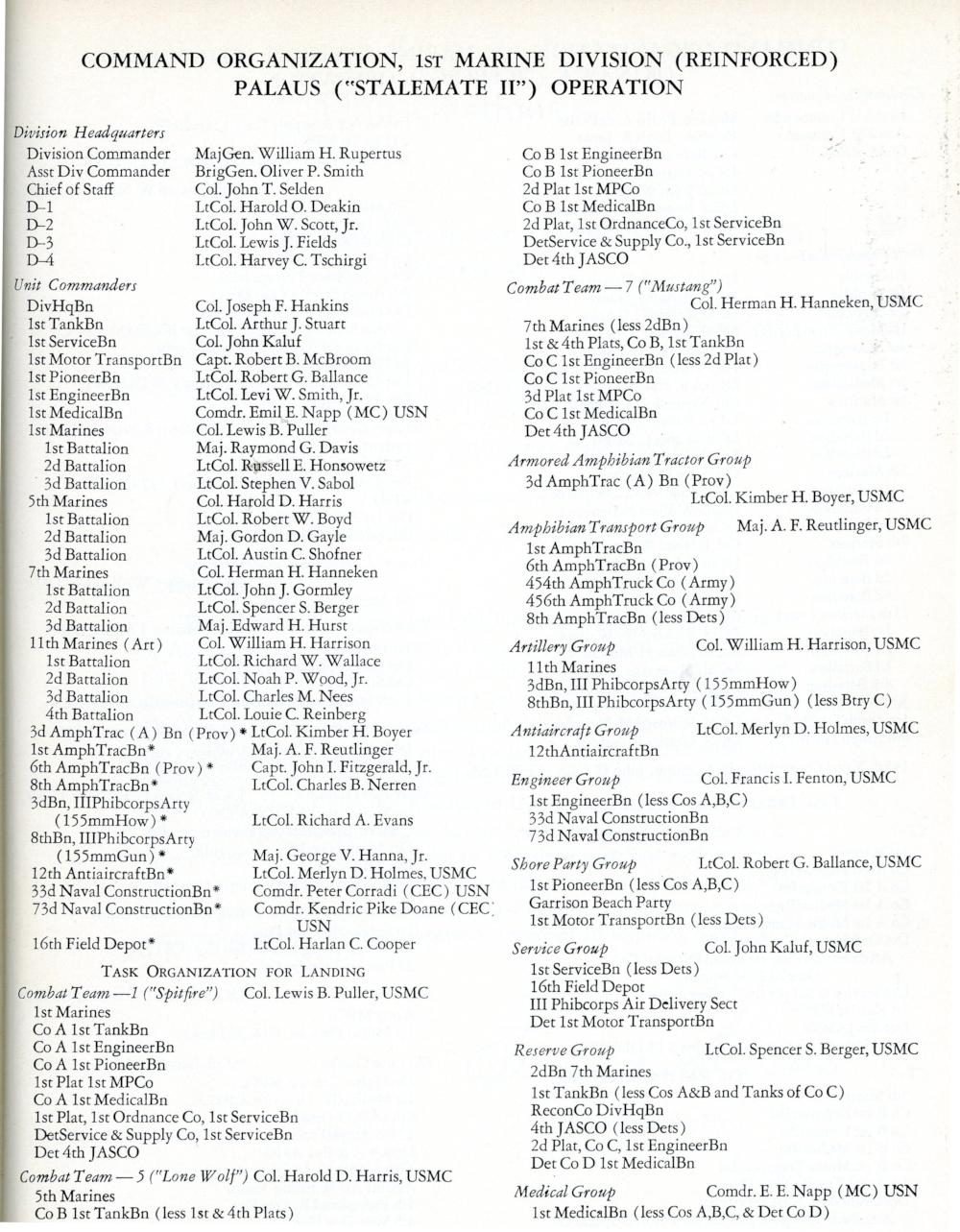
In command of the assault troops on Peleliu was Major General William H. Rupertus, Commanding General, First Marine Division. Rupertus had seen extensive overseas duty in Latin America and China prior to World War II. He was the assistant commander of the 1st Marine Division on Guadalcanal. Rupertus was known to be moody and sometimes in conflict with his subordinates. He was also skeptical of the Army's capabilities and was highly reluctant to call for assistance from the 81st Infantry Battalion which had been designated as reserve to the 1st Marine Division. These characteristics would prove to have an impact on the course of the upcoming battle.
Of additional note with regard to the command structure was the presence of Colonel Lewis B. "Chesty" Puller as commander of the Division's 1st Marine Regiment (1st Marines). Puller also had extensive overseas experience in Latin America and China (where he learned to hate the Japanese). His command of the 1st Battalion, 7th Marines on Guadalcanal won him a third Navy Cross. And, as noted above, Puller had served in a number of different roles during the battle of Cape Gloucester on New Britain and so was a familiar figure to Corporal Moore.
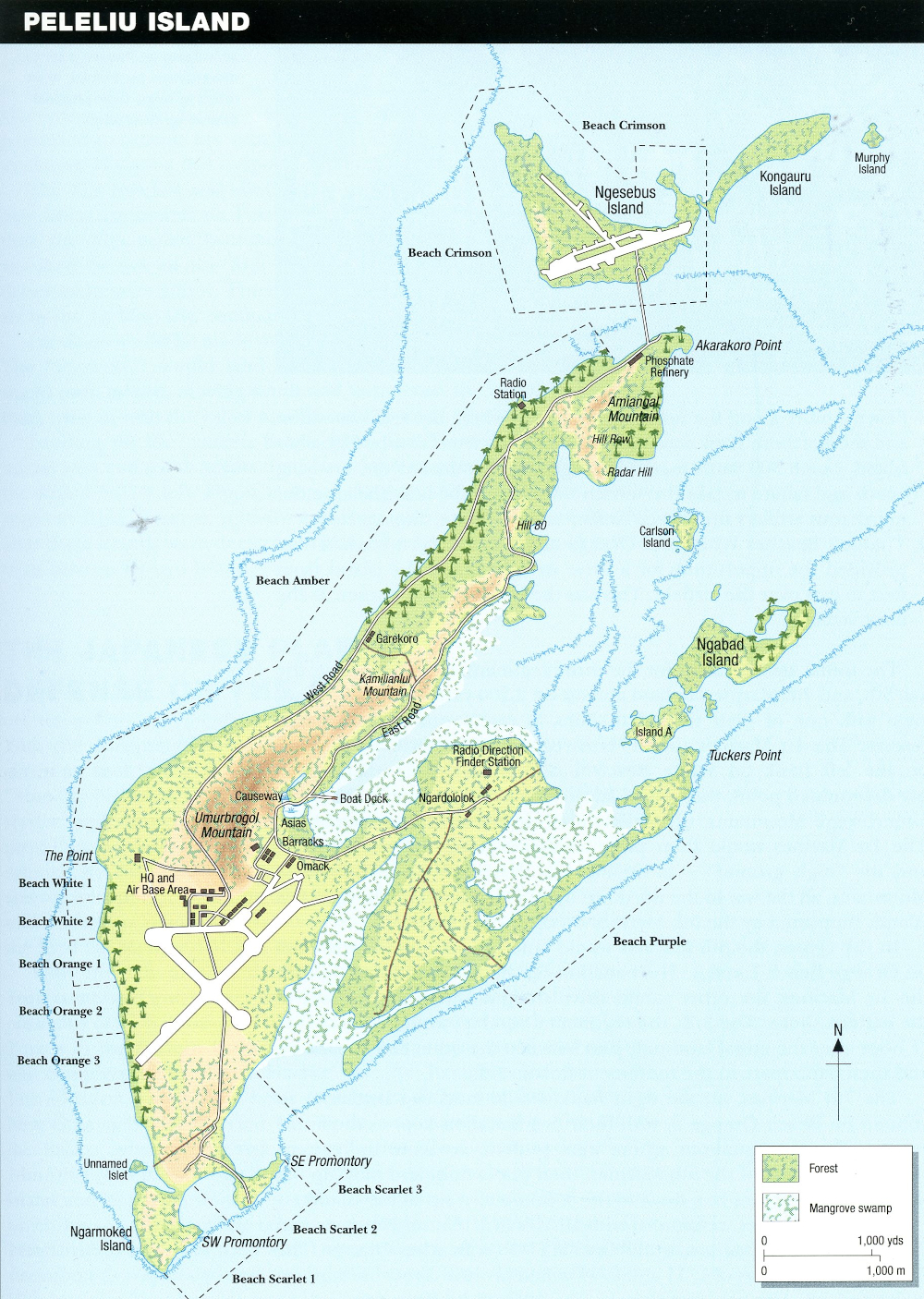
Four sets of beaches were initially considered for the Peleliu landings (Figure 57). Beach Purple had the advantage of a narrow reef with one area where conventional landing craft could be brought directly up to the beach. However, it was thought that the Japanese were anticipating that landing zone and had placed their strongest defenses there. For this reason and because there was only a narrow strip of dry ground behind the beach making it easier to defend, Beach Purple was rejected.
Beach Scarlet was rejected because landed troops would tend to converge as they moved inland resulting in the potential for casualties from friendly fire. Beach Amber was too close to possible enfilade fire from Negesbuse, and the high ground 300 yards inland from the beach would present the Japanese with the ability to direct murderous artillery fire down onto the beachhead.
Beaches White and Orange were finally determined to be the preferred option because they presented the opportunity to advance directly across the island including the airfield.
The initial assault called for the 1st, 5th, and 7th Marines to land abreast on the 2,200-yard beachhead. The 1st would come ashore on White Beaches 1 and 2, push inland, wheel left to attack the southwest end of the Umurbrogol Mountains and then, supported on their right flank by the 5th, push northeast along the coast to the northern tip of the island and on to Ngesebus.
The 5th Marines would land two battalions, one on each of Orange Beaches 1 and 2. The battalion landing on Orange Beach 1 would link with the 1st to support the advance up the northwest coast. The other 5th battalion was to drive straight across the airfield and continue to the eastern shore.
The 7th Marines would land 2 battalions on Orange Beach 3, drive across to the eastern shore on the 5th's flank, and then wheel right to address any isolated enemy forces in a drive toward the southeastern tip of the island.
In company with the 7th, the 11th Marines, including Corporal Moore's 3rd Battalion were designated to land at H+1 (1 hour after the initial landing). Their mission was as follows:
The 11th Marines, reinforced with IIIAC's 3rd 155mm Howitzer and 8th 155mm Gun Battalions, would land at H+1 on Beaches Orange. The 75mm pack howitzers of 1/11 and 2/11 would provide direct fire support to 1st and 5th Marines, respectively. The 105mm howitzer-armed 3/11 would support the 7th Marines and the like-armed 4/11 would provide general support to the Division along with the two 155mm battalions. All battalions were to be in-place by H+5 and would be prepared to concentrate their fires on the southwest end of the Umurbrogol Mountains. The 8th Battalion's 155mm "Long Tom" guns would also be positioned to provide fire support to the Army on Angaur 7 miles to the southwest.
Source: Peleliu 1944 - The Forgotten Corner of HellDuring the planning stages the islands were photographed from aerial reconnaissance aircraft, and an 11-man underwater demolition team (UDT) was landed on Peleliu from the submarine USS Burrfish (SS-312) with the mission to survey the beach conditions and fortifications. Because of the dense vegetation and the presence of thousands of Japanese on the island, neither the aerial nor the beach reconnaissance were able to detect the true nature of the rugged feature located in the island's interior, Umurbrogol Mountain(s). This was a deficiency which would later serve to greatly exacerbate the difficulty of the effort.
... these southernmost high points of the craggy limestone mass of the Umurbrogol would become known to the Marines on Peleliu by one collective, brutally descriptive name - Bloody Nose Ridge.
Source: Brotherhood of Heroes - The Marines at Peleliu, 1944 - The Bloodiest Battle of the Pacific WarThe Enemy
The loss of the Marshall Islands, and the neutralization of Truk, considered to be the "Pearl Harbor' of the Japanese Mandate, along with other Allied island-hopping successes, forced the Japanese to recognize their dire situation in the Pacific theater and the need to change tactics from offensive to defensive. The Palaus appeared to the Japanese commanders to be the next likely target in the Allies' march toward the main islands. Consequently, the 14th Division of the Imperial Japanese Army (IJA) was dispatched to the Palaus in the spring of 1944. This was an elite unit and had a long history of battlefield successes. The mission of the 14th Division was one of defense ("Absolute National Defense Zone") rather than offense, intended to help delay the Allied advance toward the homeland until a peace treaty could be negotiated.
Commander of the the Palaus Sector Group was Lieutenant General Sadae Inoue who was also commanding general of the 14th Division with headquarters on the island of Koror. The over-all commander of Peleliu was Major General Kenjiro Murai but his role in the campaign is not clear as captured Japanese orders confirmed that Colonel Kunio Nakagawa, commanding officer of the 2nd Infantry, was responsible for the design of the island's defenses and execution of the stubborn defensive tactics that so delayed the 1st Division's progress.
Nakagawa's defenses were designed to conform to the Imperial Army's revised island-defense strategy. This "defense-in-depth" concept was aimed not at winning the battle but rather forestalling the enemies' progress for as long as possible and inflicting maximum damage to enemy forces - even to the extent of the possible total annihilation of the defending personnel. The calculation was that the Allies would preference negotiation over extensive massive casualties that would likely result from an attack against similar defenses employed on the Japanese mainland.
To achieve this objective Nakagawa was directed to design defenses in accordance with guidance promulgated by Koror headquarters in its "Palau District Group Training for Victory order of July 11, 1944: "The ultimate goal of this training is to minimize our losses in the severe enemy pre-landing naval and aerial bombardment and, on the very night of the enemy landing, to take advantage of the fact that their equipment is not fully consolidated, to destroy their bridgehead at one blow...[and] carry out strong counter-attacks from previously planned and prepared positions in order to destroy the enemy that has landed..."
This Nakagawa would do to great effect, taking full advantage of the numerous coral caves and sinkholes, particularly in the area of the Umurbrogol Mountains. There were to be no mass suicidal banzai charges, but instead a long drawn-out battle of attrition, intended to bleed the Americans white. Peleliu would be the first occasion on which American troops encountered these tactics, but they would meet them again in the future on Iwo Jima and Okinawa.
Source: Peleliu 1944 - The Forgotten Corner of HellThe Japanese contingent on Peleliu was comprised of 10,000 to 11,000 Army and Navy troops including combatant, labor, and airbase personnel. In addition to small arms (rifles and numerous machine guns), they were well armed with 81 mm and 150 mm mortars and 20 mm anti-aircraft-cannons. Also present was a light tank unit and an anti-aircraft detachment. The White landing beach was flanked on the left by a 30-foot coral promontory that overlooked the beaches from a small peninsula, a spot later known to the Marines who assaulted it simply as “The Point”. Holes constructed in the promontory accommodated a 47 mm gun, and six 20 mm cannons. Those positions were closed off with just a small firing slits open to the beaches to provide vicious enfilading fire on the landing parties. Similar less-protected positions were located along the 2-mile stretch of the landing beaches.
Greatly enhancing Nakagawa's ability to deploy his defense-in-depth system was the geology of Peleliu Island. The terrain is comprised of layers of limestone formed by the growth and death of coralline algae. This coralline limestone is subject to erosion and dissolution by circulating water, resulting in a "karst" topography characterized by numerous sinkholes, fissures, and caves. Over the months leading up to the battle, Nakagawa employed the troops and construction crews comprising the 10,000 Japanese personnel on the island to convert many of the numerous natural caves into defensive positions which could withstand the initial pre-invasion bombardment and provide shelter from which to defend against and attack the invading Marines. After the battle, a survey of the island located at least 500 caves utilized by the Japanese defensive forces (Figure 58).
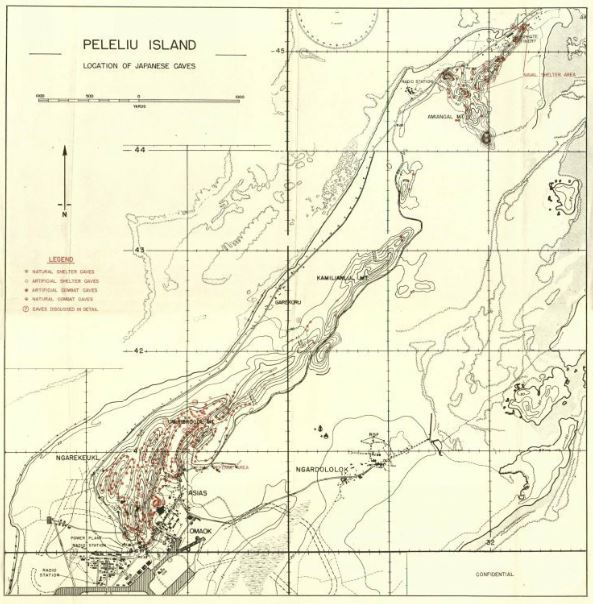
Many of the natural caves were enhanced by the construction of an elaborate series of tunnels to provide additional security and facilitate the movement of troops and equipment to various positions within the Umurbrogol. In addition to providing protection, these tunnels housed operational needs such as command posts and medical facilities (Figure 59).
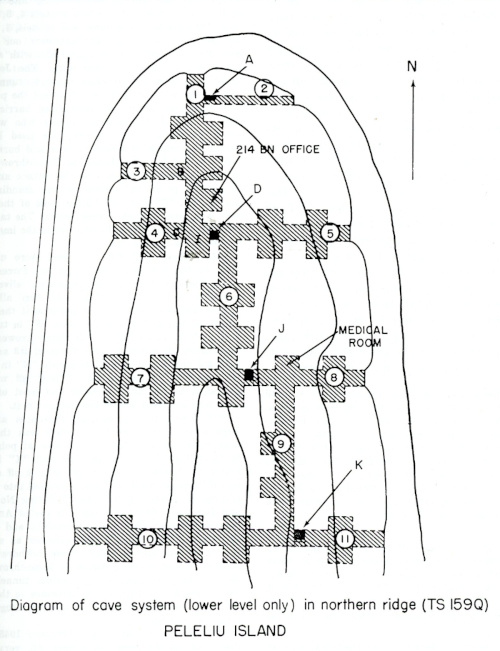
In the Umurbrogol, the Japanese Army on Peleliu had been digging “like moles” to create their defenses. Using the natural coral outcroppings that stretched over 5,000 yards from the airstrip to Hill 80 in the northern region, they constructed a “monster Swiss cheese, pocked … with caves and crevices.” Some were tiny and could only hold a lone rifleman; others were so immense they held entire battalions. Each cavern had a letter designation and was used for specific purposes. Most had several entrances and exits and were ingeniously hidden. Also, to protect the inhabitants from gunfire and the concussion of the larger shells, sharp turns and small slots were cut into the walls of many of the caves.
Nakagawa had divided the island into four defensive sectors with two battalions defending each. He anticipated that the Marines would land in the southwest section of Peleliu because of the close proximity of the all-important airstrip. It was here that he placed his heavy artillery and huge naval guns. The antiaircraft weapons and light and heavy machine guns protected the airfield. The approaches to the beaches were strewn with hundreds of mines. The island bristled with 37mm and 75mm antitank guns, rifle pits, antitank ditches, and reinforced concrete pillboxes. All of the automatic weapons had established interlocking fields of fire. Nakagawa had taken great care in establishing the island’s defenses. He was determined to kill as many Marines as possible.
Source: The Warfare History Network - The Battle of Peleliu: Shocked Beyond ImaginationD-Day on Peleliu
Leading up to D-Day (September 15, 1944), the Division had gone through maneuver after maneuver in late July and early August. During one of the landing exercises at Pavuvu, General Rupertus had badly fractured his ankle coming down the side of an amtrac but was determined to continue as Commanding General of the 1st Division for the operation. The Division completed its final landing rehearsals at Cape Esperance, Guadalcanal and the feeling among the troops was that the campaign would be short and tough. This seemed to be confirmed by General Rupertus during a critique of the last rehearsal at Guadalcanal: "We're going to have some casualties," he said, "but let me assure you this is going to be a short one, a quickie. Rough but fast. We'll be through in three days. In might take only two."
In the weeks prior to D-Day, underwater demolition teams were deployed and did an effective job of clearing underwater obstructions and blasting pathways through the reef, often under continuous Japanese small arms fire. Early in the morning on September 12, 1944 (D-Day-3), the Peleliu Fire Support Group, lead by Admiral Jesse Oldendorf, commenced the pre-invasion bombardment of the island. The Group included five dreadnought-class battleships (Pennsylvania, Idaho, Maryland, Mississippi, and Tennessee), eight cruisers, twelve destroyers, seven minesweepers, fifteen landing craft converted to rocket launchers, a half-dozen submarines, and the aerial capabilities of three heavy aircraft carriers and five escort carriers. The bombardment alternated between naval gunfire, and aerial attacks. Aerial reconnaissance at the end of the first day indicated that some 300 assigned targets, including above- and underground-targets and the airfield runways and aircraft had been destroyed or severely damaged. However, it was noted that no return fire had been received and that concentrations of heavy enemy artillery were nowhere to be seen - likely because they had been moved underground.
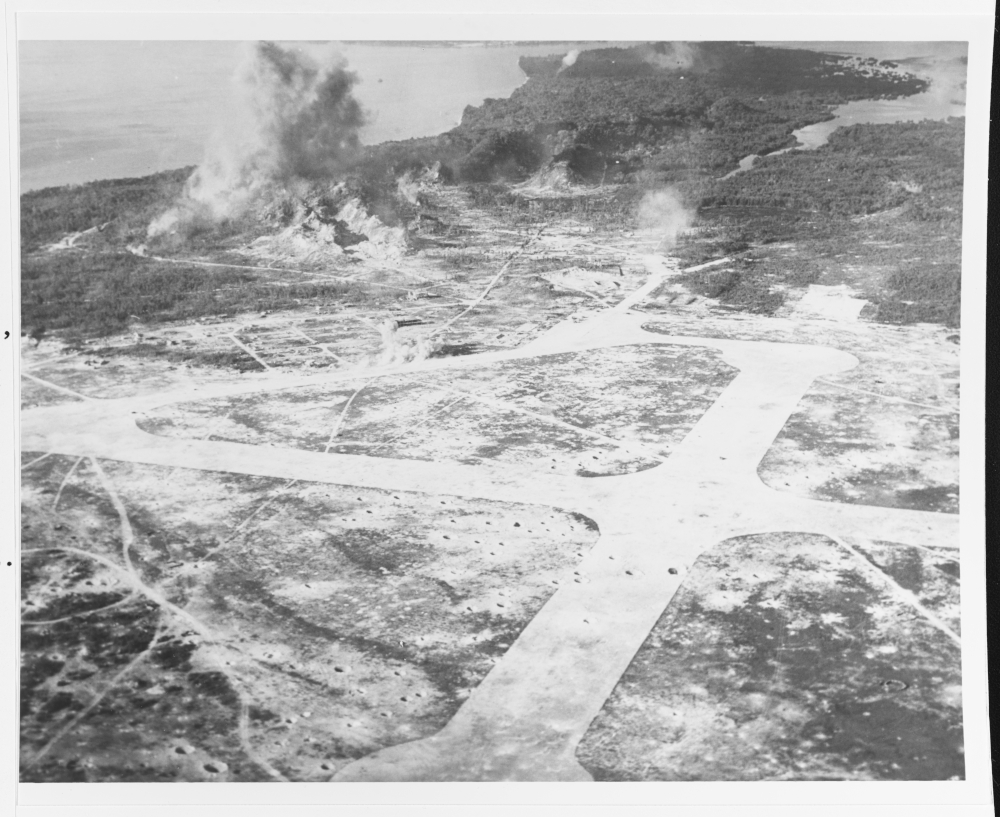
Also of note was that the bombardment had blasted and burned away much of the dense foliage in the targeted areas revealing that, what was thought to be a relatively broad flat highland (Umurbrogol Mountain), was actually a "profusion of steep cliffs, tortuous coral outcroppings, and yawning ravines that hadn't been visible 24 hours earlier" (Brotherhood of Heroes).
The bombardment continued throughout D-Day-2 even though by midday every specified target had been struck repeatedly. That evening, after conferring with staff and superiors, Admiral Oldendorf declared that the fire support group had "run out of targets" and he had called off the third day of bombardment - perhaps because he believed all targets had been destroyed or that a further day of air and sea attacks could do no further damage to the heavy weapons that had likely moved underground.
Colonel Lewis B. Puller, the same "Chesty" Puller who had impressed Corporal Moore on Cape Gloucester, and who was now in charge of the 1st Marines for the Peleliu operation, had been observing the bombardment from one of the LSTs. He was focused on a location designated as the "Point" which stood 30 feet above the north end of White Beach 1 - the landing area assigned to the 1st. In recognition of the threat this strategically located high ground presented to his battalion, he sent a message to Olendorf's staff that it needed special attention. He was assured that his request would be granted but, despite firing 519 sixteen-inch rounds and 1,845 fourteen-inch rounds at Peleliu, and dropping nearly 1,800 500-pound bombs on the island, by the end of the second day of bombardment the Point was virtually untouched. This failure would prove to be catastrophic when fierce and devastating enemy enfilading fire from the Point would rake the landing beaches during the assault.
On D-Day, the pre-landing bombardment began at 0530hrs with naval gunfire on the beaches alternating with carrier-borne aircraft strafing the beaches while naval gunfire shifted to targeted locations inland. The plan was for the first assault waves to be LVTs (Landing Vehicle, Tracked - "amtrac") which would then return from the beaches to transfer Marines from waiting LCVPs (Landing Craft, Vehicle and Personnel known as "Higgins" boats) and then turn back toward the beaches for another assault. This plan was slowed when previously quiet Japanese artillery and mortar fire (untouched by the pre-assault bombardment) opened up on the approaching amtracs and disabled or destroyed many of the them (26 were destroyed on D-Day).
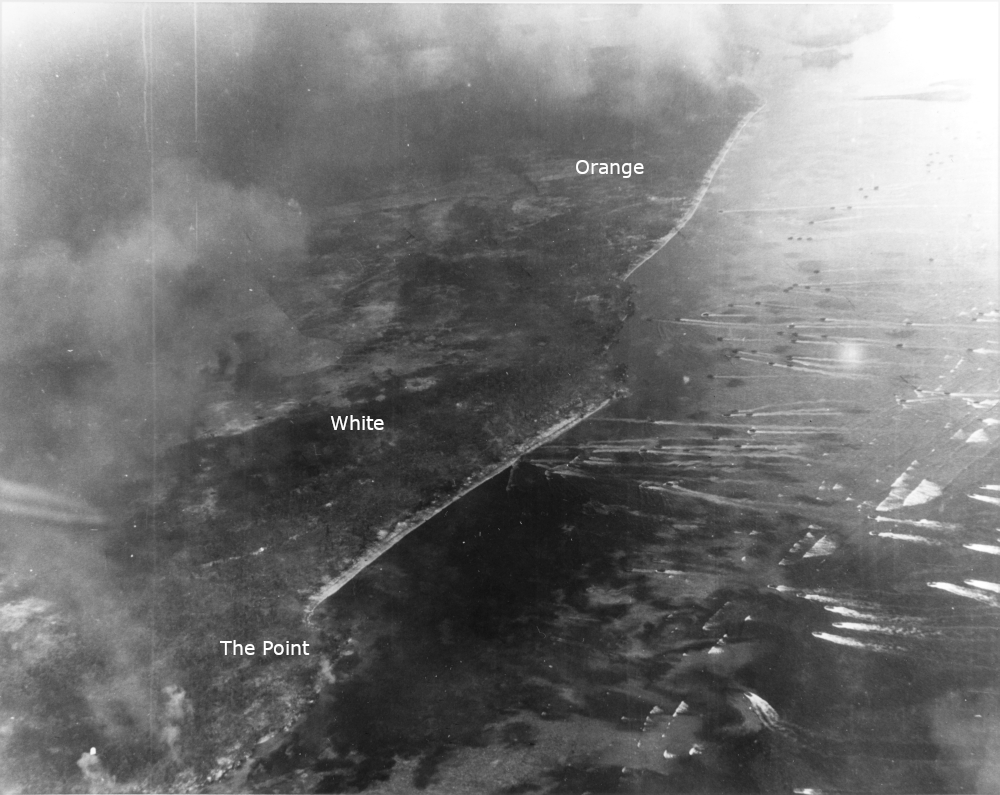
A 3/5 Marine, who was in one the first assault waves, described the experience twenty years later:
Into the ship’s hold we descended to find the amphibian tractors waiting with their diesel engines roaring. The sound was deafening. The smell of the acrid fumes was sickening. The noise of the engines, men and equipment reverberated off the steel hull. We huddled, thirty-six men and a 37mm field piece to a tractor, waiting for the bow doors to open. Suddenly, the doors opened wide letting the dawn’s light shed on us. Out the bay doors poured the ‘Alligators,’ which was a nickname for the amphibian tractors. One after another they splashed into the sea and, in full throttle, left the LST behind in its wake. I couldn’t give you a count on the amount as I was not in a position to look over the bulkhead of the tractor I was in. We were jammed elbow to elbow. Not to mention the rise and fall in the waves.
It seemed as if the ‘Alligators’ were like rubber balls bobbing up and down in the ocean swells. As we rode up one crest I caught a glimpse of several sailors on board the LST drinking from coffee mugs and watching us depart. I thought, then, maybe I was in the wrong service. But looking at the faces of my buddies around me, I had mixed emotions. We had come so far together. I knew them. And to see their expressions of concern for themselves and each other, I was proud to be alongside of these men. Some were dead serious with furrows across their brows. Some were laughing and nervously joking. However, if the tractor made an uncommonly groan or hit a high peak of an underwater coral reef, the look of borderline panic would flush their faces.
The amphibians began to circle and gradually drawing closer to the island. The beach master was organizing the numerical order of the tractors for the different waves to land and follow the battle plan. The 1st Marines was to land on our left. While the 7th [Marines] would be on our right. The 5th [Marines] would head straight, hitting Orange Beach 2. The beach was a little stretch of white sand with a backdrop of solid black smoke hiding the silhouette of tropical terrain of trees and mountains.
Off in the distance a flag is waved and the amphibians turn their course toward the shore. Some 500 yards off shore were a line of LCIs launching 12,000 rockets onto the beach. The great battleships on the horizon are, also, firing away at the island. Someone in the outfit notices the tractor is fifteen yards in front of the main wave. Which brings about a chorus of ‘Slow down! You’re going too fast.’ Nervous laughter.
There comes the sound of grating sand and coral from the bottom of the tractor. The rear door drops down and we exit. One after another we step out, turn to the right or left to run toward the beach…
Source: Peleliu 1944 - The Forgotten Corner of HellA young private first class who had joined the Division at Pavuvu describes the landing:
It was very calm and I thought what a nice ride this is, going along so slowly, able to look at everything around. I watched the planes mainly. I'd never seen rockets before. I began to say "Whooosh, whooosh," as the planes let off their rockets, and before I knew it we were running alongside an LCI, and it stopped and sent off a terrific rocket barrage. I was really surprised. I didn't even know they had rocket ships.
About then we hit the reef and bounced. I really thought we were all going out. Before we got across, the amtrac stalled, and I began to see shells land around us and hear bullets pass overhead and all the fellas began to yell, "Back it off, back it off," and we finally got off and then I began to look at the beach right ahead of us. And the lieutenant began to yell at us to keep our heads down but he put his head up too. One of the amtrac men got shot through the head about then.
I saw the smoke rise off the beach and it got plainer, and I though that they were lifting the fire and it must be about time for us to go in. I remember looking at one place where no amtracs seemed headed and I began to worry like hell about that. "What's this," I said to myself, "isn't anybody gonna land there? Something's fouled up." We were the first wave of troops.
Just then somebody yelled "Hold on!" and we hit and I thought the amtrac was going over backwards. We hung there for a minute at a terrific angle and then she ground on. I was in the back corner and this amtrac had a rear ramp. They opened the doors before she stopped.
The lieutenant went out first and I stumbled over him and landed in a big pile of debris.
It may seem silly now but my idea had been that the Japs would be right there waiting for us when we stepped out of the amtrac. So did lots of other fellas. When I fell over the lieutenant, I knew for sure that the Japs were there. That they had killed him the minute he stepped out.
Then he got up and moved over and I stayed down behind a log and looked around. I couldn't see any Japs, and then I felt very good. That boat ride was over. Now it was me.
That "me" is a very big thing. I was down there behind that log, and I was on solid ground, and there was me now to take care of "me".
Source: THE OLD BREED: A History of the First Marine Division In World War II3rd Battalion, 1st Marines (3/1), landing on Beach White 1, were the first to hit the shore 0832hrs. They were immediately joined on their right by 2/1. Within the next 4 minutes, Marines were ashore on all five landing beaches.
Although taking casualties, 2/1 was able to proceed inland through heavy woods, take up a position on the other side of the woods facing the airfield, and tie up with the 5th Marines on their right flank. The situation for 3/1 proved much more challenging. Their advance was short-lived as they encountered stubborn opposition from Japanese small arms, artillery, and mortar fire coming from a rugged coral ridge honeycombed with caves and firing positions setup by the Japanese. This ridge was "The Point" that Colonel Puller had been so concerned about during the pre-invasion bombardment phase and would prove to be the most difficult and disastrous encounter of the landing operation.
In attempting to storm the northern portion of the ridge, 3/1 found themselves trapped in a deep anti-tank ditch and were pinned down for hours under enfilading fire from the ridge above them. Tank support and personnel reinforcements only resulted in a small foothold gained on the southern portion of the point. Complicating the situation was a lack of awareness by the 1st's command group which had lost communications equipment when they were hit while crossing the reef toward the beach.
After receiving more reinforcements from units in the area and eight more hours of fierce fighting, 3/1's situation had not improved enough to preclude a Japanese attack through their lines that could sweep down the now congested landing beaches. Fortunately, the Japanese strategy of defense-in-depth did not call for such a banzai charge.
A decision was finally made to abandon the frontal assault and pursue an attack on the Point from the rear. The assault was to be lead by Captain George P. Hunt, Company K commander. The force fought their way inland for nearly two hours in the course of eliminating the enemy infantry protecting the dug-in defensive positions. Their effort was ultimately successful through several heroic acts culminating in a huge explosion that destroyed the reinforced concrete installation housing the 25mm automatic cannon that had been raking the beach assaults. However, having fought their way on to high ground from where they could attack the Japanese defensive positions from above and behind, Captain Hunt and his 30 remaining men were now isolated on that high ground and, for the next 30 hours, came under attack from Japanese infiltrators.
After having observed the lack of progress on D-Day from aboard the USS Du Page (APA-41), particularly with regard to 3/1's situation, General Rupertus made the decision to come ashore on D+1. The General and his staff landed at 0950hrs and took over direction of operations from a command post that had been setup in a large anti-tank ditch just inland of Orange Beach 2. Upon his arrival, 2/7 (the division reserve) was transferred to support Colonel Puller's 1st Marines bogged down on The Point. After bitter fighting Marine infantry supported by tanks captured a portion of the ridge and Company B was able to make contact with Hunt's Company K and help to beat off a concerted Japanese counter-attack during the night of D+1, freeing up was left of Company K.
When finally relieved, Hunt was left with only 18 men to defend The Point, and Company K, down to only 78 of its initial 235 Marines, was ordered to the rear in reserve. Captain Hunt later received the Navy Cross for his leadership during this action.
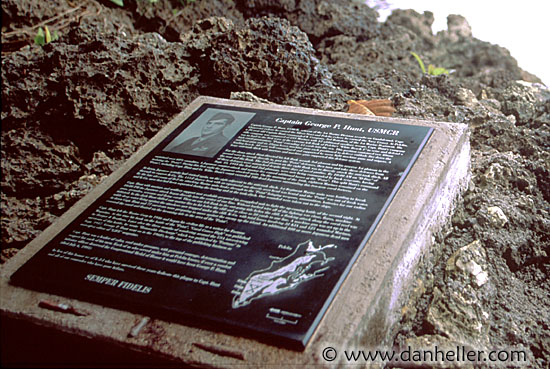
In the center of the assault wave the 5th Marines, facing enemy fire that was not as intense as was encountered by the 1st, landed 1/5 on Orange Beach 1 and 3/5 on Orange Beach 2. 1/5 was able to progress with only scattered resistance to their initial (0-1) phase line and hook up with 2/1. Here their progress was halted due to the difficulties the 1st was dealing with on their left and the intense enemy mortar fire which swept the airfield to their front.
At approximately 1650hrs, the line established by 2/1 and 1/5 across the western edge of the airfield was subjected to a tank-infantry counter-attack:
Increase in Japanese artillery and mortar fire in that area was the first indication that something was brewing. Soon after Japanese infantry was observed advancing across the airfield, not as a fanatical, drunken banzai charge but as a coolly disciplined advance of veteran infantrymen. A Navy air observer spotted Japanese tanks forming east of the ridges above the airfield with more infantry riding on them. These tanks moved forward, passing through the Japanese infantry advancing across the airfield and some 400 yards in front of the Marine lines. For a moment, but only for a moment, the Japanese counter-attack looked like a serious coordinated movement. Then the formation went to pieces. Inexplicably, the Japanese tank drivers opened their throttles wide and raced towards the Marine lines. Charging like the proverbial “Bats outa Hell,” with the few infantry atop the tank clinging on for dear life, they left their accompanying infantry foot support far behind.
No positive account exists of what happened thereafter. The tanks involved in the charge numbered between 13 and 17 (insufficient pieces were left afterwards to give a definite count) and headed for the Marine lines, cutting diagonally across the front of 2/1, who subjected them to murderous flanking fire from all weapons, small arms, light and heavy machine guns, 37mm antitank guns and artillery. Two of the Japanese tanks veered off into the lines of 2/1, hurtling over a coral embankment and crashing into a swamp, the escaping crews were quickly disposed of by the Marines.
Meantime, the remaining tanks came under heavy fire from the marines of 1/5, while the advancing Japanese infantry was subjected to fire and bombing from a passing Navy dive bomber
The tanks and their riding infantry were decimated as they passed right through the Marine lines which simply closed behind them. Exactly who knocked out what is, to this day, a mystery. Only two of the Japanese tanks escaped the massacre, although if all confirmed hits were taken into account the Japanese tank force must have numbered some 180 tanks!
As for the Japanese infantry, when the Marines looked back after the tanks had broken through their lines, the Japanese infantry was nowhere in sight. Whether they had been annihilated by the devastating Marine fire or whether they withdrew after seeing their tank support being decimated remains conjecture but the counterattack was over. It is doubtful we shall ever learn the definitive answer.
Source: Peleliu 1944 - The Forgotten Corner of Hell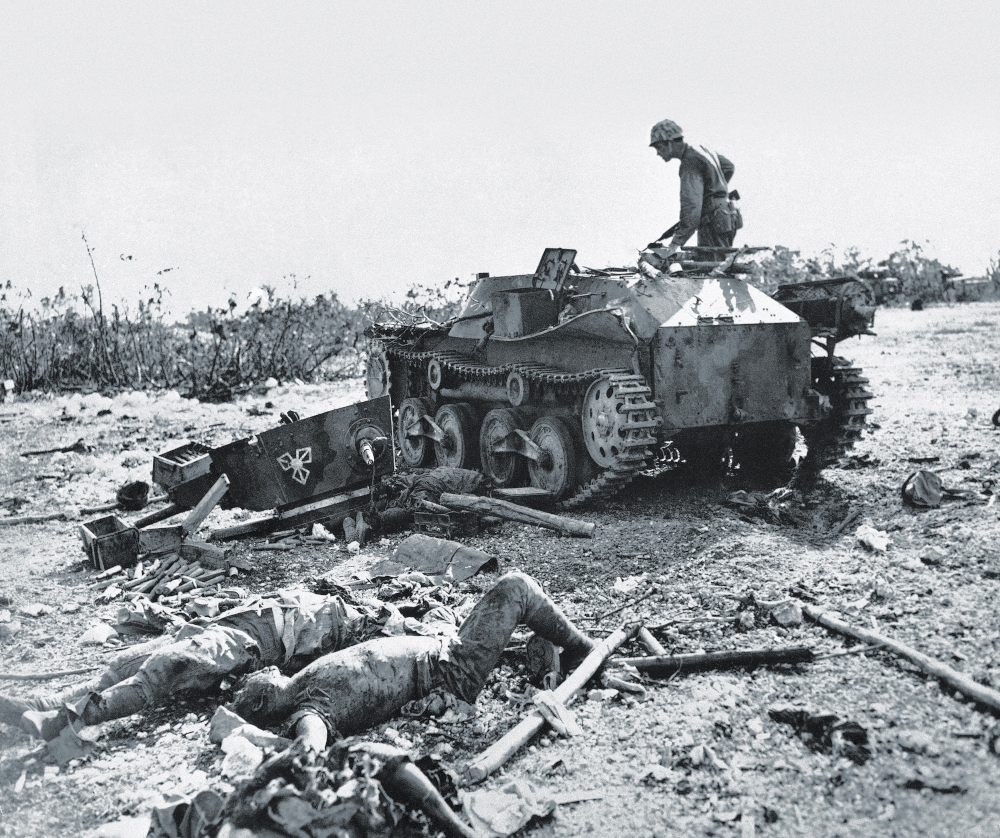
3/5's situation was complicated by the destruction of the LVT carrying their communications equipment and personnel on the reef on the way to the beach, and enemy fire causing the loss of their executive officer minutes after the landing. These losses combined with dense sight-limiting shrubbery, inadequate mapping, further loss of command personnel, and elements of the 7th Marines landing on Orange Beach 2 instead of their intended Orange Beach 3, caused communication and coordination problems throughout the day (at one point elements of 3/5 had advanced 300 to 400 yards ahead of the 7th Marines on their right such that the 7th was unknowingly firing on 3/5 troops).
To address this confusion, executive officer of the 5th Marines, Lieutenant Colonel Lewis W. Walt (the same Lewis Walt who lead the attack on Aogiri ridge at Cape Gloucester), assumed the command of 3/5 and spent the evening and into the night locating the involved units and coordinating between them in order to form a defensive configuration adequate to counter any late-night Japanese attacks.
On the extreme right of the 5th, two battalions of the 7th Marines, in company with units of the 11th Marines, were to land on Orange Beach 3. The initial landing was to be made by 3/7 with 1/7 following in column behind. However, because the reef was cluttered with natural and man-made obstacles, their progress was slowed, making them more subject to anti-boat fire coming from nearby Ngarmoked Island as well as heavy artillery and mortar fire from Japanese positions inland. The incoming fire caused two amtrac drivers to veer off to the left and land on Orange Beach 2 instead of Orange Beach 3, mingling with 3/5 and causing the confusion alluded to above. Elements of 3/5 continued to push inland, reaching the southern edge of the airfield by the end of the day.
Meanwhile, the slowdown and confusion contributed to delaying the movement of the 11th Marines' artillery onto the beach.
To the men of 3/5’s rifle companies edging their way inland from Orange Beach 2, the big stuff fired by the enemy seemed less intimidating as the afternoon wore on. Their senses had adjusted somewhat to the continuous hiss and roar of shells, most of which were hitting further away. But it was a different story for the artillerymen of the Eleventh Marines, who were just now coming ashore. To PFC James Mason, the beach area that the infantry had left behind could hardly have presented a more hellish scene as his amtrack approached it shortly after 2:00 P.M.
“I can still close my eyes and see the whole damned thing in front of me,” Mason recalled nearly sixty years later. “The first thing I saw was one of those amphibious trucks called ducks take a direct hit from a heavy mortar. Just a couple of seconds later, another amtrack moving along the beach hit a mine and blew sky-high. My impression was that everything was hitting the fan—and that I was about to be in a helluva lot of trouble.”
Source: Brotherhood of Heroes - The Marines at Peleliu, 1944 - The Bloodiest Battle of the Pacific WarUpon landing, 3/11 and 4/11 discovered that their designated firing positions were still in the hands of the Japanese. 4/11 managed to occupy makeshift positions near the southern end of Orange Beach 3 and one battery of 3/11 managed to set up on Orange Beach 1. However:
Because of heavy enemy fire and their inability to find suitable operating positions, the two remaining batteries of the 3rd Bn were ordered to reembark on LST's for the night. Three of the DUKW's had been so seriously damaged during this double reef crossing that they sank upon reaching deep water, taking the guns and other gear with them. What remained of the two batteries came in again the following day, but another of the 105's was knocked out by enemy fire that evening. The eight remaining performed their mission satisfactorily from that point on.
Source: The Assault on PeleliuAs discussed above, Corporal Moore's initial MOS when his battalion was designated 5/11 at Cape Gloucester, was Field Telephone Man assigned to "H&S Battery, 5th Battalion, 11th Marines, 1st Marine Division, FMF". His primary MOS at the end of his service was Field Artillery Fire Control Man so it is very likely that, when 5/11 was re-designated 3/11 prior to Peleliu, he was re-assigned to a 3/11 battery. My only evidence as to which battery he was assigned to is in a letter from the USMC to Corporal Moore's sister Thelma dated 9 Nov 1944 (Figure 64). That letter indicates that he was still assigned to the H&S Battery in 3/11. His discharge certificate indicates that his participation in the Peleliu battle began on September 16, 1944 (D+1) so it is likely the H&S Battery was one of those forced to turn back on D-day and make their landing on D+1.

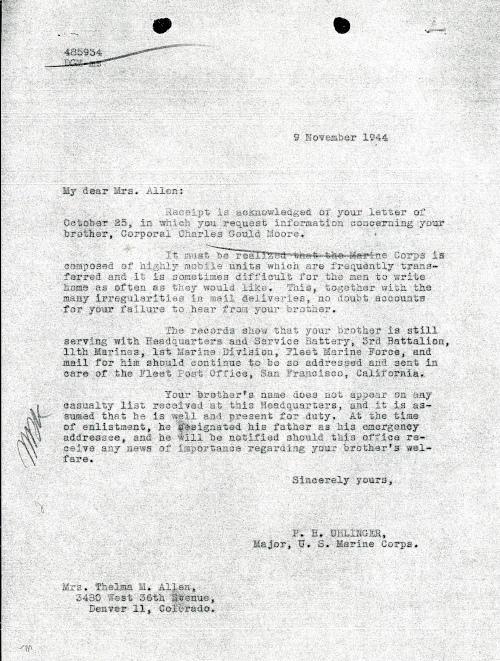
As planned, after landing with little initial opposition, 1/7 wheeled right and began their drive toward the southern end of the island. In the course of encountering increased Japanese resistance, their progress was slowed by the presence of an unmapped dense swamp with the only trail around it heavily defended. It took them until late in the afternoon to reach their D-Day objective line. That night the enemy mounted a strong counter-attack which was defeated with the aid of Black Marine shore-party personnel who volunteered as riflemen.

On the morning of the the second day (D+1) the 7th Marines began an advance to the east and the south. The remainder of Corporal Moore's unit, 3/11, having lost a battery in their attempt to land in-company with the 7th on D-Day, successfully got ashore on D+1. By mid-morning, slowed by Japanese casements, blockhouses, bunkers, and pillboxes, 1/7 and 3/7 were able to fight their way south and east. In addition to fierce Japanese resistance, progress was slowed by the oppressive heat (over 100 deg F) and humidity of the Peleliu environment. Cases of dehydration were exacerbated when recycled drums used to convey water supplies were found to be contaminated by residual aviation fuel.
At the end of the day, 1/7 and 3/7 occupied a line at the southern end of Peleliu just north of the "SE Promontory" and the "SW Promontory" (sometimes called Ngarmoked Island) (Figure 66).There they dug-in to oppose possible Japanese counter-landings from Koror or Babelthaup, bring up supplies and equipment, and clear mines planted on the beach. It is likely that by this time all remaining 3/11 batteries had landed and were able to join up with the 7th units.

The original objective for 3/11 was to land with the 7th and setup and register their artillery to "be prepared to concentrate their fires on the southwest end of the Umurbrogol Mountains". This changed when 1/7 and 3/7 encountered significant opposition against their advance to capture the southern portion of the island. Instead, 3/11 provided what amounted to point-blank fire in support of the 7th's progress southward.
The morning of D+2 saw the 7th Marines continuing their push further south. 3/7's assault on the SE Promontory was initially delayed for two hours when another minefield had to be cleared. Then, accompanied by an artillery (3/11) and mortar barrage, and by three medium tanks, in the course of fierce fighting, the entire promontory was taken by 1320hrs.
The SW Promontory, much larger than the SE Promontory, presented stiff resistance to 1/7's advance. Progress was halted while tanks and armored amtracs were brought up and artillery (3/11) pounded the Japanese defenses. By nightfall, half of the promontory was in Marine hands.
The next morning, bolstered by additional tanks and 75mm gun-mounted half-tracks brought up during the night, 1/7 resumed the advance. By 1344hrs two companies had reached the southern shore but a third company (Company B) was still encountering fierce opposition. Progress was stopped when supporting tanks were withdrawn and a bulldozer was brought up to free bogged-down half-tracks.
As the company waited, significant sounds to its front indicated that at last the Japanese had decided to cooperate - by blowing out their brains. Many others leaped into the sea. When the final position was taken shortly afterward, 15 or 16 of these die-hards were found to be officers.
So far as the southern part of the island was concerned, the fighting was over, save for the inevitable mopping-up. A fine Japanese reinforced infantry battalion, in strongly fortified positions, had been sent to join its ancestors. As the two Marine assault battalions straightened themselves out and squared away for a little well earned rest, the regimental command Notified Division Headquarters optimistically: "At 1520, 0-1 was taken. The Seventh Marines Mission on Peleliu is completed."
Source: The Assault on PeleliuGiven that Corporal Moore's 3/11 was in-company with the Seventh Marines and providing artillery support throughout their mission, it is probable that they were on or in close proximity to the SW/SE promontories on the evening of D+2. However, as alluded to in the quote above, the 7th's role on Peleliu was far from over.
While the 7th was securing the south on D+1, 1/5 was the expanding their gains inland by sweeping across the the northern portion of the airfield and, after heavy fighting, capturing the hanger area. To their right, 2/5 was making slow progress eastward through woods and swamps against stiff Japanese resistance. After attacking numerous enemy emplacements requiring hand-to-hand fighting, 2/5 was alongside and tied in with 1/5 by nightfall. 3/5's advance, effectively pinched out by 2/5 on its left and the 7th Marines on its right, was relegated to shoreline security and support of 2/5 and 3/7 where needed.
By mid-morning on D+2, 1/5 had reached its objective of capturing the airfield and held in place until relieved by 3/5. 3/5 tried to resume the advance northward but was immediately pinned down by flanking fire on its left. On 3/5's right, 2/5 was able to make better progress being concealed in the woods from Japanese artillery. By evening 2/5 was tied in with 3/5 on its left and the shoreline on its right. On D+3 the 5th Marine units began slow but continuous progress northward up the eastern portion of the island. By D+8, after encountering intermittent enemy resistance and misplaced friendly fire (resulting in 34 casualties), 2/5 and 3/5 had captured the entire northeastern peninsula and associated islands.
One result from the first two days of combat was a recognition by the Marines that the Japanese counterattacks were not the kinds of frenzied "banzai" attacks experienced on Guadalcanal. Rather they were more coordinated and disciplined small-scale operations intended to harass and lure Marines into tactical errors that would make them more vulnerable to entrenched enemy defenses. They were a precursor to the prolonged arduous siege-like campaign they would be forced to undertake in the Umurbrogol Mountains.
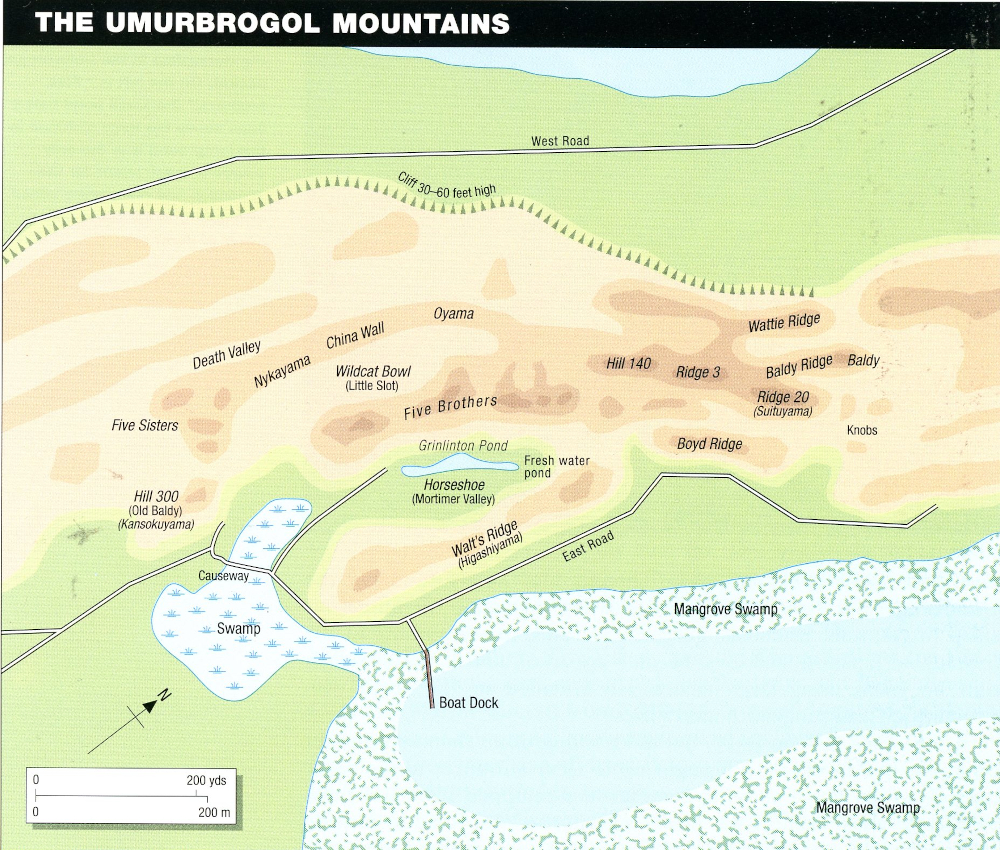
Nothing better illustrated the tactical dilemmas posed by Umurbrogol than did the 19 September seizure of, then withdrawal from Hill 100, a ridge bordering the so-called Horseshoe Valley at the eastern limit of the Pocket. It lay in the sector of Lieutenant Colonel Honsowetz' 2d Battalion, 1st Marines, to which Company B of Major Ray Davis' 1st Battalion was attached. Company B, 1/1, having landed with 242 men, had 90 men left when its commander, Captain Everett P. Pope, received Honsowetz' order to take what the Marines were then calling Hill 100. The Japanese called it Higashiyama (East Mountain).
Initially supported by tanks, Pope's company lost that support when the two leading tanks slipped off an approach causeway. Continuing with only mortar support, and into the face of heavy defending mortar and machine-gun fire, Pope's Marines reached the summit near twilight, only to discover that the ridge's northeast extension led to still higher ground, from which its defenders were pouring fire upon the contested Hill 100.
Equally threatening was fire from the enemy caves inside the parallel ridge to the west, called Five Brothers. In the settling darkness Pope's men, liberally supported by 2/1's heavy mortars, were able to hang on. Throughout the night, there was a series of enemy probes and counterattacks onto the ridge top. They were beaten off by the supporting mortars and by hand-to-hand brawls involving not only rifles but also knives, and even rocks, thrown intermittently with grenades, as supplies of them ran low.
Pope's men were still clinging to the ridge top when dawn broke; but the number of unwounded Marines was by now down to eight. Pope was ordered to withdraw and was able to take his wounded out. But the dead he had to leave on the ridge, not to be recovered until 3 October, when the ridge was finally recaptured for good. This action was illustrative and prophetic of the Japanese defenders' skillful use of mutually supporting positions throughout Umurbrogol.
Source: Bloody Beaches: The Marines at PeleliuPELELIU STILL UNDER CONSTRUCTION ... ![]()
Sources of Information
- Source: WITH THE OLD BREED at Peleliu and Okinawa
- Source: MARINES: The Offical Website of the United States Marine Corps
- Source: THE OLD BREED: A History of the First Marine Division In World War II
- Source: National Personnel Records Center in St Louis MO.
- Source: Birth of the US Marine Corps
- Source: A Brief History of the 11th Marines
- Source: Wikipedia - Battle of Guadalcanal order of battle
- Source: Wikipedia - Guadalcanal Campaign
- Source: Wikipedia - 3rd Battalion, 11th Marines
- Source: Marine Corps Ground Training in WWII
- Source: MARINES: Marine Corps Forces Reserve
- Source: War II US Marine Corps occupational specialty codes
- Source: National Archives
- Source: Wikipedia: Battle of Arawe
- Source: Wikipedia: Headquarters and Service Company
- Source: The Campaign on New Britain
- Source: MARINES: 1st Marine Division
- Source: Wikipedia - 1st Advance Base Brigade
- Source: Wikipedia: Landing Ship, Tank
- Source: Naval Air Station, Anacostia
- Source: The National WWII Museum
- Source: San Diego Air and Space Museum: Image Collection
- Source: Cape Gloucester: The Green Inferno
- Source: Wikimedia: Battle of Cape Gloucester
- Source: Isolation of Rabaul
- Source: World War Photos
- Source: National Museum of the U.S. Navy
- Source: Pacific Warriors: The U.S. Marines in World War II - A Pictorial Tribute
- Source: Wikimedia Commons - Battle of New Britain
- Source: Flickr: John S. Day, Sr. Collection
- Source: U.S. Naval Institute - Waging War in a Rain Forest
- Source: U.S. Naval Institute - No Pacific Paradise
- Source: USS Elmore (APA-42)
- Source: NavSource Online: Amphibious Photo Archive
- Source: The Assault on Peleliu
- Source: Peleliu 1944 - The Forgotten Corner of Hell
- Source: Brotherhood of Heroes - The Marines at Peleliu, 1944 - The Bloodiest Battle of the Pacific War
- Source: Japanese Military Caves on Peleliu: Know Your Enemy!
- Source: The Warfare History Network - The Battle of Peleliu: Shocked Beyond Imagination
- Source: Naval History and Heritage Command
- Source: Bloody Beaches: The Marines at Peleliu
- Source: THE WAR - A Ken Burns Film
- Source: HistoryNet


_small.jpg)
.jpg)
.jpg)
.jpg)
.jpg)
.jpg)
.jpg)
.jpg)
.jpg)
.jpg)
.jpg)
.jpg)
.jpg)
.jpg)
.jpg)
.jpg)
.jpg)
.jpg)
.jpg)
.jpg)
.jpg)
.jpg)
.jpg)
.jpg)
.jpg)
.jpg)
.jpg)
.jpg)
.jpg)
.jpg)
.jpg)
.jpg)
.jpg)
.jpg)
.jpg)
.jpg)
.jpg)
.jpg)
